


Kiran Kulkarni is the Partner & Marketing Head at ThunderClap, leading the agency's brand strategy and content initiatives. With a deep expertise in writing, marketing, and digital storytelling, she crafts narratives that elevate brands and drive measurable growth. At ThunderClap, Kiran merges creative vision with data-driven insights to deliver impactful marketing strategies.
Blogs by Kiran

10 Best Landing Page Designs in 2025 (With Takeaways You Can Use)
Here’s the hard truth: in 2025, your ads don’t win. Your content doesn’t win. Your targeting doesn’t win. Your landing page wins.
Why? Because it’s the one place where all your effort and spending converge (and where most brands lose the customer). You’ve paid for the click, grabbed attention for a few fleeting seconds… and if your landing page isn’t designed to convert, it’s game over.
We’ve worked on 129+ B2B websites like Amazon, Razorpay, and Factors. The difference between a good landing page and a great one isn’t subtle. It’s the difference between campaigns that bleed budget and campaigns that compound growth. That’s why we’re not here to show you a bunch of pretty pages. We’re here to break down the 10 best landing page designs in 2025, explain what makes them work, and give you takeaways you can put into practice right now.
Think of this as your landing page design inspiration playbook: part strategy, part teardown, and part checklist. By the end, you’ll know exactly how to evaluate your own pages and how to design landing experiences that don’t just look good, but actually drive conversions.
The CLEAR framework: how we evaluate landing pages
Before we dive into the best landing page design examples, let’s set the lens. A good landing page in 2025 isn’t defined by clever copy or slick design alone. You have to put all the pieces together to convert.
That’s why we use the CLEAR framework at ThunderClap for website and landing page revamps:
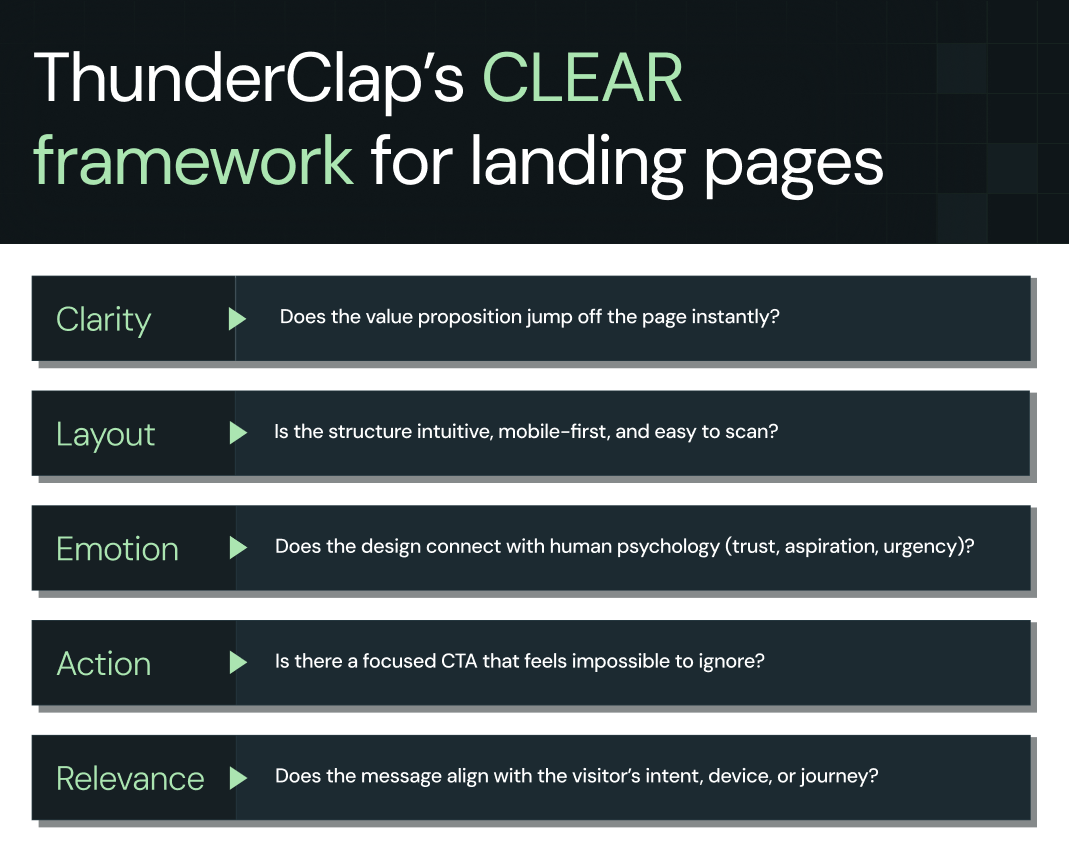
Every high-converting landing page we review below nails these elements in different ways. And the good news? You can take these patterns and apply them to your own web pages today.
We recently redesigned ConsultAdd’s website using the same principles and lifted conversions by 60%. Here’s a video walkthrough of the before and after of their home page makeover:
The 10 best landing page designs in 2025 (with takeaways)
Now that we’ve set the lens with the CLEAR framework, let’s explore how today’s top brands are applying these principles in practice. We’ve curated 10 of the best landing page designs in 2025, spanning SaaS, productivity platforms, AI startups, and communication tools.
1. Storylane (a SaaS landing page where the demo is the design)
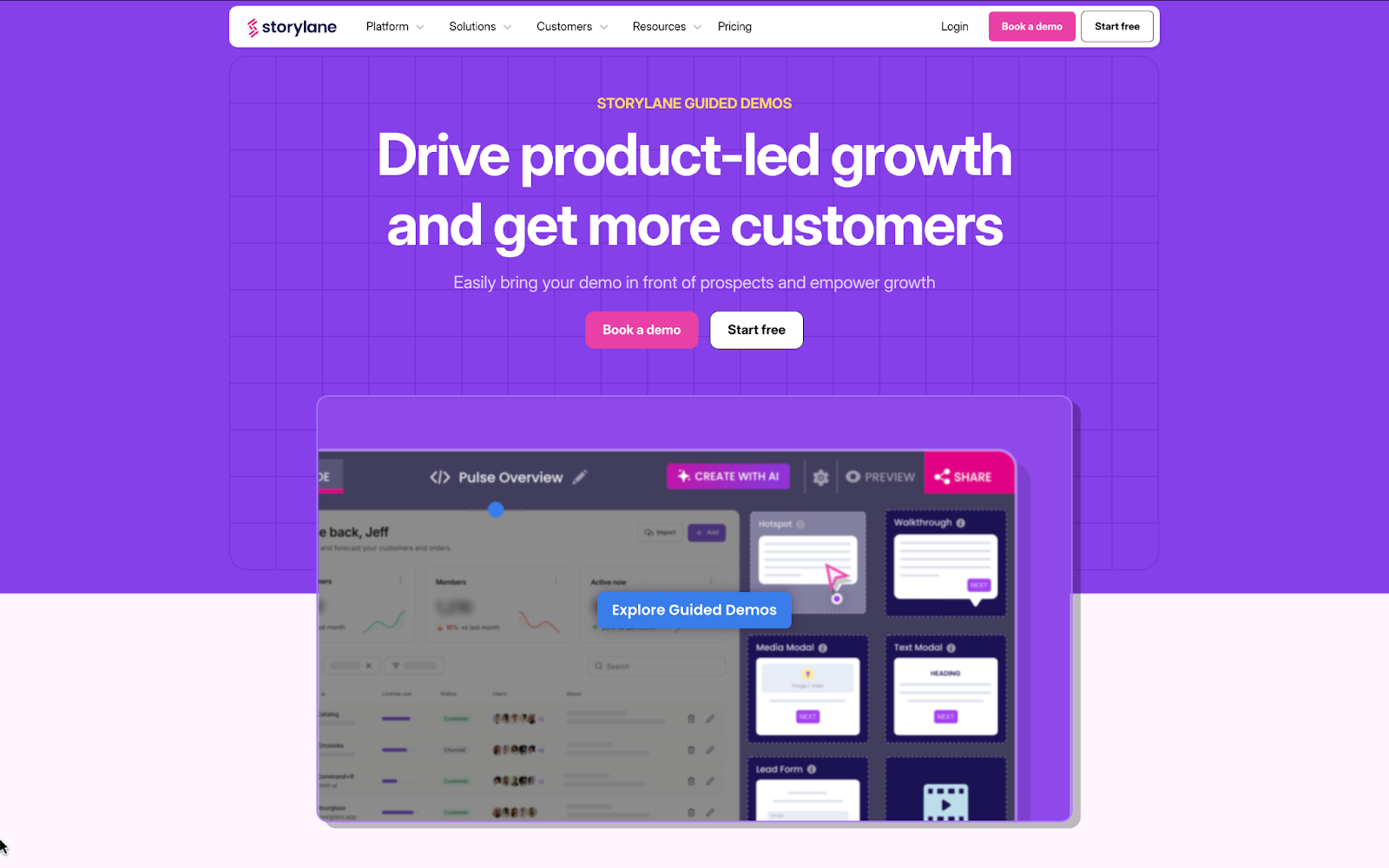
Storylane’s landing page overhaul is a masterclass in aligning design with personality. When they came to us, they had solid copy but felt their website lacked personality. Our mandate was clear: keep the words, transform the brand.
The copy stayed the same, but we changed everything around it. By introducing a bold, playful brand identity (clean fonts, a neutral base palette with pops of color, and custom illustrations), the page finally matched Storylane’s innovative positioning.
The results speak for themselves: 36% more website impressions and a 30% lift in demo requests since launch. Why? Because the design now amplifies the existing copy instead of competing with it.
The layout is modular and scannable, trust is established through logos and proof points, and the CTAs (“Get a demo”) are repeated consistently across every scroll segment.
📌 Read the full breakdown in this LinkedIn post by Kiran Kulkarni, Partner & Head of Growth at ThunderClap, including the exact design process and before/after insights.
Your takeaway from Storylane
If your product sells itself when shown, don’t bury the demo. Make it the centerpiece of your landing page and reinforce it with one clear, repeated CTA.
2. roommaster (a hospitality landing page built on trust and clarity)
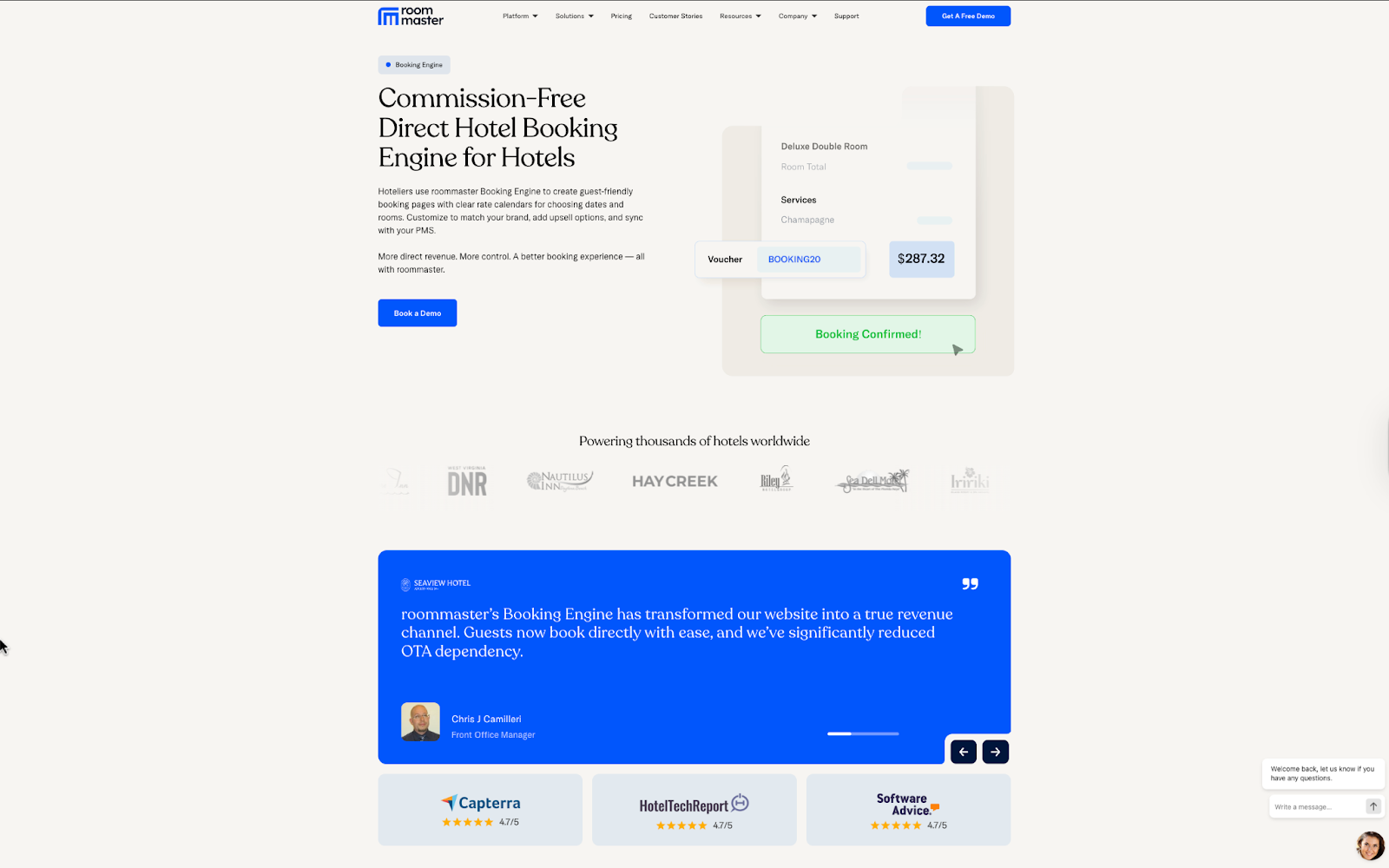
When roommaster rebranded from InnQuest, they trusted us to bring their new identity to life online. We built a landing page that makes the value proposition unmistakable: “Commission-Free Direct Hotel Booking Engine for Hotels.” Clarity is immediate, reinforced by testimonials and partner logos. We designed the layout to highlight benefits and use cases in a scannable, modular flow.
To spark emotion, we leaned on real hotel imagery, review badges, and credibility markers. For action, we kept it simple and consistent with a prominent “Get a demo” CTA. And for relevance, every section speaks directly to hoteliers who want to drive direct bookings.
Your takeaway from roommaster
Make benefits scannable. Break down key advantages into bite-sized blocks or cards that a busy reader can skim.
3. Deductive AI (a futuristic landing page example for AI startups)
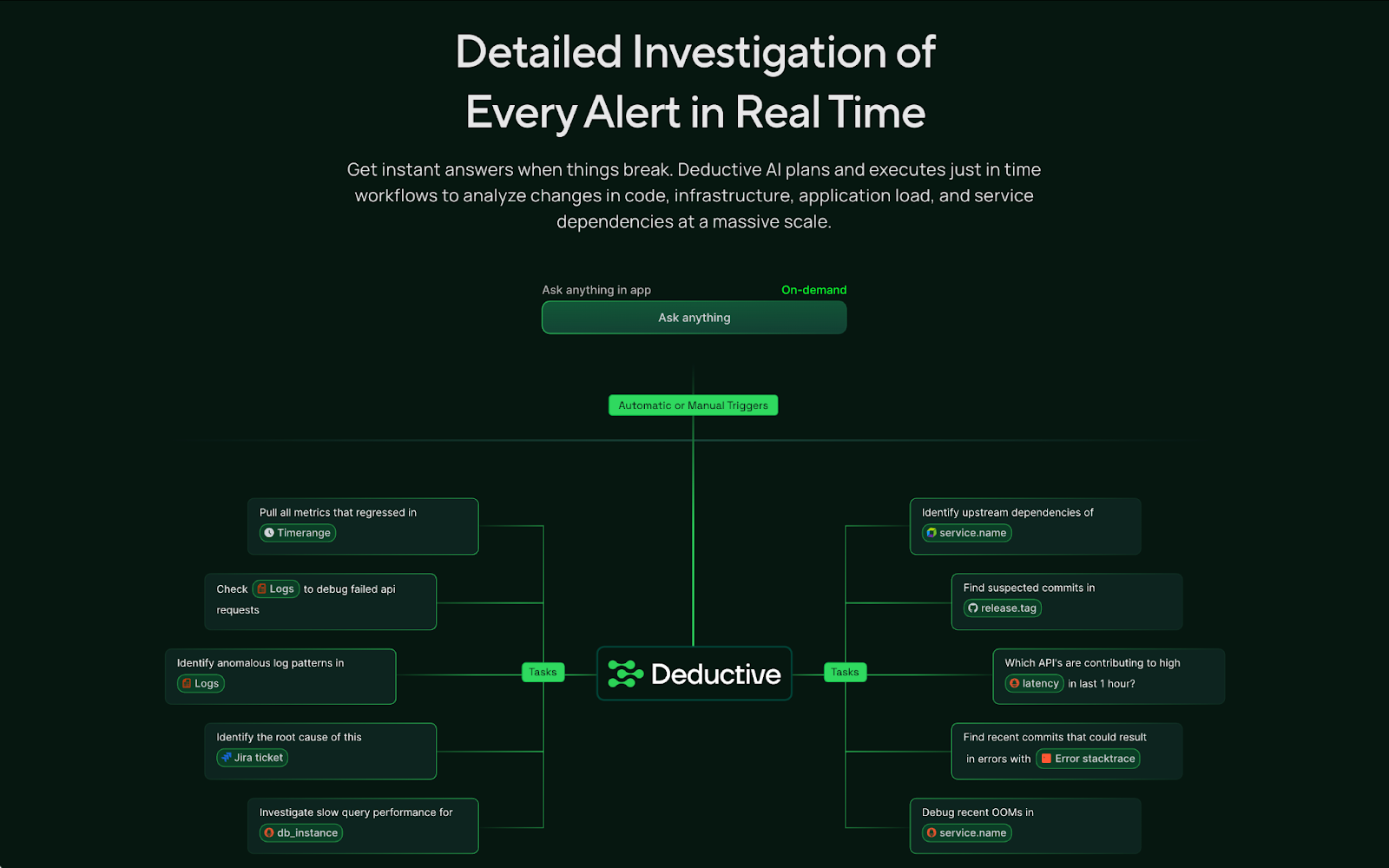
When two ex-MAANG leaders founded Deductive AI, they partnered with us to shape a bold brand identity and build a website from the ground up. We designed a dark, futuristic aesthetic to match their positioning as an “AI on-call engineer.” Clarity comes through in the concise headline and strong hero CTA.
The layout uses diagrams, flows, and modular sections to explain a complex product without overwhelming visitors. For emotion, the design leans into authority with encrypted security visuals, enterprise-grade messaging, and trusted integrations.
Action is consistent with clear CTAs (“Schedule demo”) placed across scroll depth. And in terms of relevance, every element speaks directly to technical teams who manage scale and reliability.
Your takeaway from Deductive AI
If your product is technical and complex, use visuals and modular flows to simplify the story without dumbing it down.
{{specficBlog}}
4. Factors (a B2B landing page that connects fragmented buyer signals into one story)
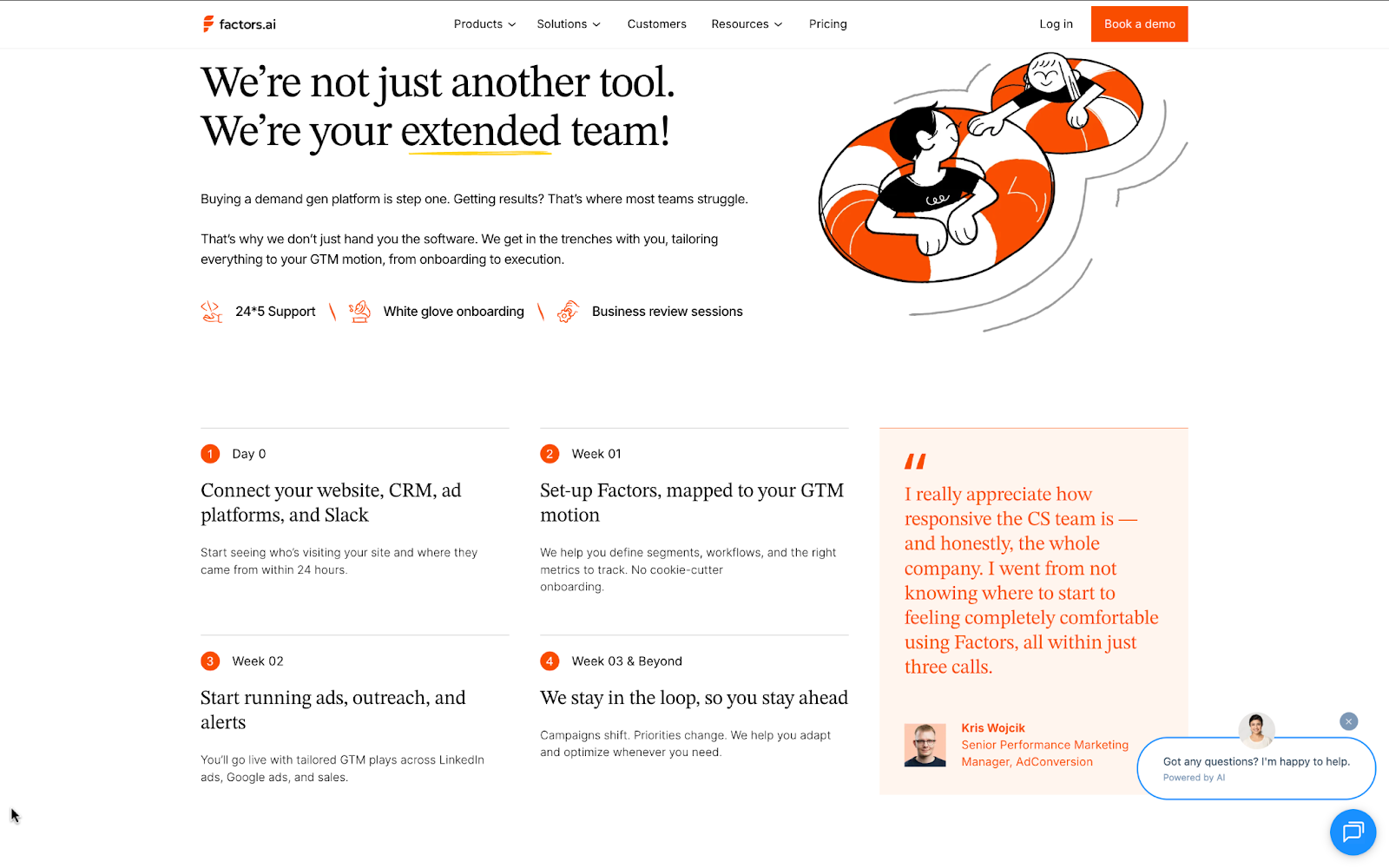
When Factors partnered with us, they wanted a landing page that could show the power of unifying scattered buyer data. We built the page to deliver clarity from the start with the headline “Know how your buyers move. Run campaigns that win.”
The layout tells a story step by step: why fragmented signals are a problem, how Factors solves it, and proof of success through testimonials and client logos. One of our favorite sections is the execution timeline section that walks visitors through the exact journey of using Factors. This narrative flow shows how insights move from messy signals to actionable campaigns in just 3 weeks (a feature most B2B pages lack).
To create emotion, we introduced bold patterns, vibrant colors, and human elements like customer quotes. Action is simple and repeated. “Get a demo” and “Learn more” CTAs guide the journey.
For relevance, enterprise-grade security badges and recognizable brands reinforce trust.
Your takeaway from Factors
If your product connects the dots, structure your landing page like a narrative (problem, solution, proof, action).
After your homepage, your pricing page is often the most visited (and most overlooked) page on your site. We analyzed 50+ SaaS pricing pages and built a blueprint with insights, a wireframe, and a checklist you can apply today.
Get the Pricing Page Blueprint
5. Mailmodo (an interactive landing page design for marketers)
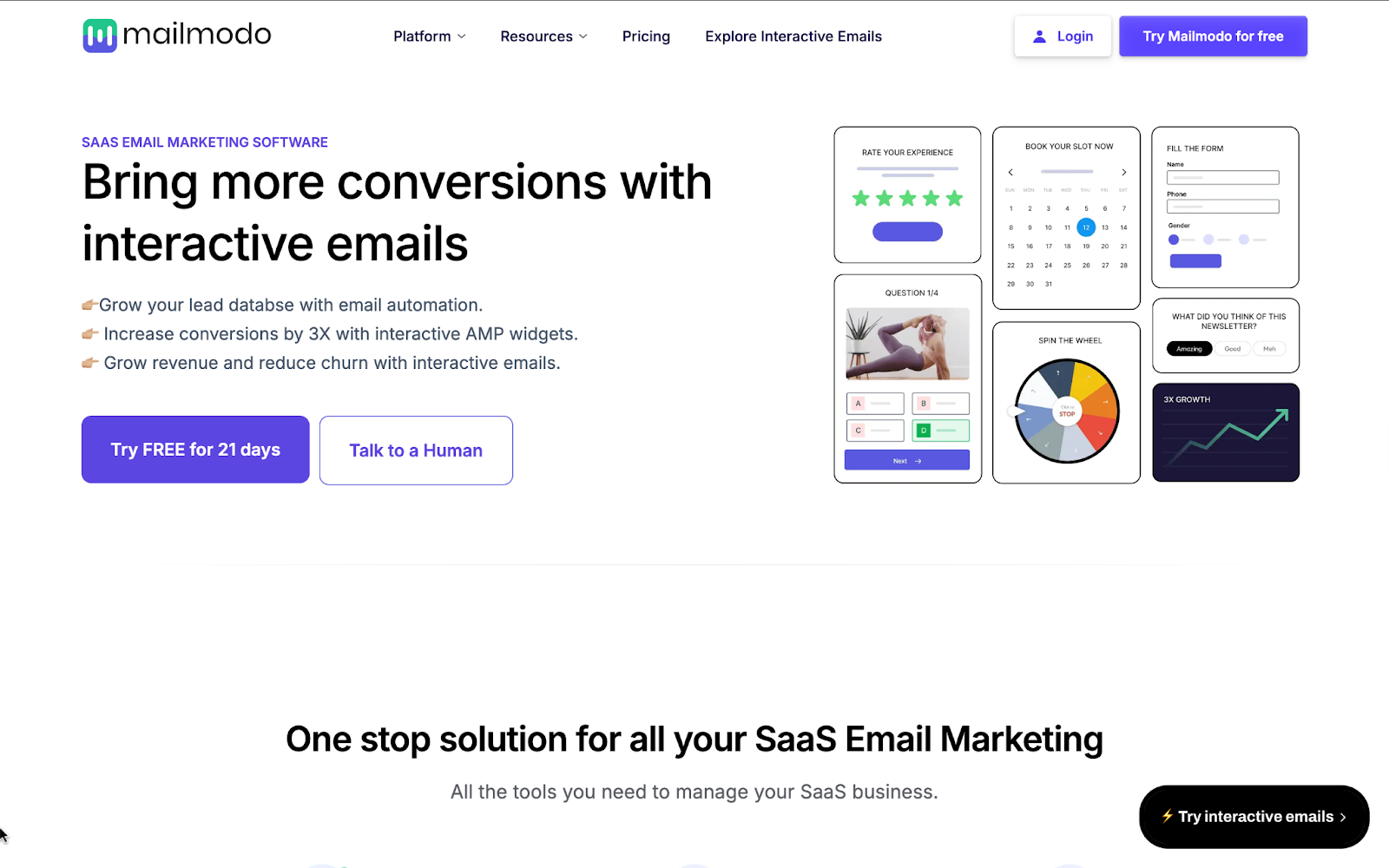
Mailmodo’s SaaS-focused landing page shows how tailoring content to a specific audience pays off. Clarity comes through the headline, “Bring more conversions with interactive emails”, followed by a subhead that positions it as “One-stop solution for SaaS email marketing.”
The layout is tailored for SaaS use cases: common flows like “user onboarding” and “feature adoption” are explained with visuals, followed by product screenshots and sample templates. Emotion is sparked through customer testimonials and logos from well-known SaaS brands, paired with ROI-focused language like “3X email conversions.”
The action is consistent with “Start free trial” CTAs at natural scroll points. Relevance shines here: every example, from integrations (HubSpot, Salesforce, Zapier) to templates, is built for SaaS teams.
Your takeaway from Mailmodo
Build dedicated landing pages for your top personas or industries, showing their flows, their integrations, and their language, creates social proof.
Also read: Decoding The Above the Folds (ATF) Of 100 SaaS Brands [Backed by research]
6. Figma (a collaborative SaaS landing page that shows, not tells)

Figma’s landing page is a design-first experience that mirrors the product itself. Clarity comes from the headline “Prompt, code, and design from first idea to final product.”
The page opens with colorful project previews that set the tone. The layout is simple and visual. Screenshots, templates, and community examples show how teams use Figma. Emotion comes from bold colors, playful shapes, and proof from big names like GitHub. The action is direct. One clear “Get started for free” CTA anchors the page.
And relevance is strong because every block speaks to designers and developers working together.
Your takeaway from Figma
Use community work as proof. Highlight templates, creations, or examples from your users to show versatility and build social validation.
7. Miro (a visual landing page example that mirrors the product)
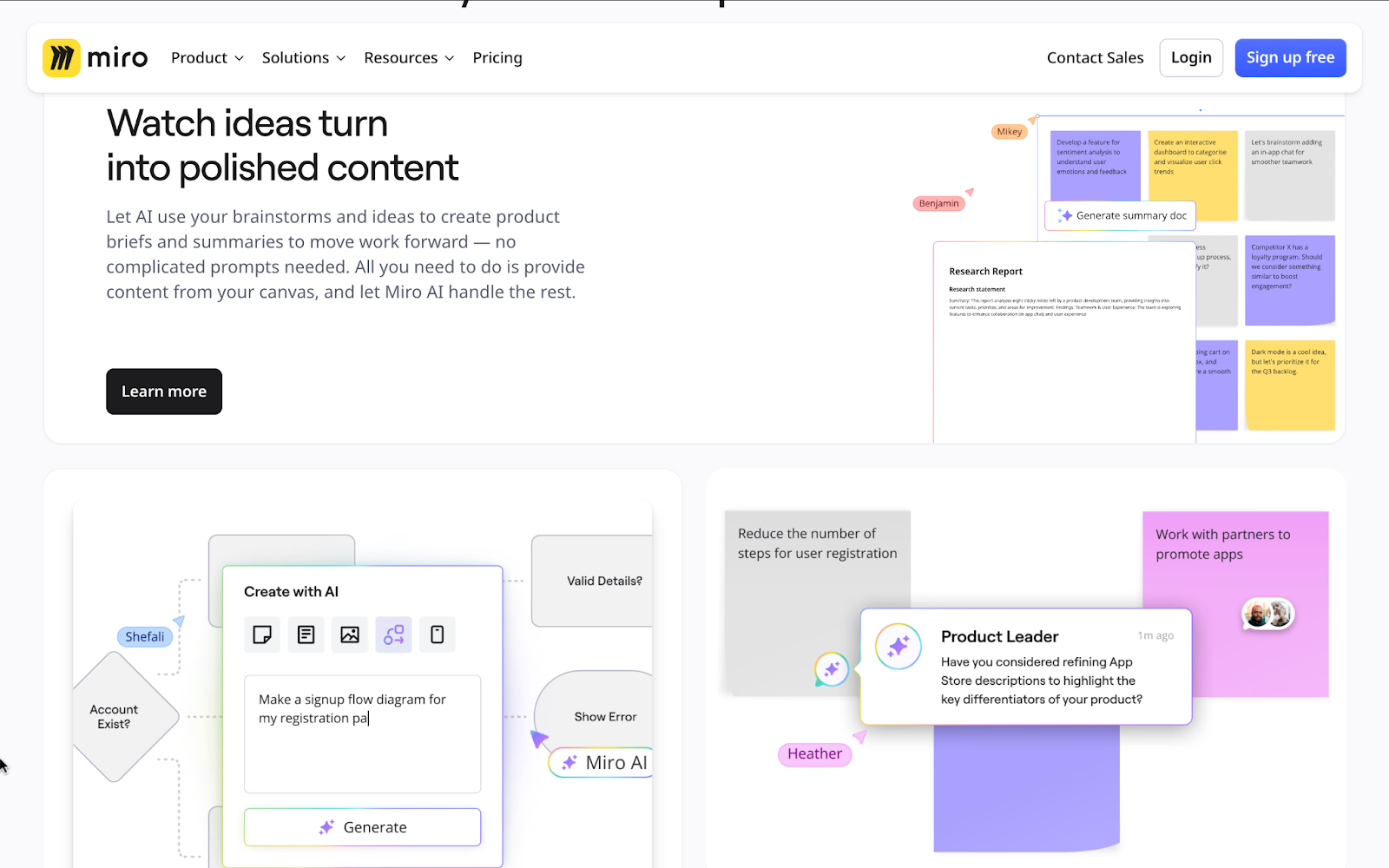
Miro takes a different route from the other pages we’ve seen. Where Figma highlights creativity and Storylane pushes demos, Miro puts collaboration at the center. Clarity comes fast: “Intelligent Canvas” plus a hero demo that shows sticky notes, flowcharts, and team comments in one place.
The layout is stacked with live-looking boards, widgets, and templates (you can almost imagine your team using it). Emotion isn’t about design flair here but togetherness. Headlines like “Collaborate as one team” and customer quotes make it feel human. Action is frictionless with “Start a demo” CTAs.
And the relevance is obvious: this page speaks to distributed teams trying to move faster together.
Your takeaway from Miro
Use templates as proof of value. Highlight ready-made templates or widgets so users know they can start fast without building from scratch.
If you run demos, use ThunderClap’s High-Converting Demo Page Playbook. We studied 30 B2B SaaS brands to identify landing page optimization strategies that leading brands employ on demo pages.
8. Loom (a video-first landing page design that builds instant connection)

Loom’s is a landing page design inspiration if you want to lead with product in action. Clarity comes from the headline “Free Screen Recorder” and the hero visual of a recording interface with a human face on screen.
The layout is straightforward: top features in a checklist, then blocks for capture, editing, sharing, and feedback. Emotion comes through people-centered visuals and playful touches like emoji feedback.
Action is simple and consistent with “Start recording” CTAs that appear throughout. And relevance is strong because the page highlights specific use cases from project proposals to market research and availability on iOS and Android.
Your takeaway from Loom
If your product is about communication, put people at the center of your visuals, not just the tool.
Also read: 20 Proven SaaS Conversion Optimization Hacks to Boost Your Sales
9. Canva (a landing page that proves speed and scale with templates)
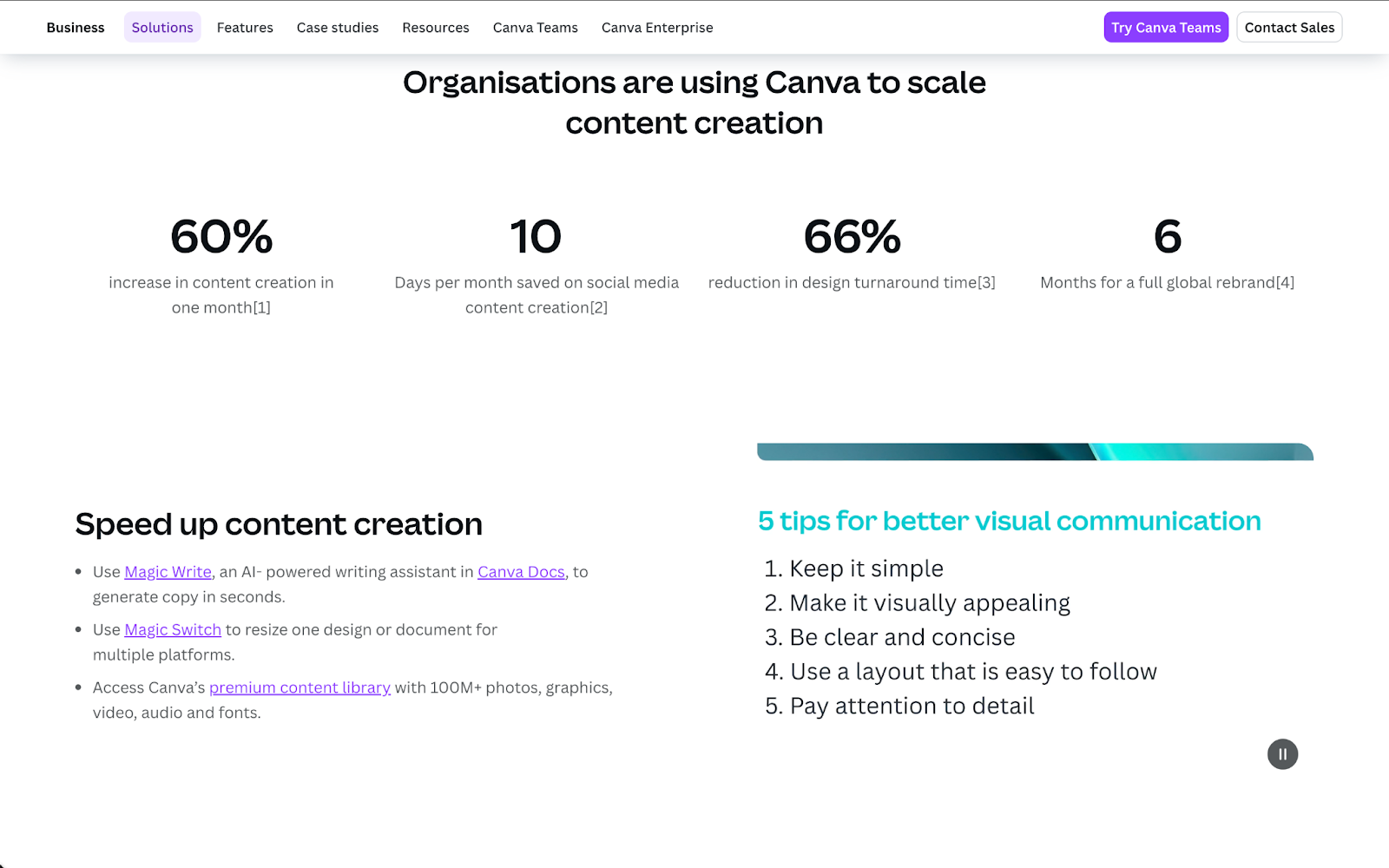
Canva’s page doubles as a product demo and a template marketplace. The headline, Create better content, faster, tells you what it does in one line. The layout then proves it. Big product screenshots sit next to template galleries, use-case blocks, and team-focused messaging. Emotion comes from bright visuals and diverse mockups that feel approachable to non-designers.
Action is simple. A single, clear CTA appears throughout. Relevance is where Canva outpaces others. It sells speed, brand control, and repeatable content workflows for teams. It pairs product features with actual templates, guides, and resources so visitors can start creating right away.
Your takeaway from Canva
Build template-driven flows for your top use cases so visitors can see how fast they can get real work done.
10. Zoom (a platform landing page built for enterprise momentum)

Zoom’s home page is one of the best SaaS landing page examples showing how to position a full platform without overwhelming visitors. Clarity comes from the headline “Find out what’s possible when work connects” and product cards that instantly preview core tools like Meetings, Team Chat, and AI Companion.
The layout is modular: hero → product cards → AI highlight → customer proof → use cases, each block clean and easy to scan. Emotion is built through credibility — enterprise logos, customer ratings, and stories from companies like Major League Baseball. Action is flexible: CTAs let you sign up free, explore features, or learn about AI.
And relevance is high: copy and imagery speak directly to enterprise teams managing hybrid work at scale.
Your takeaway from Zoom
If your product is a suite, structure your landing page so visitors can pick their own entry point without losing clarity.
Also read: 10 Hottest B2B Web Design Trends You Need in 2025
Best practices for landing page designs: apply CLEAR to your own landing pages
After breaking down the best landing page designs, we don’t want you walking away thinking, “Cool, but what do I do with this?” Inspiration is nice, but execution wins. That’s why we built the CLEAR checklist on the same framework we use at ThunderClap to help brands design landing pages that actually convert.
Here’s the quick infographic version of the CLEAR checklist:

And if you want the full details, here’s the step-by-step breakdown of each element:
Clarity
- Can a new visitor explain your offer back to you in one sentence? Test this with someone outside your team.
- Is the headline benefit-driven (what I get), not product-driven (what you do)?
- Remove jargon, acronyms, and filler — every word should earn its spot.
- Above-the-fold: one headline, one subhead, one CTA. Nothing more.
Layout
- Does your page follow a natural “F-pattern” or “Z-pattern” for scanning?
- Is the hero image aligned with the message (no random stock photos)?
- Are forms short, frictionless, and mobile-friendly?
- Have you trimmed visual clutter (multiple CTAs, carousels, distracting menus)?
Emotion
- Does your page trigger trust (logos, testimonials, case studies, security badges)?
- Are you tapping into urgency (limited seats, countdowns) or aspiration (success stories, future state)?
- Is there video, motion, or interactivity to engage beyond static text?
- Does the imagery feel human and relatable, not generic?
Action
- Is there exactly one primary CTA? (Sign up, Start free trial, Book a demo)
- Is the CTA button copy benefit-driven (e.g., Get started free vs. Submit)?
- Is the CTA visible without scrolling, and repeated logically as the user moves down the page?
- Do you offer a low-friction “secondary action” for fence-sitters (watch a demo, learn more)?
Relevance
- Does the landing page headline mirror the ad/email/search copy that brought the visitor there?
- Is the page segmented or personalized (by industry, persona, or geography)?
- Does the design work seamlessly on mobile, tablet, and desktop?
Have you tested load speed? Every second delay costs conversions.
How to use this checklist?
- Print this out
- Use it as a 5-step landing page audit
- Run every new campaign through CLEAR before launch
Turning landing pages into growth engines with ThunderClap
At ThunderClap, we know a landing page is never just a page. It’s your most important growth lever. We’ve optimized and redesigned 129+ B2B websites like Storylane, Amazon, Factors, roommaster, Deductive AI, and Zenda, and built their landing page experiences from the ground up.
Our work speaks for itself. Storylane lifted demo requests by 30%, and Zenda’s rebrand earned an Awwwards nomination.
Our process is proven. We start with mood boards that capture brand personality. We establish scalable systems for consistency. We bring products to life with custom illustrations, bold yet clean layouts, and trust-driven storytelling.
With us, you get:
- Bold design that matches your product’s personality.
- Scalable systems that keep visual consistency as you grow.
- CRO playbooks proven across SaaS and fintech.
- A partnership mindset (acting as an extension of your team).
If you’re ready to make your landing page your #1 salesperson, let’s talk. We’ll audit your funnel, pinpoint the leaks, and build a roadmap that gets you results in weeks, not months.
{{ctaBlock}}
FAQs
Do landing page design trends change every year?
Yes, trends in landing page design inspiration evolve constantly as user behavior and technology shift. In 2025, the best landing page designs highlight speed, AI-powered personalization, and mobile-first layouts. While core principles like clarity and strong CTAs remain timeless, keeping up with best practices for landing page designs ensures your page looks modern and drives conversions.
Can I use templates for landing pages, or should I design custom ones?
Both approaches can work. Templates are a fast way to get started, but custom designs give you more control. The best SaaS landing page examples often start with a template and evolve into custom layouts once teams see what converts. Whether you choose templates or custom, following best practices for landing page designs (clear messaging, strong visuals, and one focused CTA) is what matters most.
What are some examples of high-converting landing pages?
In 2025, some of the best landing page designs come from SaaS and fintech brands. Pages like Storylane, roommaster, and Zenda stand out because they combine clarity, trust signals, and relevance with consistent CTAs. If you’re looking for landing page design inspiration, explore the best SaaS landing page examples; they are often the clearest demonstration of how to turn design into conversions.
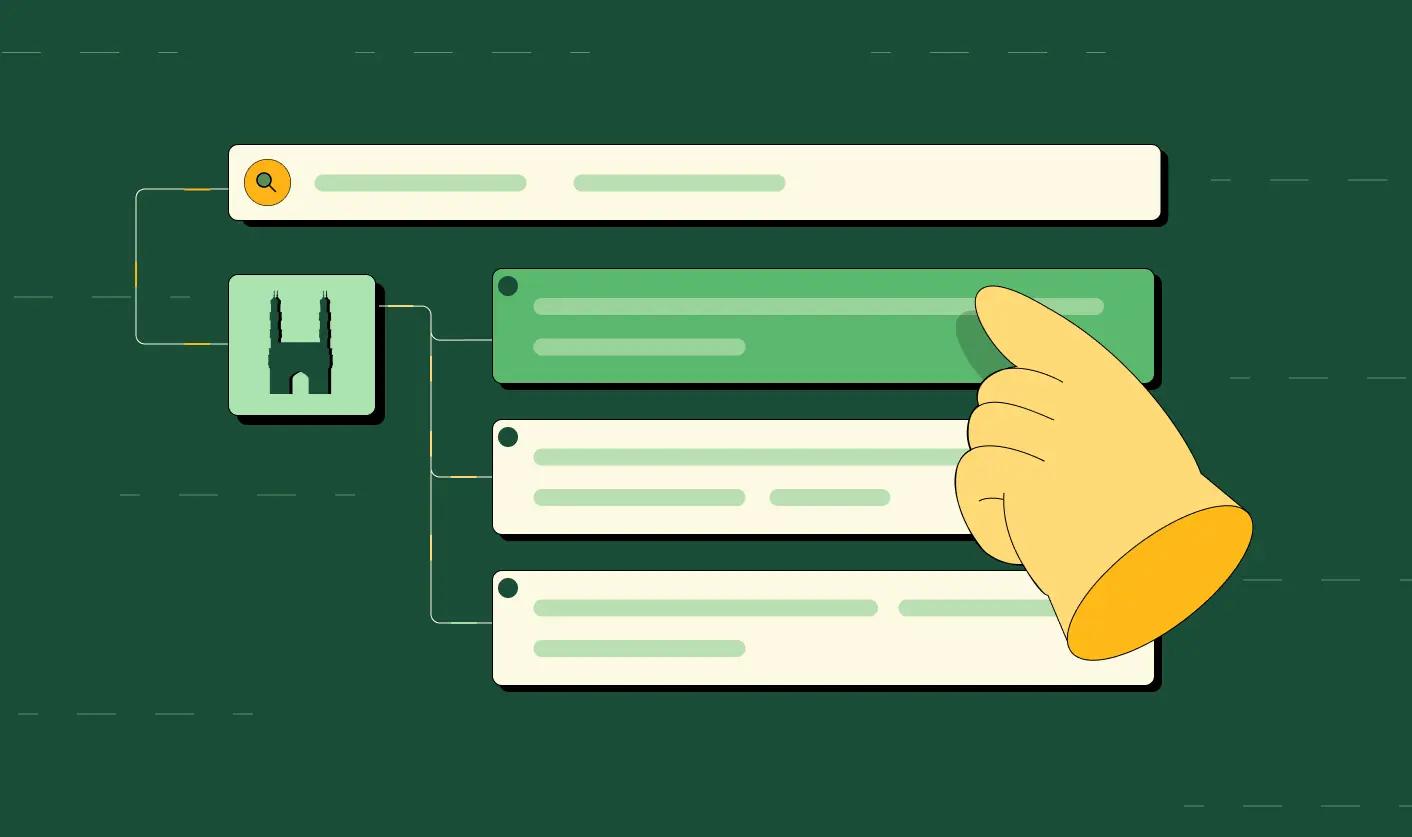
5 Best Web Designing Companies in Hyderabad
Your website acts like a full-time sales rep, working 24/7 without taking a break. But is it converting visitors into qualified leads?
Over 2,52,000 websites are created daily, and around 10,500 websites go live every hour. India alone has over 5.7 million websites. The global click-through rate sits at 4.23%, and more than 28% of businesses operate online. In a market this crowded, weak design means lost revenue.
At ThunderClap, we’ve rebuilt 140+ B2B websites for SaaS, fintech, and enterprise tech companies. We don’t just make sites look good. We make them convert. Every design decision must answer one question: Will this help engage the user?
This blog lists the 5 best web designing companies in Hyderabad, providing examples, use cases, and real value.
Why B2B Web Design and Development Matters More Than Ever
B2B teams often invest months in creating a polished site, only to find it fails to drive results. If your site isn't built for conversions, traffic won't help.
A homepage that looks clean but fails to guide visitors will never help close pipeline gaps. Buyers no longer want to skim through the websites. They want to scroll, click, explore, compare, and revisit before even talking to your sales team.
In fact, B2B prospects go through nearly 13 pieces of content before they fill out a form or request a demo. Most of that happens on your site. If your site takes too long to load, doesn’t explain your value fast enough, or leaves questions hanging, users won’t return.
B2B web design agencies that focus on growth address this issue. They build for the whole cycle, not just the hero section.
Also read: Outsourcing Webflow Maintenance vs. In-House Management: Which is Better?
5 Best Web Designing Companies in Hyderabad
Hyderabad has always been a hotspot for tech and innovation, but the last few years have taken things up a notch. Some of the best B2B web design talent now operates out of this city, serving clients across the globe.
If you’re looking for a website that converts better, loads faster, and doesn’t look like it was made in 2016, our list covering the five best web designing and development companies in Hyderabad will save you a few dozen hours of research.
1. ThunderClap

When B2B marketing teams need websites that convert, they choose ThunderClap. This isn’t your typical design agency that focuses on making things beautiful; ThunderClap builds websites that work as hard as your sales team. With 129+ websites launched and a strong focus on conversion rate optimization (CRO), we’ve proven that when strategy meets design, business goals are significantly exceeded.
What makes ThunderClap the #1 choice among B2B web design agencies in Hyderabad? Their obsession with outcomes over aesthetics. Every pixel, every page, every interaction is designed with one goal: converting visitors into qualified leads. We understand that B2B buyers need education, not just information, and we craft experiences that guide prospects through decision-making processes. Additionally, our designs have been recognized with industry-prestige Webby Awards and CSS Design Awards.
We deliver enterprise-quality websites in 8-10 weeks through our proven Webflow design and development process. Unlike other agencies that take months to launch, ThunderClap gets your conversion machine online quickly.
Take Skyroot Aerospace, for example. As the first private Indian firm to successfully initiate the first orbital launch vehicle, Vikram-1, they didn’t want a safe or boring site. They sought a design that felt bold, tech-forward, and polished enough to rival global aerospace brands.
ThunderClap didn’t land on Skyroot’s final design right away. We explored a few bold directions before finding the perfect mix of sleek grayscale visuals, 3D motion, and WebGL magic. Along the way, we helped shape Skyroot’s messaging too. We rewrote the tagline to refine the core idea behind “Opening Space for All.” It wasn’t just a line; it captured Skyroot’s bigger mission of making space more accessible.
When you land on the homepage, that mission comes alive. The moment you start exploring, it’s clear this isn’t just another aerospace site. The rocket launch animations let visitors feel what Skyroot does: launching missions into space.
Clean, bold typography, lots of breathing room, and subtle motion keep everything polished and easy to follow. Every section flows like a story (mixing inspiration with real product details). You can explore capabilities, timelines, and payload options without ever feeling lost. The homepage feels less like a brochure and more like a digital launchpad — immersive, confident, and built to shift how people perceive a technical brand.
Now, about their Book Your Launch page, which completely flips the idea of a “contact form.”
Instead of filling in boring blanks, visitors build their own launch. They can pick orbits, configure payloads, and choose launch vehicles in a guided, step-by-step flow. It’s like walking through the actual decision process, but beautifully simplified. Rideshare or dedicated mission? The visuals make the trade-offs clear. And once done, everything wraps up neatly into a downloadable ticket.
"ThunderClap’s team really took the effort to understand our space industry and created something that stood apart. I liked that they didn’t give a cookie-cutter solution — the website flow and the ‘Get to Orbit’ section came out exactly how I wanted. It’s a practical, well-thought-out website, not just a cool one."
— Sumil, Head of Brand & Communications, Skyroot Aerospace
Best for: B2B SaaS, fintech, venture capital, and AI companies scaling into new markets or repositioning as category leaders
Proof in the portfolio: ThunderClap’s deep industry expertise spans SaaS, fintech, and AI alongside consulting, commerce, and B2B services. Our client roster, 50% of which are global, includes: Amazon, Storylane, Factors, Skyroot, Deductive AI, Razorpay, and 80+ other B2B companies that chose results over pretty pictures.
Join 88+ fast-growing B2B brands like Amazon, Storylane, Factors, Skyroot, Deductive AI, Razorpay, and Skyroot who chose ThunderClap for websites that look good and drive serious results. With deep expertise across SaaS, fintech, AI, and more, we know what it takes to turn complex ideas into high-converting websites.
Book your strategy session today and see why top B2B teams trust ThunderClap when growth actually matters.
Talk to an Expert
2. Ozrit

If you're looking for web applications that feel fast, scale well, and come with zero drama, Ozrit might be the team for you. With 16 years in the game and over 500 specialists across tech, design, and strategy, they know how to build products that run smoothly and look sharp. From AI-led apps to full-stack builds for mobile and web,
They specialize in responsive websites, cross-platform apps, ecommerce stores, and CMS-powered platforms that marketing teams can edit without involving a developer every second day.
Their process breaks into five simple stages: requirement planning, design, development, testing, and post-launch support, and they’ve stuck to it across hundreds of projects.
Best for: Product-led businesses, marketplaces, and delivery-based services requiring custom functionality or full-stack builds with integrated AI-driven features
Proof in the portfolio: With over 270 happy clients across cross-platform projects and 320+ for mobile and app design services, Ozrit has helped businesses ship food delivery apps, taxi platforms, and even local services like milk delivery apps.
3. Inovies
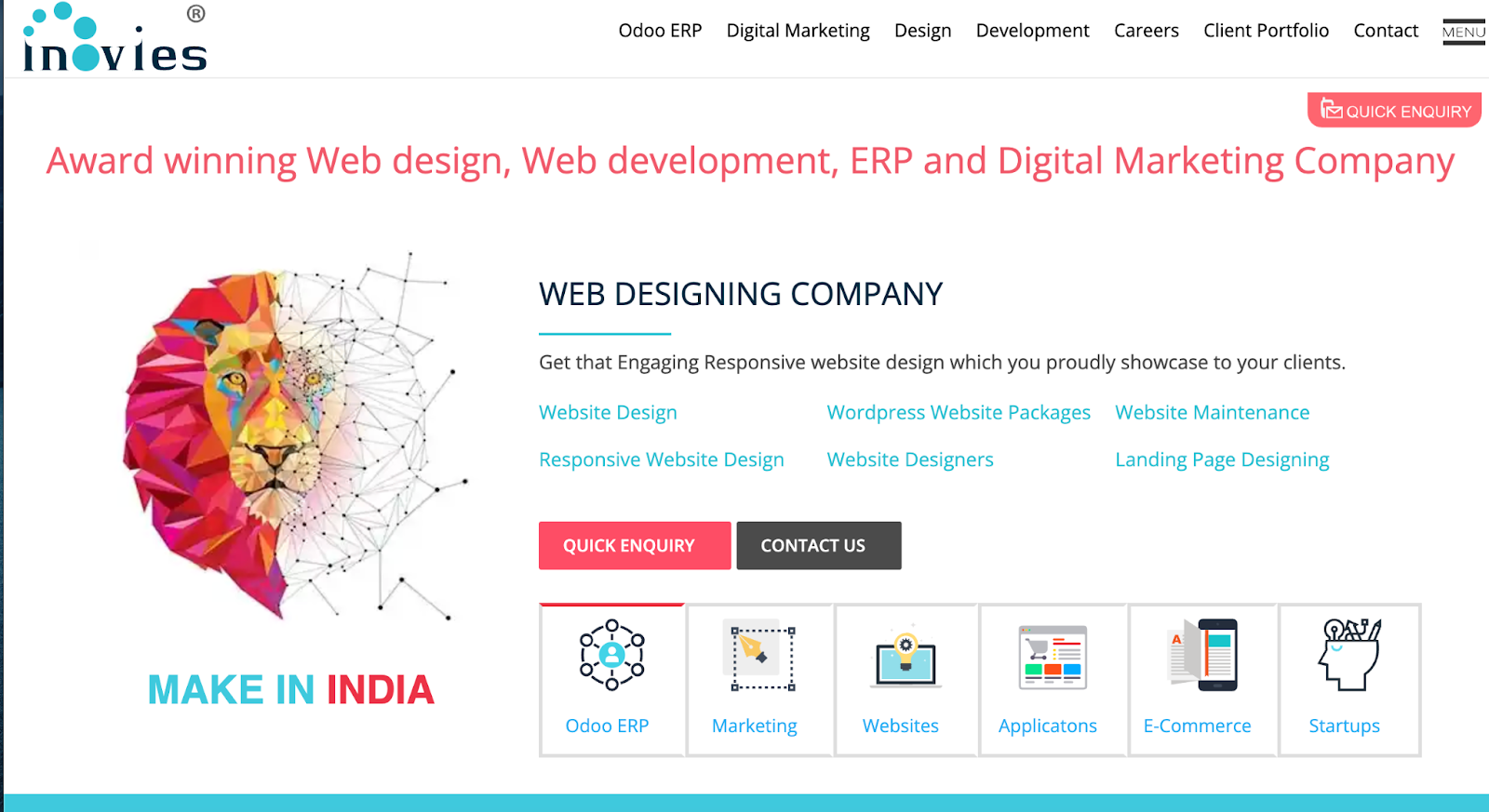
As a web designing and development company in Hyderabad, Inovies built a reputation for creating sites that feel modern, load fast, and adapt across devices. Their team builds experiences that speak to your audience’s needs.
Inovies offers services ranging from custom website design to complete web application development, including responsive, mobile-first builds and integration with CMS systems. They also handle ecommerce development and dynamic web projects that require deeper features and logic. Their methodology progresses through planning, design, development, testing, and post-launch support, all with real accountability.
Best for: Midsize businesses, enterprises, and organizations needing curated design, scalable features, or digital transformation work
Proof in the portfolio: Inovies has a diverse client list, including large corporations and government entities like Tech Mahindra and Ordnance Factory Medak, as well as smaller businesses from various sectors such as Glaze And Gloss, Bisolq, and Nice Hospital.
{{specficBlog}}
4. Probey Services
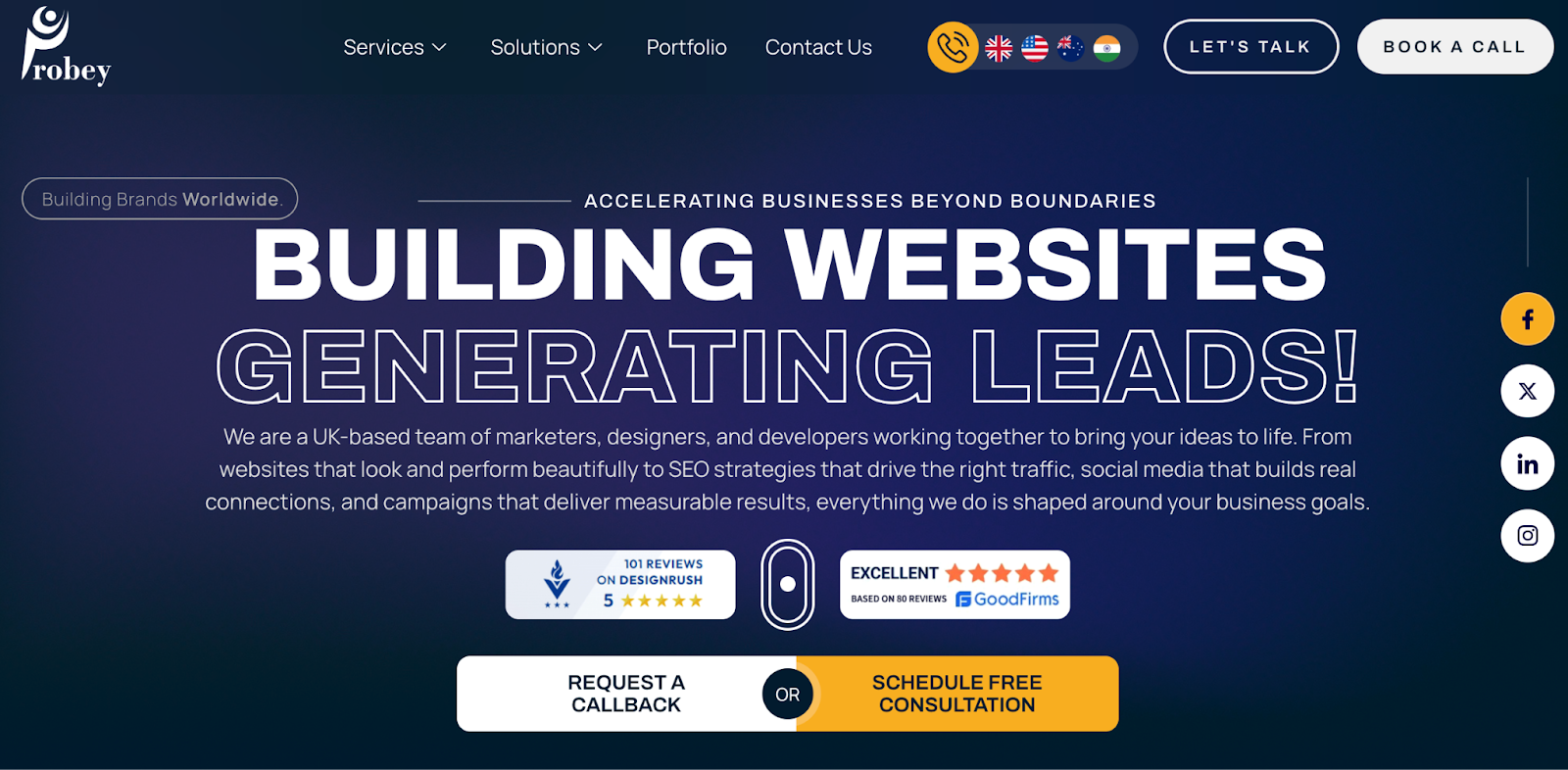
When you want a team in Hyderabad that builds websites and leads at the same time, Probey Services delivers. Their team of marketers, designers, and developers collaborates to create sites that not only look strong but also perform well under pressure. They combine design, SEO, social media, and campaign tactics so your site not only attracts traffic but also converts real users.
They begin every project with a full website analysis, identifying weak pages, slow loading issues, and conversion bottlenecks. Their design and planning phase refreshes visuals and fixes friction points. Then development kicks in using modern stacks and best practices for speed and usability. After coding, they put the site through rigorous testing across devices, browsers, and use cases before launching and optimizing with feedback and data.
Best for: Brands that want marketing and web development under one roof, especially SMBs and growing midmarket firms
Proof in the portfolio: Names such as Bartisans, The Cinammon Kitchen, PNG Jewellers, PRAO, and Laviscart appear in their client list. Additionally, Probey has been recognized as the #1 web design company in India on Clutch, thanks to its exceptional client satisfaction and design quality.
5. Happening Design Studio
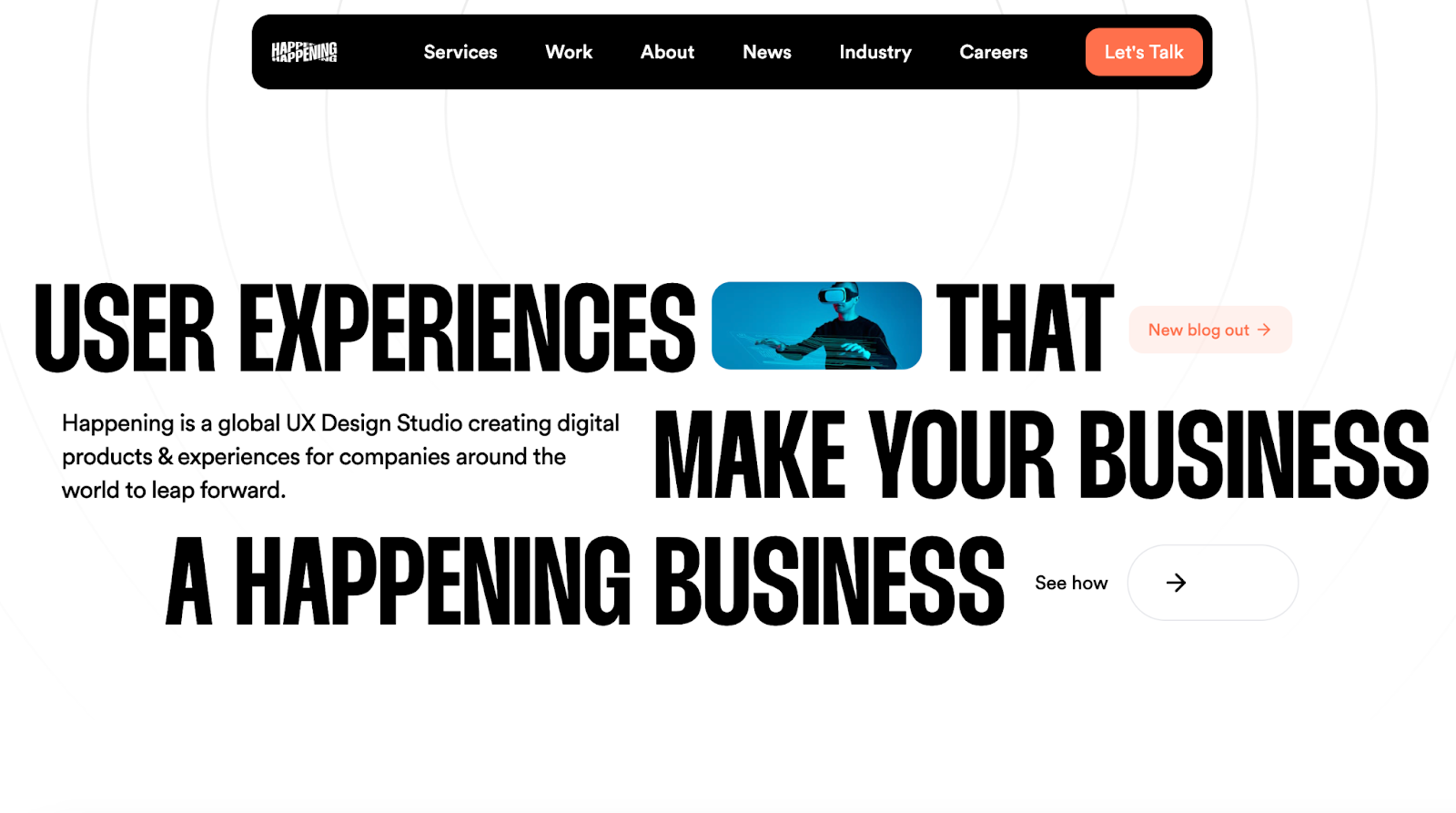
If you’re looking for a web designing and development company in Hyderabad that can combine brand strategy and enterprise web design practices with great UX, Happening Design Studio offers real value. They believe in working with empathy and research to build websites and experiences that matter. Their model doesn’t begin with looks, but it starts with understanding your users, your market, and what they actually need.
Happening handles UX design, research, and strategy with equal seriousness as brand strategy and growth. Their process involves rapid prototyping, user testing, iterative design refinement, and integration into full interactive websites. They also build full‑stack mobile and web apps using modern tools and methods. They serve clients across more than eight industries, delivering over 500 projects so far.
Best for: Projects that need strong user insights, solid UX research, and digital product teams pushing beyond static visuals into full user‑centric design
Proof in the portfolio: Happening Design Studio has worked with clients including Perigon, BURNCO, and iPlanned. They have also collaborated with Ananki to develop a 5G platform, which enabled Ananki to secure a multi-million dollar project. The studio works with global brands across various industries like tech, e-commerce, and fintech.
Also read: 5 Best Web Development Outsourcing Companies in 2025
Still Deciding? Here’s What to Keep in Mind
Let’s say you’ve shortlisted your top three agencies from this list, and now you’re ready to pick a winner. The smartest next step is to talk to each of them. Ask how they work, how fast they move, and what kind of results they’ve delivered for companies like yours. The best partners won’t hide behind big words or fancy decks. They’ll show real proof, speak clearly, and tell you what to expect from day one. In the end, choose the best web design company in Hyderabad that makes your website work harder than your sales team.
Skyroot Aerospace, one of India’s leading private space-tech companies, trusted us to craft a site that could match their pace and ambition. As the first Indian startup to launch a private rocket, their standards were sky-high, and we met them with performance-first design.
If you're still on the fence, here's why ThunderClap should be on your shortlist:
- 129+ B2B websites revamped for companies focused on results
- 140+ launches across SaaS, fintech, and AI within tight delivery windows
- Up to 50% boost in conversions for teams that needed more than surface-level design
- Trusted by Amazon, roommaster, Storylane, Skyroot, and Factors for fast and functional websites
- Known as a conversion-focused web design and development company in Hyderabad with proven outcomes
- Rated as one of the best web design agencies in Hyderabad for B2B brands
Book a strategy call to discover how we can help transform your website into a top-performing growth channel.
FAQs
Why should I hire the best web designing company in Hyderabad?
Hiring a web design company in Hyderabad brings you local expertise, cost efficiency, and faster collaboration. These agencies understand regional market trends, adjust designs for Indian audiences, and handle everything from UI to performance optimizations. You don’t have to manage multiple vendors. A skilled Hyderabad-based team can take your idea, build it end-to-end, and maintain it, while you focus on growing your business.
How do I choose the best web designing company in Hyderabad?
To pick the best web designing company in Hyderabad, evaluate their track record, process clarity, and post-launch support. Look at case studies in your vertical, ask how they handle conversion rate optimization (CRO), and check whether they offer web designing and development services (design plus tech). For example, we at ThunderClap are chosen by 88+ B2B teams because we launch high-performing sites in 8–10 weeks, not months, and stay accountable for results.
What is the typical turnaround time to build a website at the best web designing company in Hyderabad?
Most agencies quote 6 to 12 weeks, but many end up spending months in feedback loops. A slick team can compress that to 8 to 10 weeks if the scope is clear and the content is ready. At ThunderClap, we hit that mark by starting with strategy and avoiding endless rounds of design tweaks. If the agency you talk to cannot clearly state milestones or timelines, it’s a red flag.
What does ongoing maintenance and support look like after launch at the best web designing company in Hyderabad?
After launch, your site will require regular updates, error fixes, security patches, performance checks, and occasional design/improvement sprints. Ask potential web designing agencies in Hyderabad how many support hours are included, their response time, and whether maintenance is handled by the same team that built your site, because consistency matters.

From Click to Customer: Proven Landing Page Conversion Optimization Techniques
You can buy clicks. You can’t buy conversions.
That’s the central tension of SaaS marketing today: teams pour budget into Google Ads, outbound, SEO, and social distribution, but then lose 90% of their visitors on the very first touchpoint: the landing page.
At ThunderClap, we’ve audited hundreds of SaaS landing pages and seen the same story. The landing page doesn’t accelerate interest into action; every campaign dollar leaks away. The difference between an okay landing page and a customer-producing landing page isn’t a prettier design. It’s a scripted sequence: give people a reason to care, remove their doubts, and make the next step effortless.
We call that sequence MAP (Motivate → Assure → Prompt). This blog post breaks each part open, gives exact sentences and structures you can copy, and hands you the small-but-powerful decisions that add up to big lifts.
TL;DR
- SaaS teams lose 90% of traffic at the landing page. Clicks are easy, conversions are hard.
- Generic landing page optimization strategies don’t work for SaaS: CTAs are heavier, buyers are cautious, and switching costs feel high.
- ThunderClap’s MAP framework (Motivate → Assure → Prompt) creates momentum that turns visitors into customers.
- Motivate with outcome-first headlines, Assure with layered proof, and Prompt with frictionless CTAs and short forms.
- ThunderClap has optimized 129+ websites, lifting conversions 40–50% by designing landing pages that act like your best salesperson.
Why generic landing page advice fails SaaS
Most “landing page optimization best practices” you’ll find online assume visitors arrive ready to act. But SaaS buyers aren’t impulse shoppers; they’re cautious, often in multi-stakeholder buying cycles.
We’ve worked on 129+ B2B websites like Amazon, Razorpay, and Factors. When we run CRO reviews before website revamps, three SaaS-specific challenges always surface:
- Commitment-heavy CTAs: Signing up for a trial or booking a demo involves effort and risk.
- Multiple decision-makers: End-users care about usability, while CFOs care about ROI and compliance.
- Perceived switching costs: Adopting new software feels like a big bet. Buyers worry about disruption, onboarding, and wasted time.
That’s why “move the CTA above the fold” won’t cut it. SaaS landing pages need deeper optimization strategies rooted in psychology, buyer journey alignment, and trust-building.
MAP framework for landing page conversion optimization: at a glance
Before diving in, let’s anchor on why we created MAP.
We saw clients struggle because their landing pages were designed in fragments: a headline from marketing, a form from sales, a testimonial tossed in by design. MAP forces coherence. It ensures every piece of the page is doing its job to build momentum: motivate visitors, assure them it’s safe to act, and prompt them clearly toward the next step.
MAP is the landing page optimization system for SaaS that works. It’s design + psychology + friction engineering.
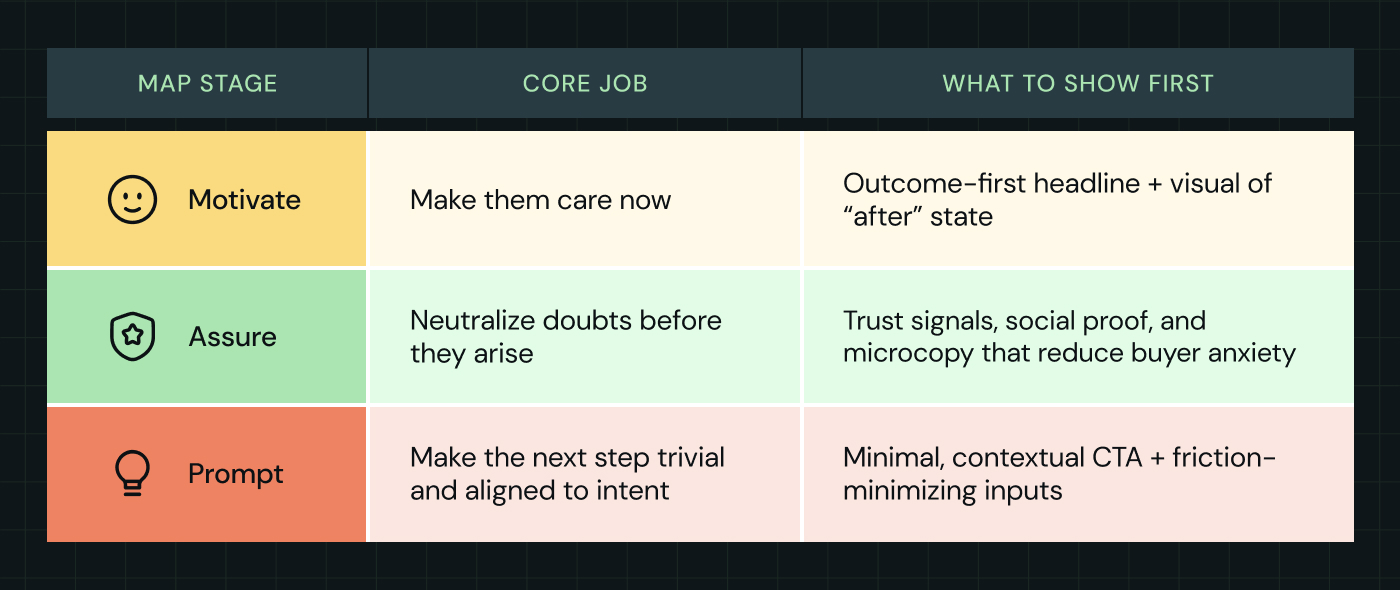
On a landing page, each stage should flow into the next. If Motivate is strong but Assure is weak, readers hesitate; if Assure is strong but Prompt is bad, momentum stalls.
Build all three, and you get conversion velocity.
Want to see MAP in action? When we revamped ConsultAdd’s homepage with these strategies, conversions jumped by 60%. Here’s a quick walkthrough of the before and after.
1. MOTIVATE — grab interest and create desire (do this well, and the rest is easier)
When we optimize SaaS landing pages, we start with the hero. If the hero doesn’t do its job in 3 seconds, the rest doesn’t matter. Motivate is the art of making an immediate, credible, emotional & rational case for action.
The job: make visitors say “this is for me” in under 3 seconds
Visitors usually arrive with a partial intent. They’re curious but not committed. Your hero section needs to close that tiny intent gap fast.
What high-performing motivation looks like
- Outcome-first headline (not product-first)
- Bad: AI-powered analytics platform
- Better: See campaign ROI in minutes — not days.
- Best (more specific): Cut reporting time by 70% and ship results in your first week.
- Bad: AI-powered analytics platform
- Why outcome-first? People buy results. Features justify later; results convert now.
- Single-sentence subhead that removes ambiguity
- Format: What it does + who it helps + one benefit.
- Example: Automated analytics for mid-market B2B marketers (no data science required).
- Format: What it does + who it helps + one benefit.
- Visuals that show the ‘after’ state
- A screenshot with real-looking data (annotated), or a short 15–25 second animated GIF of the product in action.
- Avoid hero imagery that’s purely abstract (people shaking hands, stock photos). Make the result visible.
- A screenshot with real-looking data (annotated), or a short 15–25 second animated GIF of the product in action.
- Small, high-confidence proof immediately visible
- A short line like “Trusted by 400+ marketing teams” or a single logo strip directly under the subhead. That’s not the full trust layer; it’s a signal the brain prefers.
- A short line like “Trusted by 400+ marketing teams” or a single logo strip directly under the subhead. That’s not the full trust layer; it’s a signal the brain prefers.
- Contextualized urgency (when appropriate)
- Not cheap FOMO. Real urgency tied to buyer benefit: “Get white-glove onboarding through July” or “Free automated migration for early adopters.”
- Not cheap FOMO. Real urgency tied to buyer benefit: “Get white-glove onboarding through July” or “Free automated migration for early adopters.”
Here’s an example of a SaaS brand doing this right:
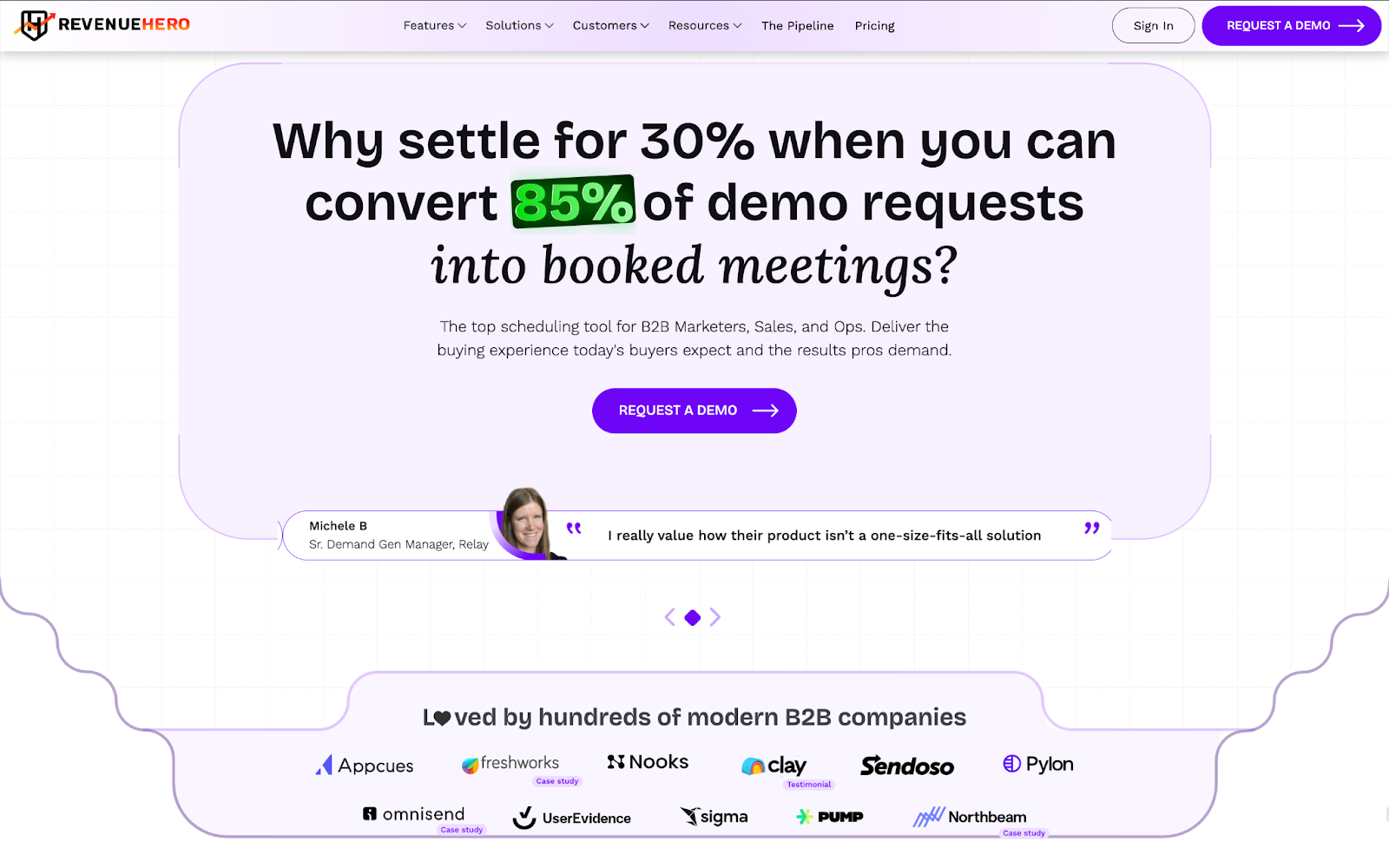
Micro play #1: Our tested headline recipes you can swipe
- [Outcome] + [timeframe] + [social proof hint]
- Automate monthly reports in 10 minutes — used by marketing teams at 200+ companies.
- Automate monthly reports in 10 minutes — used by marketing teams at 200+ companies.
- [Problem to avoid] + [solution]
- Stop losing deals to slow reporting — deliver weekly insights in one click.
- Stop losing deals to slow reporting — deliver weekly insights in one click.
- [Question that names the buyer]
- Are you a Growth Lead? Reduce your reporting backlog by 70%
- Are you a Growth Lead? Reduce your reporting backlog by 70%
Good design in CRO means guiding attention and making action feel effortless. With Zenda, we overhauled their design system to prioritize clarity and proof. The team loved the design, which also got nominated for Awwwards.
A quick UX audit often uncovers hidden blockers: CTAs buried too low, visuals that distract, or forms that feel heavier than they are. From a design and layout lens, put the CTA visually next to the value statement (don’t hide it below the fold). Use a single prominent visual region (screenshot or GIF). We know that the best headline is 8–12 words and the subhead is 12–18 words.
{{specficBlog}}
2. ASSURE — neutralize the buyer’s doubts before they arise
Even if your headline convinces, buyers will pause. Their internal checklist may include: Will this work for me? Is it secure? Will onboarding suck? How much will it cost?
Assure answers those questions proactively and precisely, not vaguely.
The job: turn “maybe” into “safe to try”
Assurance is not a single element. It’s an architecture. Those elements must be visible early and be contextually relevant to the CTA.
We used this firsthand when we worked with Storylane on their website revamp.
- Total conversions up 22%
- Conversions per user up 19%
The assurance stack (what to show, and where)
| Layer | Purpose | Ideal Placement |
|---|---|---|
| Social proof (logos) | “People like me use this.” | Immediately below the headline |
| Outcome testimonials (with metrics) | “It did this for them.” | Next to CTA or under hero section |
| Security & compliance badges | “This meets required standards.” | Sidebar for enterprise CTAs |
| Integrations & ecosystem | “It fits my stack.” | Under the trust block or near the CTA |
| UX microcopy (speed, credit-card info) | Removes setup anxiety | Next to form fields |
How to choose what to show first
- If you target SMBs: show outcome proof and quick-start promises (time-to-value).
- If you target enterprise: lead with compliance, uptime, and procurement-friendly links.
- If the CTA is a demo: show logos of recognizable customers and a short testimonial from someone in procurement or IT.
Also, add a one-line “what happens next” above the form: “We’ll email a 1-click setup link — you’re live in 5 minutes.”
Your pricing page is the most visited (and most overlooked) page on your site. We analyzed 50 SaaS pricing pages to create a proven blueprint, complete with insights, a wireframe, and a checklist that you can apply right away. Get the Pricing Page Blueprint.
Also read: 12 Effective Formats of Social Proof for Your B2B SaaS Website
The psychology: remove friction before it appears with micro copy
Buyers imagine worst-case scenarios automatically. If a visitor thinks “I’ll waste time,” your job is to whisper “You won’t.” If they think “This might be insecure,” you must show a credible security signal before they ask.
Three small, measurable tactics you can use today:
- Use a one-line “what happens next” statement above the form (e.g., “We’ll email a 1-click setup link — you’re live in 5 minutes.”)
- For demo CTAs, indicate time commitment (e.g., “Book a 15-minute walkthrough with a solutions engineer.”)
- If you collect sensitive fields, add a privacy microcopy (“We’ll never share your info.”)
Also read: 20 Proven SaaS Conversion Optimization Hacks to Boost Your Sales
3. PROMPT — make the next step irresistible and frictionless
This is where momentum either becomes a conversion or evaporates. The Prompt stage is about aligning the CTA with intent and reducing friction to the absolute minimum.
We use a simple rule here: ask for the least amount of commitment that still moves the deal forward.
Ask for too much and you lose; ask for too little and you waste everyone’s time. The golden rule: ask for the least that reliably moves someone forward.
Common SaaS CTA archetypes and how to design them
| CTA Type | Minimum Ask (Example) | Best Friction Pattern |
|---|---|---|
| Free Trial | Email + password (or OAuth) | One-click OAuth + 1-step onboarding |
| Demo | Email + calendar slot | Integrated calendar widget (no long forms) |
| Contact Sales | Name + email + company | Short form + optional “book time” button |
| Content / Gated Playbook | Email only | Inline modal with social sharing options |
| Upgrade (In-app) | Click to purchase + 1 confirmation | In-app modal with one-click payment |
One of the most commonly asked questions we receive on how to optimize landing pages is around form design. Here are a few design rules you can implement today:
- Fields: 3–4 fields for initial contact (Name, Work Email, Company, Role). If you must ask more, use progressive profiling later.
- Placeholders and labels: use explicit placeholders (not “Enter text”).
- Button copy > color: use benefit-oriented copy: “Start Free — No Card” or “Book 15-Min Demo”.
- Inline reassurance: place microcopy beneath the button: “No credit card. Cancel anytime.”
Mobile-first inputs: enable number and email keyboards where appropriate; keep taps large.
How to personalize landing pages without creeping out users
Personalization is powerful, but only if it feels relevant, not invasive. At ThunderClap, we run segment-level personalization, not “Hi [FirstName]” gimmicks. We have found the best ways to do this are:
- Firmographic swaps: SMB sees “Perfect for lean teams.” Enterprise sees “Enterprise-grade compliance and SSO.”
- Persona swaps: CFOs see “Calculate ROI” while developers see “See API docs.”
- Campaign-aware text: If the ad mentions HIPAA, the landing page headline references HIPAA compliance.
We tell clients to start with headline + CTA personalization for 2–3 top segments. That’s 80% of the gain with 20% of the complexity.
If you run demos, use ThunderClap’s High-Converting Demo Page Playbook. She studied 30 B2B SaaS brands to find landing page optimization strategies that leading brands are using on demo pages.
Inside the 39-page ebook, you'll find landing page optimization best practices, an editable wireframe you can use to create a high-converting demo page for your SaaS brand, and three ready-to-use prompts to craft a perfect headline for your demo landing page.
Common buyer objections and exact copy to reply with
Objection-handling isn’t just for sales calls. It is also a landing page optimization strategy. By surfacing answers at the exact decision moment (right beside your CTA), you remove friction before it turns into abandonment.
Here are the most common SaaS buyer objections, paired with microcopy ThunderClap has field-tested on client pages to keep momentum alive:
| Objection | Field-Tested ThunderClap Phrasing |
|---|---|
| “It will take too long to set up.” | “Get started in 5 minutes. Guided onboarding included — no IT required.” |
| “Is it secure?” | “SOC 2 Type II certified. Data encrypted at rest & in transit — see our Trust Center.” |
| “Will it integrate?” | “One-click sync with Slack, HubSpot, Snowflake.” |
| “What if it doesn’t work?” | “30-day money-back guarantee / Cancel anytime.” |
How ThunderClap uses MAP for landing page optimization for SaaS clients
We keep this short: when we implement MAP, we do small surgical changes first (headline, hero visual, CTA microcopy, trust row). Then we prioritize one structural change per conversion flow: replace long demo forms with scheduler widgets, swap 9-field trials to OAuth + email, and move testimonials under the CTA. The lessons above are the same ones we use at scale.
We love checklists because they force discipline. Before shipping any landing page, we apply two.
Copy & UX checklist to optimize landing pages for conversions

Ready to execute our MAP framework to optimize your landing pages for conversions?
The MAP framework we’ve unpacked here shows how SaaS landing pages can stop leaking visitors and start converting customers. You can take these ideas and run with them on your own. Or, if you’d rather move faster and go further, that’s where ThunderClap comes in.
Why ThunderClap? Three reasons set us apart:
- Proven track record in SaaS growth → We’ve optimized 129+ B2B websites and landing pages, partnering with companies like Amazon, Storylane, Factors, and roommaster. Our work consistently transforms static pages into conversion engines.
- Conversion-first methodology → We don’t just redesign. We build momentum architectures that lift demo signups, accelerate trials, and drive pipeline revenue. Many clients see a 40–50% increase in conversions within months.
- Scalable execution → Every project we deliver is built for growth — from Webflow implementations your marketers can own, to playbooks your sales and growth teams can iterate on.
Plenty of agencies can hand you a prettier landing page. ThunderClap hands you a landing page that becomes your most reliable salesperson.
If you’re ready to stop wasting clicks and start turning them into customers, book a consultation with ThunderClap today.
{{ctaBlock}}
FAQs
1. How do I optimize landing pages for conversions when my product has multiple buyer personas?
This is one of the biggest SaaS pain points. A CFO, an end-user, and an IT manager all evaluate your product differently. To optimize landing pages for conversions, personalize at the segment level. Swap headlines and CTAs by persona or firmographic data (e.g., “Calculate ROI” for CFOs, “See API Docs” for developers). This targeted approach is a core landing page optimization strategy that prevents “one-size-fits-all” pages.
2. What landing page optimization strategies actually work if my team has limited design and dev resources?
SaaS marketers often don’t have the luxury of big redesigns. The good news: high-leverage landing page optimization for SaaS doesn’t require full rebuilds. Focus on microcopy around CTAs, place testimonials directly under forms, and integrate a demo scheduler instead of a long request form. These lightweight strategies can deliver a 30–40% conversion lift without major dev work.
3. What metrics should I track to measure the success of landing page optimization?
Many SaaS teams only look at form fills, but that misses the full picture. To measure landing page optimization success, track:
- Conversion Rate (CVR): % of visitors completing your CTA (trial, demo, signup).
- Qualified Conversion Rate: % of conversions that match your ICP.
- Bounce & Scroll Depth: Are visitors engaging or leaving too soon?
- CAC Payback & LTV Impact: Does optimized landing page traffic generate profitable customers?
4. What are the best tools to use for landing page optimization in SaaS?
The right tools make it easier to test and refine quickly without drowning in dev cycles. For SaaS landing page optimization, we recommend:
- Webflow or Unbounce: Build and iterate landing pages without heavy code.
- Hotjar or FullStory: See how visitors actually behave on the page.
Google Optimize or Optimizely: Run A/B tests on headlines, CTAs, and layouts.

How to Write Website Copy That Converts: A Step-by-Step Guide for 2025
Last week, I was auditing a B2B website for a revamp. The design was on point, but the copy? Totally missed the mark.
It looked just like any cookie-cutter template you can download online. Headlines were aspirational and meant nothing to the target audience. And worse? They were addressing the wrong ICP.
So why did this happen? Or how can you stop it from happening?
Here’s everything you need to know about writing high-converting website copy, including:
- What it is and why it matters
- Its key components
- A 6-step process for high-converting copy
- Ready-to-use templates for B2B webpages
- 3 copywriting tips for the best results
What is website copy?
Website copy is the written content on your website that informs visitors about your product/service while compelling them to take a desired action. The desired actions for B2B buyers usually include signing up for a demo or free trial, downloading a resource, registering for a webinar, sharing their details, or making a purchase.
What are the major components of a website copy?
A high-converting B2B website copy includes 8 major components:
1. Headlines
Headlines are eye-catching texts that persuade potential buyers to keep reading. It should communicate what your product does to your target audience in simple words.
Example

2. Subheaders
Subheaders are supporting statements to headlines that help buyers easily grasp the core message.
Example

3. Body Copy
Body copy is where you deep-dive into your offering, covering everything from pain points and features to benefits and outcomes.
Example
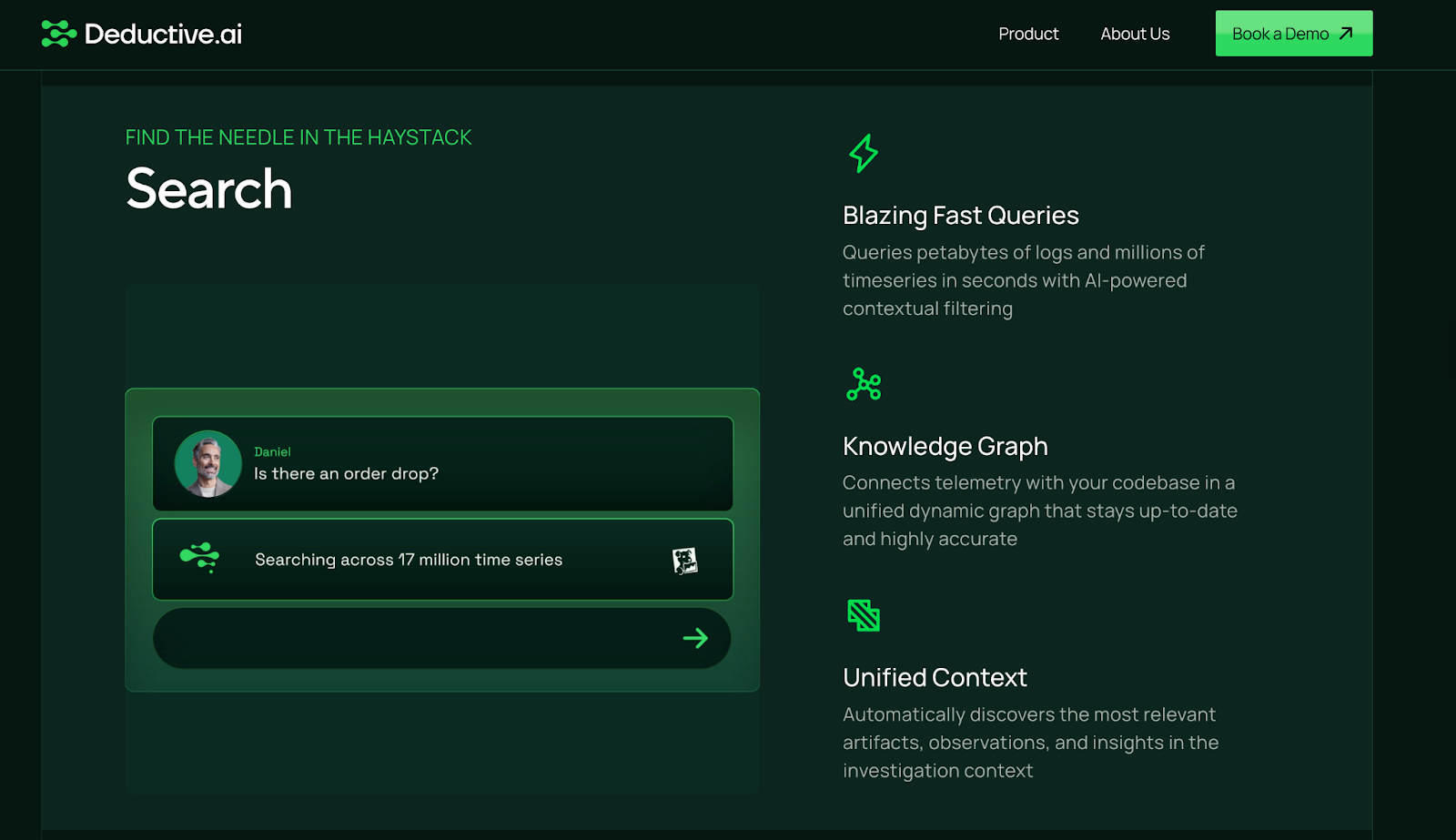
4. Value Proposition
Value proposition statement explains the ‘What’s In It For Me’ (WIIFT) to your target audience.
Example

5. Transformational Cues
Transformational cues are a type of conversion cue that highlights the transformation or change your product brings.
Example

6. Social Proof
Social proof in the form of trust badges, testimonials and logos gives potential buyers enough confidence to jump on the bandwagon.
Example

7. Call to actions
Call to actions, when placed at strategic locations, are what drive buyers to take the desired action.
Example

8. Microcopy
Microcopy refers to short texts that guide users through a website, giving them a seamless user experience.
Example

Why do you need a high-converting website copy?
Short answer? Because a website is the most important touchpoint for your buyers. They look at your website to figure out whether they should keep reading, trust you or even buy from you.
Studies report that they read headlines and skim through the website copy to determine this. For them, weak copy, poor grammar and spelling errors are solid reasons to stay away from a brand.
On top of that, a high-converting website copy:
- Makes your product memorable: When your website copy speaks the language of your target audience, it strikes a chord with them. This helps solidify your brand identity and make your product unforgettable.
- Boosts conversions: Only great copy can inform buyers about your product and persuade them to trial, demo or sign up for it. In other words, when the copy clicks, buyers take the right action without any hesitation.
- Complements your web design: A great web design catches eyes, but only the right words have the power to turn casual visitors into buyers. It is the copy that convinces and guides buyers towards action.
{{specficBlog}}
6-step process to write high-converting website copy
Here are the 6 steps you should follow to write high-converting copy for B2B websites:
1. Know your audience
You need to know your ICPs inside out to speak to them in their own language. And to truly find the voice of your customers, you should look beyond their demographics, interview them and collect intel about the:
- Triggers that made them look for a solution
- Pain points they are looking to solve
- Objections that stop them from putting pen to paper
- Wow factors that made them choose you over your competitors
- Direct outcomes your product helped them achieve
- Secondary outcomes that came as part of the package
- Stakeholders involved in the decision-making process
- Language they used to explain the impact the product makes in their daily workflow
2. Map out your customer’s journey
Once you define your ICP profiles, it is time to map out their customer journeys to understand when and where they interact with your brand. Each persona prefers different routes, from websites and blogs to pricing and demo request pages, as they move from awareness to decision making.
Skipping this step can result in a disconnect between buyer expectations and your offer. A classic example is using a headline like ‘[Product] for [Personas]’ on the homepage when multiple ICPs are involved.
Another example is writing website copy for decision-makers instead of end users. Decision-makers often rely on end users to champion a product rather than evaluating it themselves.
Here’s a good customer journey mapping template from HubSpot to start with:
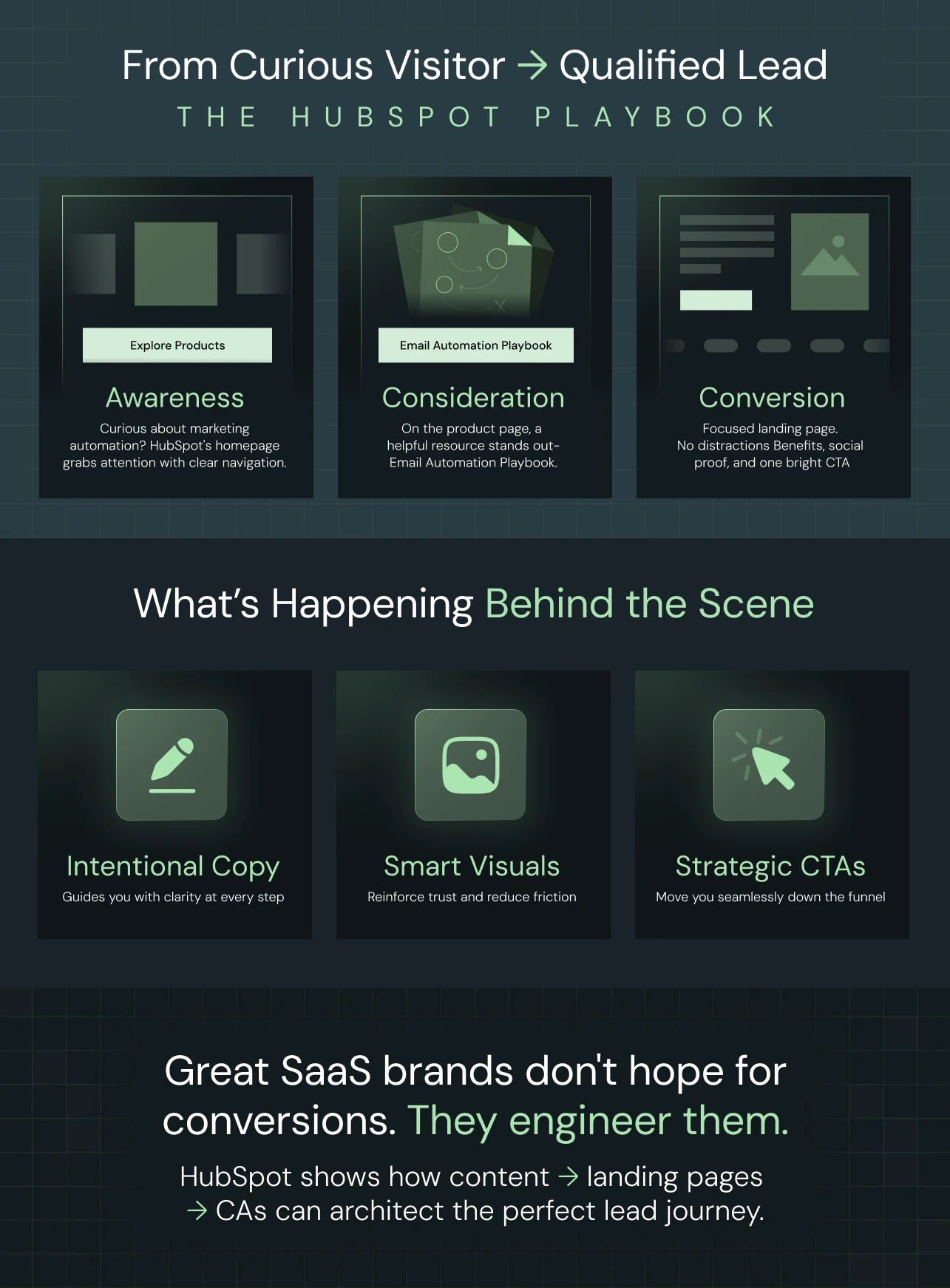
3. Define your brand personality
Your brand personality is a sum total of your brand archetype and brand voice. Brand archetype determines ‘who you are’ and the brand voice decides ‘how you talk’. A unique brand personality resonates with your mission and audience while setting you apart from your competitors.
To build this personality, start by choosing an archetype from the 12 Jungian archetypes that best aligns with your brand and audience.
These 12 archetypes, each representing a universal character trait, include: the caregiver, the creator, the everybody, the explorer, the hero, the innocent, the jester, the lover, the magician, the rebel, the sage, and the sovereign.
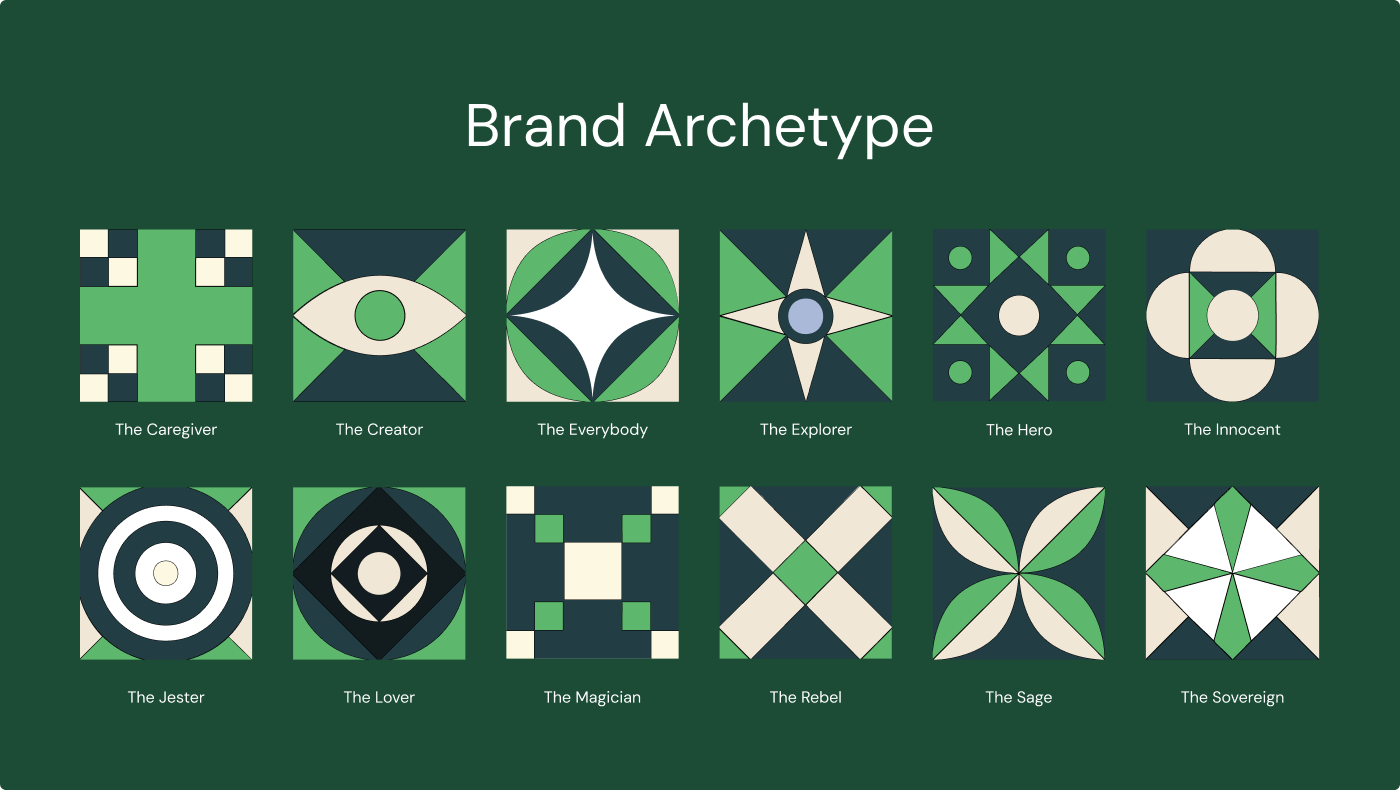
Next, pick a brand voice: playful, authoritative, conversational, motivational, bold, empathetic and casual, and create a brand voice style guide. Include dos and don’ts, examples and a list of words and phrases that can be used across your copy.
Here’s an example of dos and don’ts from a brand voice guide:

Source: Shopify
4. Figure out your value proposition
A value proposition statement communicates two things: the results your product delivers and what sets you apart from competitors. And it can differ across primary, prospect, product, and process levels.
Example
Here’s how Storylane’s value proposition differs across multiple web pages:
| Type of Value Proposition | Location | Example |
|---|---|---|
| Primary level: big promise | Homepage | Create interactive demos in 2 minutes. |
| Prospect-level: for different audience segments | Solutions page / sales | Accelerate your sales cycles with leave-behind demos. |
| Product-level: related to features and benefits | Product page / Lily |
Simplify buying with Lily sales agent. Let Lily handle discovery, objections and qualification so your team can close more. |
One of the easiest ways to define your value proposition after understanding your audience and product is through competitor analysis. This helps uncover gaps in competitors’ messaging and craft a unique, compelling value proposition.
5. Identify the goal of the website copy
The desired action from your buyers varies across different webpages. For example, homepage copy aims to build credibility and guide users to product pages, while demo request page copy focuses on getting buyers to book a demo.
Uncovering the ‘why’ behind each web page helps you:
- Map out messaging hierarchy: Figure out the key information buyers are looking for on each page and add it in order of relevance.
- Finalize call-to-action placements: Find appropriate CTAs for each page and add them at strategic locations, including above the fold and after key sections.
- Tailor copy for intent: Review each page’s goal and write a copy that matches the buyer’s intent. For example, use the homepage to educate, product pages to persuade, and conversion pages to prompt action. This ensures users are guided smoothly toward the desired outcome.
6. Write, test, refine, repeat
Use all the insights from steps 1–5 to write your first draft. Include relevant keywords to make your copy SEO-optimized.
But don’t stop there, test it out: A/B test variations of headlines, CTAs, conversion cues, and layouts to identify the best-performing options. Refine and tweak your messaging if it doesn’t hit the mark.
Repeat these steps whenever conversions drop, a new feature or product is added, or your brand evolves.
3 ready-to-use B2B webpage templates to boost conversions
1. B2B Product Page Template
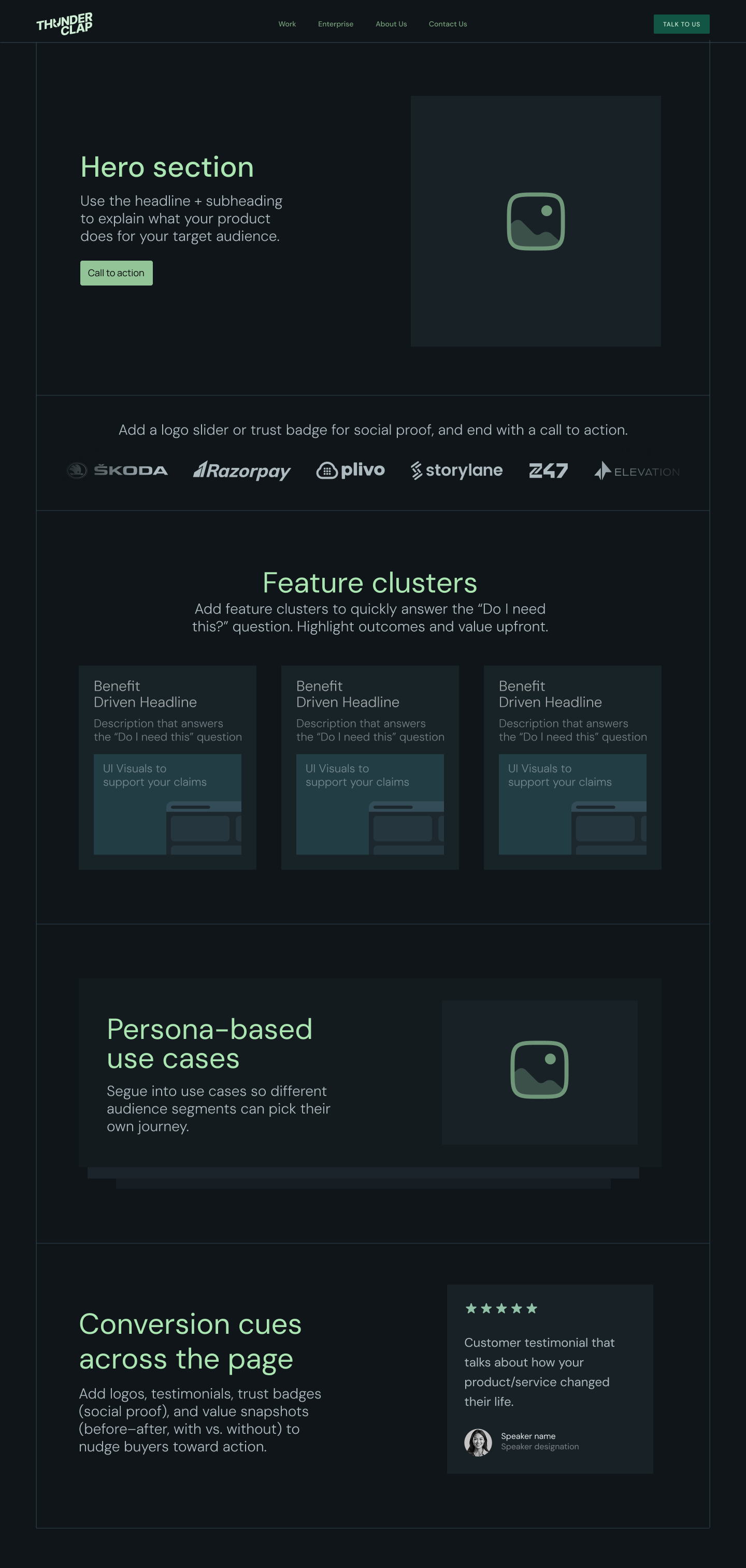
Sections to include:
1. Hero section: Use the headline + subheading to explain what your product does for your target audience. Add a logo slider or trust badge for social proof, and end with a call to action.
2. Feature clusters: Add feature clusters to quickly answer the “Do I need this?” question. Highlight outcomes and value upfront.
3. Persona-based use cases: Segue into use cases so different audience segments can pick their own journey.
4. Conversion cues across the page: Add logos, testimonials, trust badges (social proof), and value snapshots (before–after, with vs. without) to nudge buyers toward action.
Example: Storylane’s product page
2. B2B pricing page

Sections to include:
- Value-driven hero section: Use the headline + subheading to answer the “What am I looking at and why should I care?” question.
- Pricing table: Let buyers toggle between annual/monthly plans (show annual by default). Under each tier, include the price, key features, and a CTA like “Start Free Trial” or “Buy Now.”
- Feature-comparison table: Compare features included in each tier to give buyers a clear idea of what they’re getting.
- Interactive estimator (optional): Add an estimator if pricing is usage-based to help buyers model their cost.
- Social proof: Add logo sliders, trust badges, and testimonials that highlight functional and quantifiable benefits.
- FAQs: Use this section to address common objections related to pricing.
Example: Coda.io’s pricing page
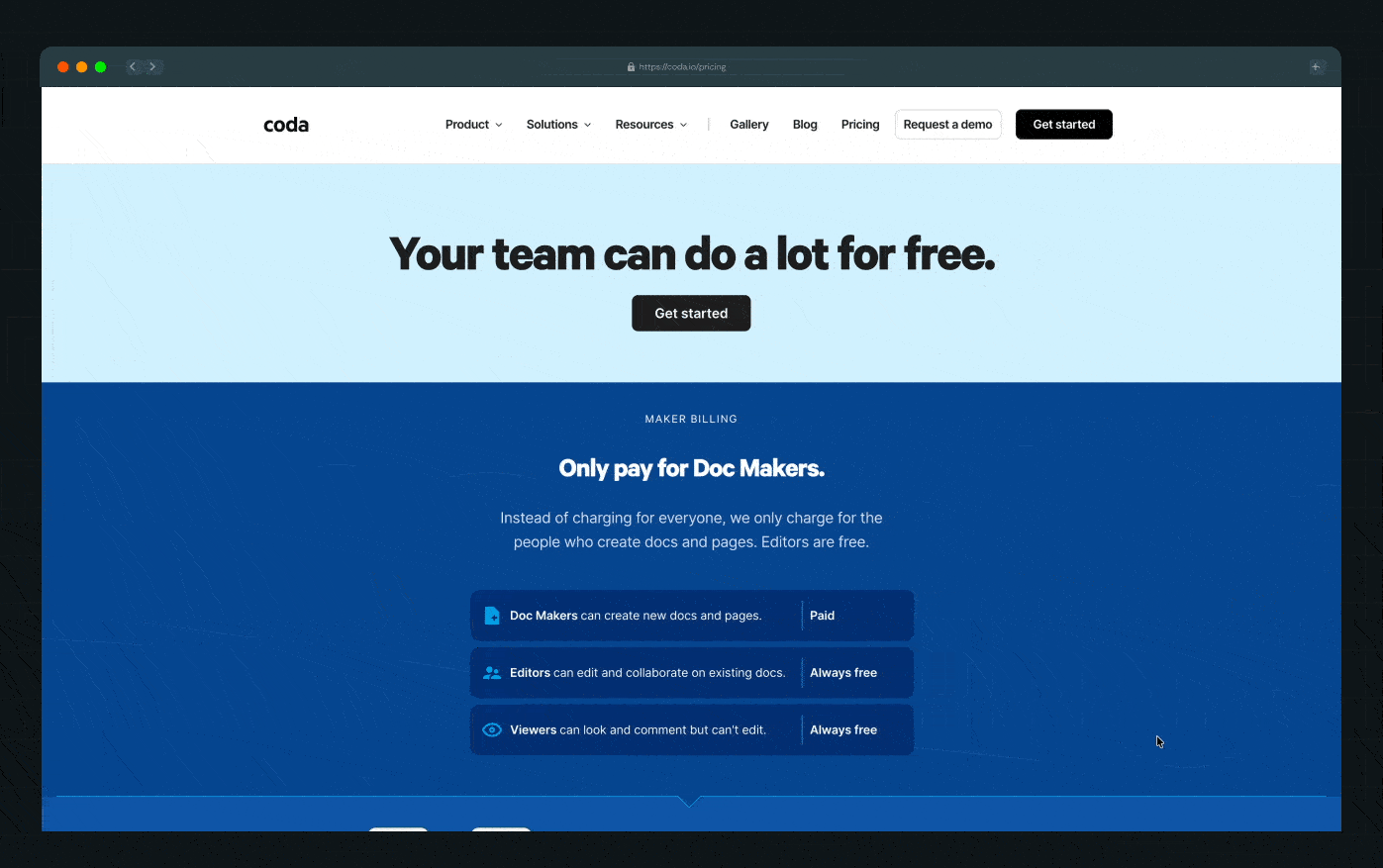
3. B2B demo request page

Sections to include:
1. Result-driven headline: Highlight the key reason customers choose you. Use numbers to increase impact.
2. Benefit-driven subheadline: Add functional and quantifiable benefits to support the claims made in the headline.
3. Social proof: Use testimonials and customer logos to reinforce the impact your product delivers.
4. Demo request form: Keep form fields under five and ask only for essential details to reduce friction.
Example: ThunderClap’s demo request page
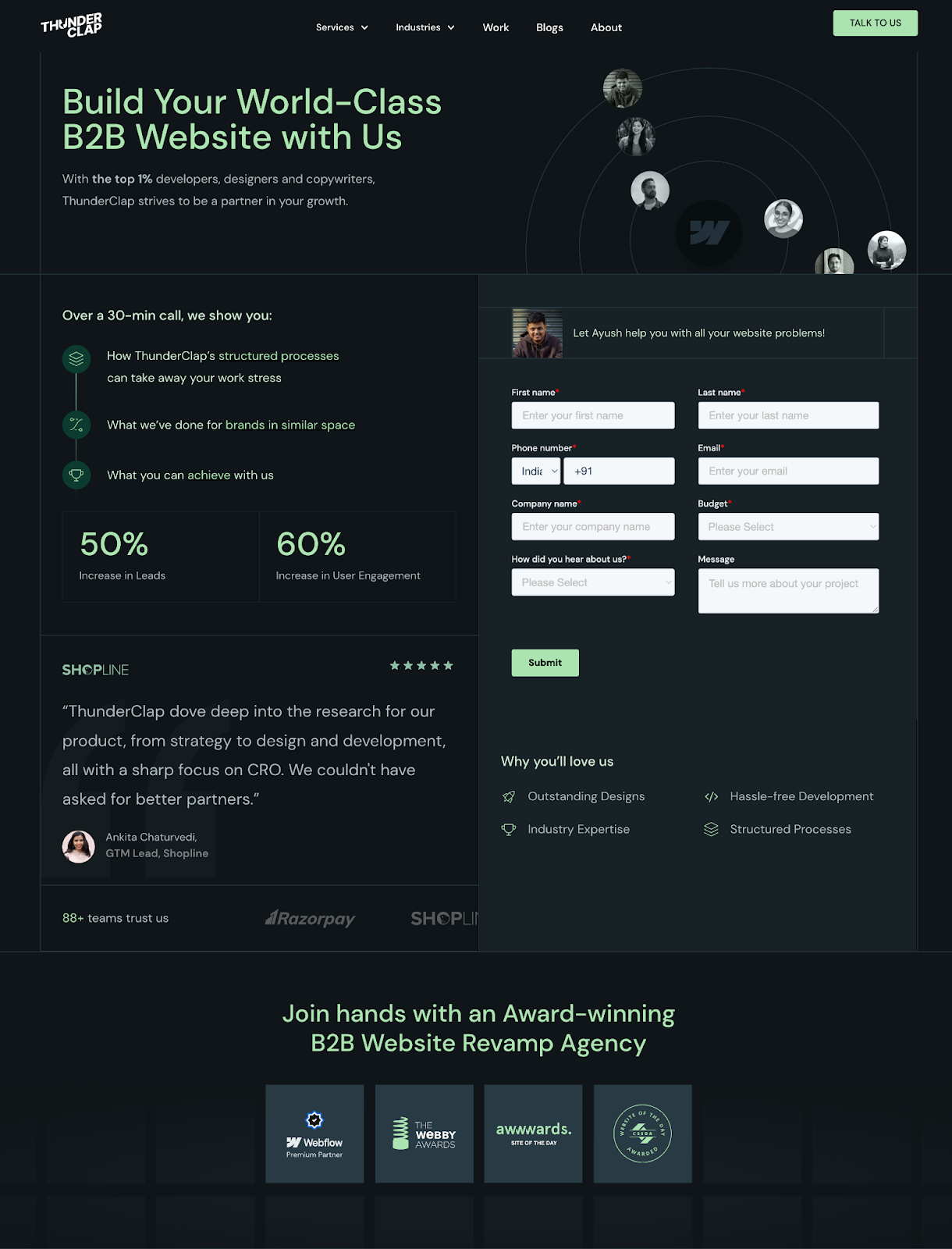
3 things to keep in mind while writing website copy
Knowing your audience doesn’t automatically result in great copy. These days, a lot of brands make a conscious effort to ‘know your audience,’ but only a few successfully communicate their offering in a language the audience understands.
“Somewhere between the positioning decks, one-pagers, product launches, copy variations, the meaning gets lost”, says Diane Wiredu, messaging strategist and founder of Lion Words.
So, how can you ensure your messaging doesn’t get lost in translation?
Meet your target audience at their awareness level
Your audience’s awareness level (problem, solution or product aware) is linked to your product category and their market familiarity. Find this early on and write for those belonging to that ‘specific awareness level’.
Example
Asana, a project management tool, caters to a solution-aware audience who wants to know how it stacks against competitors.

Here, the copy and the CTA focus more on ‘solving the problem’ rather than the product.
Slack, a popular collaboration tool, on the other hand, caters to a product-aware audience who is curious to uncover the ‘What’s In It For Me’s (WIIFT).

Here, the focus is on the product and the difference it makes.
{{specficService}}
Don’t always jump to the ‘how’ before ‘what’
This is the quickest way to make buyers bounce unless you are category leaders or catering to a product-aware audience. When you delve deep into the product features with screenshots and visuals, you overwhelm problem-aware or solution-aware buyers.
Instead, follow a logical hierarchy, starting from the what and why before explaining the how part. In other words, talking to pain points before offering a solution helps them feel more seen and heard.
Example
Pipedrive’s homepage is an excellent example of the ‘what → why → how’ logical flow. The hero section states what the product does, testimonials paired with benefits explain the why, and the final detailed features section focuses on the how. It also addresses two audience segments, solution-aware users (who have used CRMs) and product-aware users (who haven’t), educating each without overwhelming or boring them.
Not all benefits matter to your audience
Not every benefit makes your audience tick. Focusing on the wrong ones either turns into a boastful list of bells and whistles or the clichéd ‘time-money-effort saving’ white noise.
You can avoid this by using what Diane Wiredu calls the Goldilocks Rule. According to her the trick is to “find your sweet spot between technical jargon and generic fluff — where your message is specific enough to be relatable, but broad enough to connect to a tangible outcome your buyers care about.”
Example
Here’s an example from Wiredu’s LinkedIn post, where she explains the concept using the time-tracking software brand Toggl.
Notice how the messaging gets either jargony or vague as we move along the specificity spectrum. This means the key is to tap into the sweet spot between primary and secondary benefits, showing what your product does without listing features.

At ThunderClap, we use the CERTTN audit (Clarity, Explain, Resonate, Tie, Trust, Next Step) to ensure we put these principles into action. Asking these questions helps us spot messaging gaps costing conversions.

Final Thoughts: Can you use AI for website copywriting?
With AI reducing business operational costs by 30% and efficiency by 40%, there’s no reason to keep AI at bay. In fact, a recent study by Superside shows that using AI in copywriting delivers 30–40% efficiency gains.
But, if you plan to use it as a replacement for website copywriters, think twice. Doing this results in boilerplate website copy that may look good but fails to connect with buyers.
Wiredu’s recent experiment on using AI to write a B2B SaaS homepage captures this plight accurately. The copy she generates looks like actual B2B copy but is filled with generic, and lofty sections that are just placeholders.
However, the results are quite promising when you use AI as an ally while copywriting. The best use case to explain this would be how we use AI at ThunderClap for website copywriting. We integrate it into our workflow to automate repetitive tasks in the research, ideation and testing phase, so our copywriters can do what they do best - write compelling copy.
Want to know more about ThunderClap’s copywriting approach and the results we’ve delivered? Book a call with us today!
FAQs
1. What are the steps to write high-converting website copy?
Here are the steps you should follow to create high-converting website copy:
- Create ICP profiles and know their triggers, pains, results, and values.
- Map out their customer journey to ensure the website copy resonates with them.
- Finalize your brand personality by identifying your brand voice and archetype.
- Figure out your value proposition to stand out from competitors.
- Identify the goal of the webpage and ensure the copy aligns with this goal.
- Write, test, refine, and repeat for high conversions.
2. How to write copy for a service page?
Here are the steps to write copy for a service page:
- Value-driven hero section: Headline + subheadline + supporting visuals to convey the key value prop.
- Challenges section: Use this section to create a rapport with your audience by listing their pain points.
- Solutions section: List specific benefits to showcase your service as the answer to all their pain points.
- Social proof: Add necessary social proof in the form of testimonials, logos, and trust badges.
- Compelling CTAs: Add CTAs at strategic locations to drive conversions.
3. How to write copy for a homepage?
Here are the steps to write copy for a homepage:
- Value-driven hero section: Highlight the primary value proposition here. Add some social proof and CTA.
- Feature-cluster blurbs: Introduce the main feature clusters here. Use this real estate to drive buyers to respective product pages.
- Social proof: Add detailed testimonials and case studies that highlight functional and quantifiable benefits.
- Final CTA: Rehash the primary value proposition here as well.
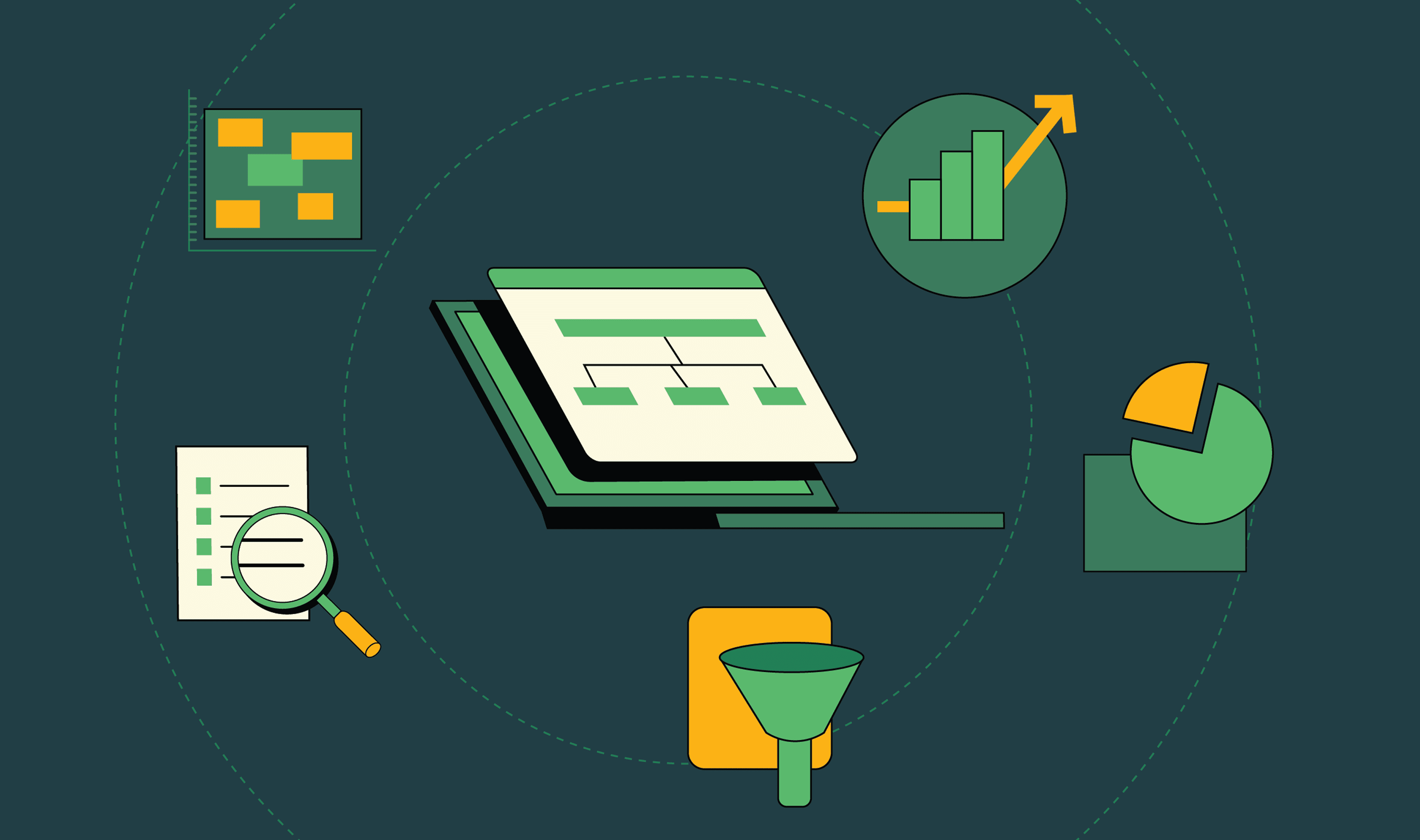
10 Top Website Analytics Tools for Measuring User Behaviour
You can redesign a landing page and feel great about it. Or you can redesign a page and prove it moves revenue. Successful SaaS website revamps are the latter: you diagnose friction with replays, quantify impact with event-driven analytics, and validate fixes with experiments.
The right website analytics stack provides you with the visibility (and proof) that your website revamp was successful.
In this guide, I’ll walk you through the 10 best website analytics tools that SaaS teams like yours can use right now. We will also discuss what each tool does best, new 2025 features, micro plays for each tool, and the right tech stack based on your needs.
How SaaS teams should choose website analytics tools (quick framework)
Despite the hype, the reality is that no single tool will give you the full picture. Which means the smarter move is to stack tools by layer, not try to force one tool to do it all.
At ThunderClap, we think of analytics as three complementary functional layers that need to work together:
- Numbers (quantitative): Tools in this layer capture hard data on traffic, funnels, retention, and activation. They give you the what at scale.
- Behavior (qualitative): These reveal how users actually interact with pages through replays, heatmaps, and feedback. They explain the why behind drop-offs or confusion.
- Experiments (validation): This layer lets you test and validate changes with real users before committing fully. It ensures design and messaging choices lead to measurable impact.
When choosing their website analytics stack, we advise our clients to align by Stage × Function × Integration need:
- Startup (0–$5M ARR): Keep it lean with a baseline quantitative tracker, one behavioral tool, and lightweight user feedback.
- Scale-up ($5M–$50M ARR): Add deeper product analytics, automated event capture, and controlled experimentation for CRO.
- Enterprise ($50M+ ARR): Expand to advanced analytics stacks with strong governance, server-side testing, and privacy-first hosting (especially for EU compliance).
At ThunderClaps, this is how we run every revamp audit: start with baseline tracking, map ICP journeys through both numbers and behavior, and then design experiments that prove uplift before rolling changes live. It’s this data-first, validation-driven approach that helps us consistently deliver measurable conversion lifts for our clients.
You need one tool for numbers, one for behavior, and one for experiments when you have traffic to support valid tests. Anything beyond that should be justified by a clear ROI — not just curiosity or tool sprawl.
Top website analytics tools in 2025: Side-by-side comparison
For the skimmers, here’s the comparison table so you can see how the top website analytics tools stack up before the deep dive.
| Tool | Best For | Key 2025 Features | Notable Integrations | Pricing Band | Limitations (SaaS Revamp Lens) |
|---|---|---|---|---|---|
| Google Analytics 4 (GA4) | Mid-market & enterprise SaaS with event maturity | Report annotations, Consent Mode V2, “Time to First Action,” Reddit Ads cost import | BigQuery, Looker Studio, GTM, Google/Reddit Ads | Free (up to ~100M events/yr); GA360 enterprise (custom) | Steep learning curve; needs disciplined event design |
| Google Search Console (GSC) | SaaS startups revamping SEO funnels | Insights tab tying search queries → engagement; improved trend tracking, CTR/engagement data | Native GA4 link | Always free | Purely SEO; no behavior analytics |
| Microsoft Clarity | Startups & mid-market SaaS needing UX diagnosis | Unlimited replays, AI traffic grouping, replay annotations, frustration detection | GA4, API-based | Always free (no session caps) | Limited KPI/quant analytics compared to paid tools |
| Hotjar | Growth & UX teams running targeted CRO experiments | AI summaries of survey/poll responses; heatmaps, replays, polls, Slack/HubSpot/Jira support | Slack, HubSpot, Jira, CRM stack | Free (35 sessions/day); Plus $39/mo, Business $99/mo, Scale $213/mo | Session caps; scales expensive with traffic |
| VWO | Mid-market SaaS scaling CRO | AI Copilot for variation creation, automation triggers, mobile app funnels & tap heatmaps | GA4, Mixpanel, Heap, HubSpot, Salesforce, Segment | Free Starter; Paid: Growth, Pro, Enterprise (varies by usage/product mix) | Mobile testing limited; advanced features locked to higher tiers |
| Optimizely | Enterprise SaaS with dev/eng resources | AI agents for campaign briefs, Opal AI assistant, GEO-ready CMS, feature flags | Enterprise CMS, data warehouses, personalization APIs | Enterprise only, fully custom | Costly; overkill for smaller SaaS |
| Mixpanel | PLG SaaS startups & scale-ups | AI query tool (MCP), Metric Trees, Experimentation 2.0, expanded session replays, heatmaps | Segment, CDPs, Snowflake/BigQuery/Databricks | Free (1M events/mo); Paid: Growth $0.28/1k events, Enterprise custom | Complex setup; manual event tracking; not built for attribution |
| Lucky Orange | SaaS needing UX analytics + live engagement | Lucky Orange Discovery AI (auto “optimization opportunities”), chat + polls integration | HubSpot, GA, Zapier | Free (100 sessions); Paid: Build $39/mo, Grow $89/mo, Expand $229/mo, Scale $899/mo, Enterprise custom | Busy UI; pricing rises steeply with scale |
| Matomo | SaaS in compliance-heavy industries (EU, gov, health) | Redesigned dashboard, Total Hits metric, stronger password/token controls, improved Tag Mgr | WordPress, GA4 import, APIs | On-premise free; Cloud from $23/mo, Enterprise custom | UI less polished; self-hosting requires maintenance |
| Kissmetrics | SaaS teams needing revenue-linked analytics | CRM/billing integrations, redesigned funnels, warehouse sync, advanced cohort/churn reports | CRMs, billing systems, warehouses | Bronze $25.99/mo (10k events); Silver $299/mo (2M events); Enterprise custom | Setup complexity; steeper learning curve for advanced reports |
{{specficBlog}}
The 10 top website analytics tools in 2025 (and how to use them)
Before we jump into the details, here’s how we approached this guide: we looked at what’s new in 2025, how each tool supports a website revamp, and where it delivers the most ROI. Each profile is a quick buyer’s guide plus a practical play you can use right away.
1. Google Analytics 4 (GA4)

If you’re running a SaaS website in 2025, GA4 is the foundation. It’s not perfect (and yes, it’s more complex than old Universal Analytics), but it gives you the broadest view of acquisition and funnels.
Say you’ve just revamped your pricing page. Traffic looks good, but conversions? Flat. With GA4, you pull a funnel: pricing_view → trial_start → trial_activate. You see, the drop is at trial activation, not pricing. Your problem isn’t design (it’s onboarding).
What’s new in Google Analytics 4 (GA4) in 2025?
This year, GA4 added features that actually make life easier: report annotations, scheduled dashboards sent straight to your inbox, Consent Mode V2 for privacy compliance, and extra ad-cost imports (e.g., Reddit Ads).
Our favorite is “Time to First Action”, a metric that shows how quickly signups actually start using your product.
GA4 Best-fit ICP: Mid-market and enterprise SaaS with event tracking maturity
Google Analytics 4 (GA4) pricing
- Free plan: covers most SaaS teams up to ~100M events/year
- GA360 plan: enterprise-grade, custom pricing; useful above $50M ARR for SLAs and cross-org rollout
Google Analytics 4 (GA4) Pros
- Deep integration with the Google stack
- Strong ML/predictive features
- Direct BigQuery export for custom modeling
Google Analytics 4 (GA4) Cons
- Steeper learning curve than UA
- Requires disciplined event taxonomy and engineering support for clean data
📊 GA4 Micro-Play: Track trial_start → trial_activate → paid_conversion. Send to BigQuery and run cohort reports on D30 conversion.
🎯 KPI to track: Trial-to-paid conversion by acquisition source.
2. Google Search Console (GSC)

GSC is Google’s free SEO analytics tool that helps SaaS teams decide which pages deserve a facelift. It shows key metrics like impressions, clicks, CTR, and average position (so you know what’s visible but underperforming). For example, if “best project management SaaS” gets 10k impressions but only a 3% CTR, the page is ranking but not attracting clicks.
That’s a clear signal it’s a revamp priority (tweak headlines, images, or page content to better match search intent).
What’s new in Google Search Console (GSC) in 2025?
GSC remains the canonical source for search performance. In 2025, the new Insights tab ties search queries directly to engagement metrics. Finally, you can tell if your “#3 keyword ranking” is sending buyers… or bounce-happy tire kickers.
We also love query-level CTRs, impressions, and engaged session metrics. They have improved on visual trend tracking and milestone messaging too.
GSC Best-fit ICP: SaaS startups revamping SEO-driven content funnels
Google Search Console (GSC) pricing
- Always free
Google Search Console (GSC) Pros
- Detailed search query insights
- Tracks index coverage + Core Web Vitals
- Connects queries to engagement signals
Google Search Console (GSC) Cons
- Not a substitute for behavioral analytics; pairs best with GA4
📈 GSC Micro-Play: Create a revamp priority list from pages with >5k impressions and <3% CTR. Start there.
🎯 KPI to track: CTR and average position for your top 20 queries.
3. Microsoft Clarity

If GA4 tells you what happened, Microsoft Clarity shows you how. This free website analytics tool offers unlimited replays and heatmaps, which are ideal for identifying UX friction during and after a revamp.
Say, during your website revamp, you launch a new signup form. Conversion drops. Instead of guessing, you watch 20 recordings — and notice users rage-clicking the “Next” button. Turns out the form had a hidden error.
And it’s 100% free, with no traffic caps.
What’s new in Microsoft Clarity in 2025?
The 2025 updates are built for teams: AI now groups traffic channels (yes, even AI search traffic), and you can add annotations to session replays. Now, when you launch “new signup flow v2,” your team knows exactly when the change happened. You can also use Copilot to get AI-generated summaries to effortlessly condense hours of session recordings and heatmaps into actionable insights.
Microsoft Clarity Best-fit ICP: Startups and mid-market SaaS needing UX diagnosis at scale
Microsoft Clarity pricing
- Always free (no session caps)
Microsoft Clarity Pros
- Unlimited replays
- Super easy setup
- AI frustration detection
Microsoft Clarity Cons
- Less advanced KPI analytics than paid platforms
- Doesn't capture all user sessions. Sometimes heatmaps don't have the entire screenshot, so you can't make judgments about user behaviour accurately.
🖥️ Microsoft Clarity Micro-Play: Auto-flag sessions with signup_start but no signup_complete. Review 30 per week; feed into UX backlog.
🎯 KPI to track: Decrease in rage-click and drop-off incidents at signup.
4. Hotjar

Numbers show what. Replays show how.
Hotjar answers the why. Hotjar blends behavioral analytics with user feedback. It is our go-to for surveys, polls, and heatmaps. We use it religiously for SaaS revamps because it reveals both what happened and why. It is your hack to enable targeted CRO on high-value SaaS pages (pricing, onboarding).
What’s new in Hotjar in 2025?
In 2025, Hotjar goes beyond heatmaps, replays, and polls with AI summaries that cluster user feedback into themes. Translation: you get the top three user blockers without wading through hundreds of survey responses.
We also love their Slack, Jira, HubSpot, and CRM integrations.
Hotjar Best-fit ICP: Growth and UX teams running targeted experiments on pricing, onboarding, and CTAs
Hotjar pricing
- Free plan: track up to 35 daily sessions
- Plus plan (up to 100 daily sessions): $39/month
- Business plan (up to 500 daily sessions): $99/month
- Scale plan (above 500 daily sessions): $213/month
Hotjar Pros
- Fast feedback capture
- Built-in polling and heatmaps
- AI summarization helps prioritize
Hotjar Cons
- Recording/response caps on free plans
- Costs rise substantially with traffic
📊 Hotjar Micro-Play: Exit poll on pricing page: “What stopped you from starting a trial?” Summarize with AI → fix top 2 blockers.
🎯 KPI to track: Trial starts from the pricing page.
5. VWO

How many times have you launched a redesign, shipped it, and prayed it would perform better? With VWO, you don’t have to pray. You can test before going all in.
VWO is a comprehensive experimentation and conversion rate optimization (CRO) platform. That provides the controlled testing environment needed to validate changes before rolling them out.
The business value is also in improving trial-to-paid funnels with targeted CRO experiments. You can track the ROI of experiments, making growth decisions data-driven.
What’s new in VWO in 2025?
In the 2025 feature rollout, we love the AI-powered VWO Copilot for automated variation creation, as well as time-based and metric-based automation for safer deployments. You will also like its mobile app optimization features, including app funnels and heatmap tap filters.
VWO always had integrations with GA4, Mixpanel, Heap, HubSpot, Salesforce, and Segment. Recent updates also include platforms like Microsoft Clarity and Firebase Crashlytics, and a new, more intuitive campaign creation flow to streamline testing.
💡 Pro Tip: Start simple: headlines, CTAs, button color. Don’t dive into multivariate madness until you’ve nailed the basics. Always tie experiments back to ROI!
VWO Best-fit ICP: Mid-market SaaS scaling CRO
VWO pricing
- Free starter plan with unlimited experimentation
- Also available in Growth, Pro, and Enterprise plans (pricing based on product mix)
VWO Pros
- No-code editor
- AI-driven optimization ideas
- AI for content (generate survey questions and even create different copy variations for A/B testing) & analysis (summarize qualitative feedback)
- ROI tracking
VWO Cons
- Higher-tier features require paid plans
🧪 VWO Micro-Play: A/B test CTA copy: “Start free trial” vs. “Start free trial. No credit card.”
🎯 KPI to track: Conversion lift and 14-day retention for experiment cohorts.
6. Optimizely

If you’re an enterprise SaaS with engineering muscle, Optimizely is your friend. It is built for engineering-led experimentation. Think feature flags, server-side tests, and ML-powered traffic allocation.
What’s new in Optimizely in 2025?
In 2025, Optimizely is going all-in on AI to make experimentation and marketing workflows faster and smarter. Instead of manually setting up every test or campaign, you can now drag-and-drop AI agents that handle tasks like campaign briefs, keyword research, or experiment plans. The new Opal AI assistant lives inside the platform, helping teams summarize test results or even generate on-brand visuals on the fly. Optimizely’s CMS is also GEO-ready.
Optimizely Best-fit ICP: Large SaaS with engineering teams and complex systems
Optimizely pricing
- Enterprise only; custom pricing based on traffic and scale
Optimizely Pros
- Server-side and client-side experimentation
- ML-powered traffic allocation
- Advanced feature flagging and progressive rollouts
- Personalization based on user segments
- Enterprise-grade integrations
Optimizely Cons
- Costly and complex to implement
- Overkill for small teams.
⚡ Optimizely Micro-Play: Roll out a new onboarding flow to 10% of users with feature flags; measure activation and rollback if needed.
🎯 KPI to track: Activation lift and regression rate in control vs. variant.
7. Mixpanel
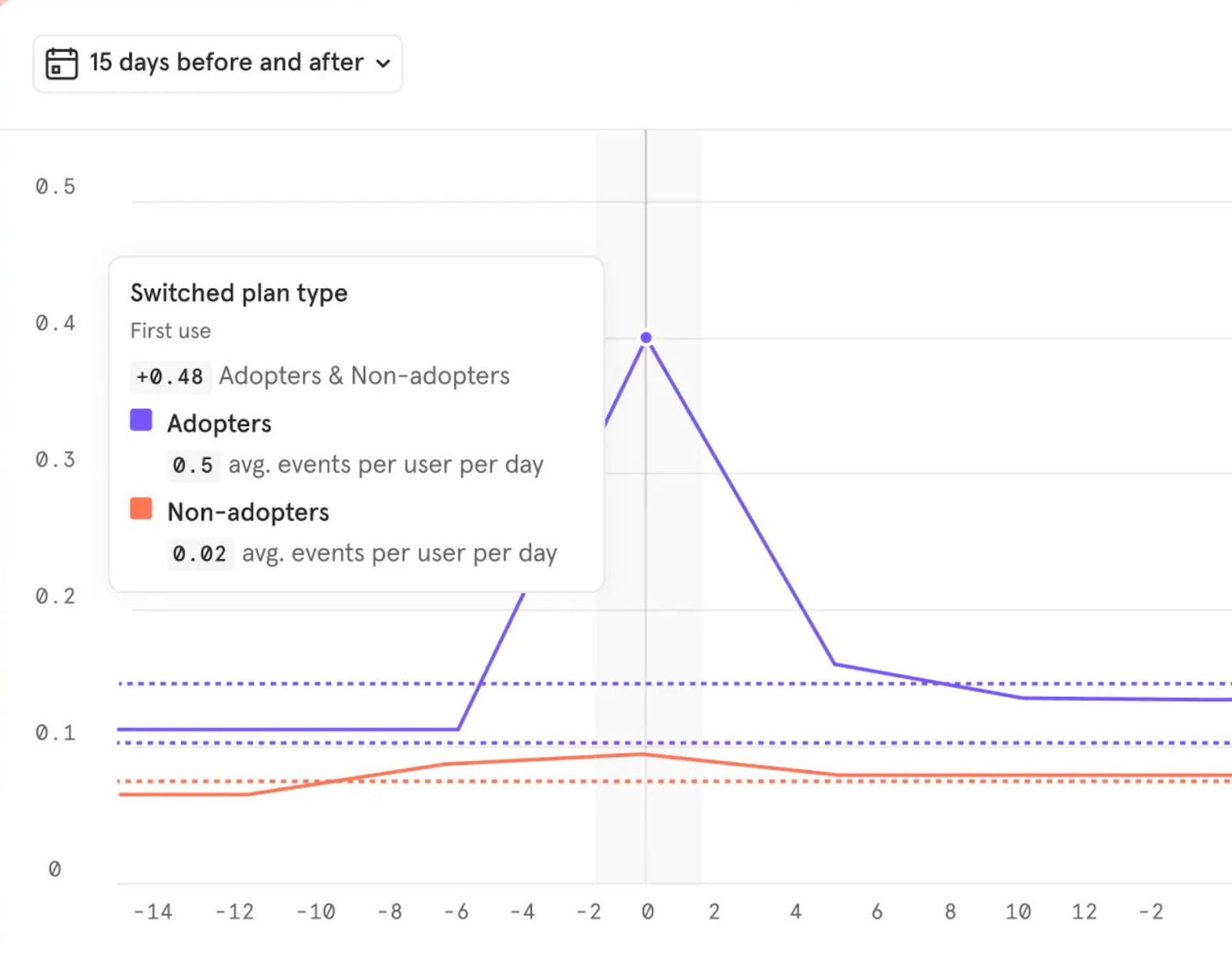
Mixpanel is perhaps the best website analytics tool at answering: “Do users who try X upgrade more?”
It is a behavioral analytics tool built for SaaS companies, especially those running product-led growth (PLG). Mixpanel excels at cohort analysis and retention. It provides deep insights into activation, retention, and upgrade behaviors.
What’s new in Mixpanel in 2025?
Mixpanel’s 2025 updates are all about making analytics smarter, faster, and easier to act on. With the new AI query tool (MCP), you can literally ask your data questions in plain English and even let other AI tools pull insights directly. On the experimentation side, features like Metric Trees and a reworked Experimentation Reporting help product teams see how engagement ladders up to business goals and ship with more confidence.
Mixpanel also expanded session replays to mobile and added heatmaps for web, bringing qualitative context into the same platform.
Mixpanel best-fit ICP: PLG startups and scale-ups focused on activation and retention
Mixpanel pricing
- Free: up to 1M events/month.
- Growth plan: Usage-based: $0.28 per 1k events beyond free
- Enterprise plan: custom plans for large volumes
Mixpanel Pros
- Deep behavioral analytics, real-time insights
- Powerful, customizable funnels and dashboards
- Identifies individual user journeys
- Generous free plan available
Mixpanel Cons
- Steep learning curve, complex implementation
- Requires manual event tracking
- Limited qualitative user understanding
- Not ideal for marketing attribution
🚀 Micro-Play: Identify first_value_action (the in-product event most correlated with upgrades) and design your revamp to surface it earlier.
🎯 KPI to track: D7/D30 retention and upgrade propensity by cohort.
8. Lucky Orange
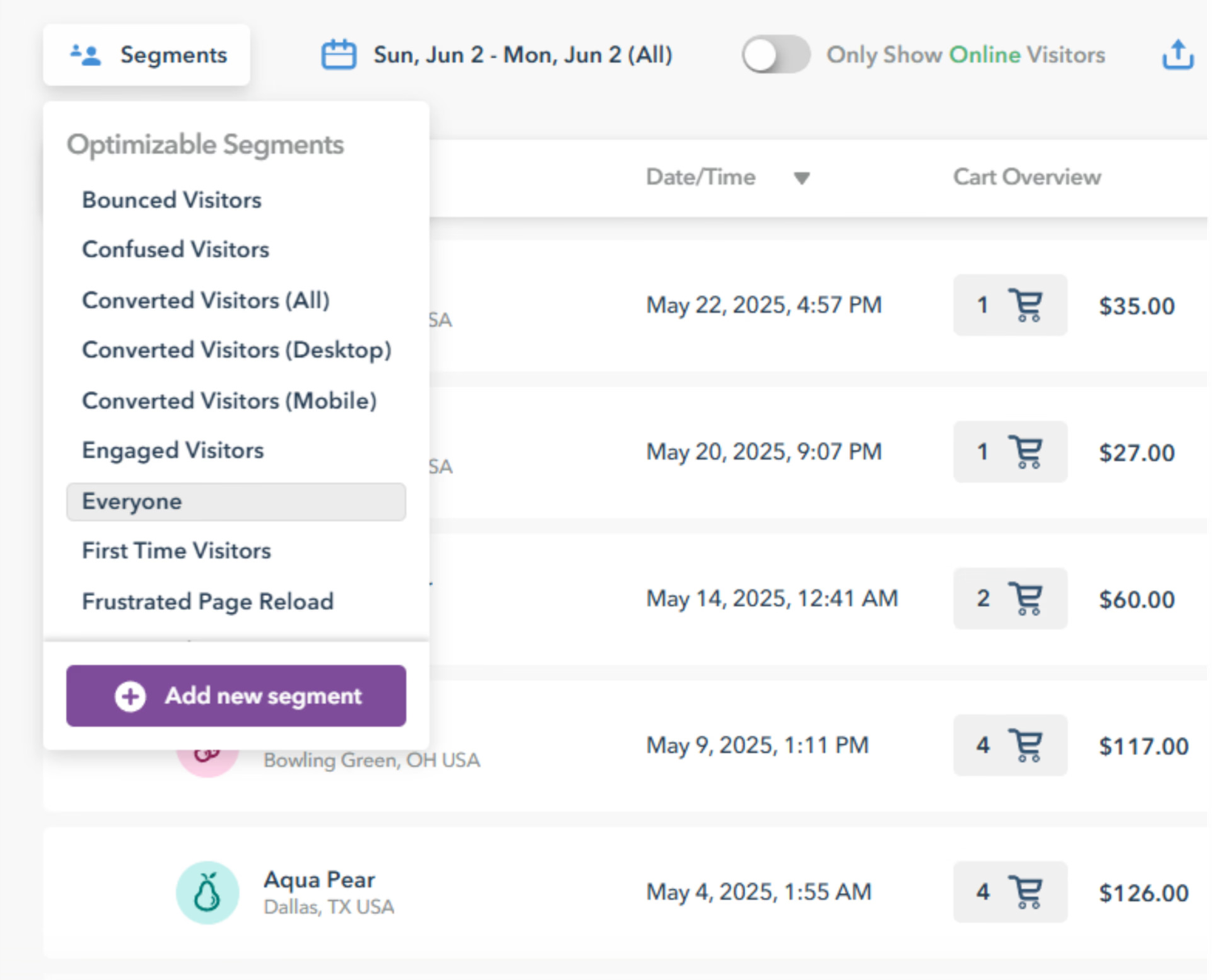
Lucky Orange is an all-in-one conversion optimization and behavioral website analytics platform. For SaaS teams revamping websites, it’s especially valuable because it blends diagnostics (heatmaps, replays) with engagement tools (chat, polls, surveys). It lets you both understand problems and intervene before users churn.
The business value is faster insights into funnel leaks, improved onboarding flow conversions, and the ability to recover trial users in real time.
What’s new in Lucky Orange in 2025?
The headline update for 2025 is Lucky Orange Discovery, an AI-powered tool launching in summer 2025. Discovery automatically scans your customer journey and highlights specific optimization opportunities (essentially surfacing “where you’re leaking conversions” in plain English). Instead of manually piecing together heatmaps and funnels, you get packaged insights that tell you what needs attention and why.
Lucky Orange Best-fit ICP: SaaS businesses needing combined UX analytics + live engagement.
Lucky Orange pricing
- Free plan (100 sessions/month)
- Build plan: $39/month
- Grow plan: $89/month
- Expand plan: $229/month
- Scale plan: $899/month
- Enterprise plan: Custom
Lucky Orange pros
- Combines analytics + engagement (chat, polls)
- Tight CRM integrations (HubSpot saves time)
- Affordable entry tiers
Lucky Orange cons
- Pricing rises quickly with scale
- The interface can feel busy for new users
💬 Micro-Play: Set up a funnel from Landing → Pricing → Signup. Add a live chat prompt on the pricing page for visitors who linger >30s.
🎯 KPI to track: Increase in demo requests or trial starts from high-intent visitors.
9. Matomo

Matomo is a privacy-first website analytics tool that combines all the essentials (funnels, cohorts, goal tracking, heatmaps, and session replays) with enterprise-grade governance. Unlike mainstream analytics tools, it gives you 100% data ownership (whether you host it yourself or use Matomo Cloud), so you always know where data lives and how it’s used.
What’s new in Matomo in 2025?
You can now enforce strong passwords, set custom token expiry, and receive alerts for inactive accounts. You can also monitor multiple sites more easily with the redesigned All Websites dashboard, which adds a cleaner layout and a Total Hits metric for quick traffic checks. And with new Tag Manager variables and smoother usability, you can track behavior more flexibly across your SaaS site.
Matomo Best-fit ICP: SaaS organizations where compliance and user trust are non-negotiable (EU-focused, enterprise, healthcare, finance, gov-tech)
Matomo pricing
- On-premise (self-hosted) plan: Free, open-source (you own the infrastructure)
- Cloud plan: Starts $23/month, scales with traffic volume
- Enterprise plan: Custom (adds SLAs, priority support, and compliance extras)
Matomo Pros
- 100% data ownership (you control where it’s stored)
- Fully GDPR/CCPA compliant, no data sampling
- Import GA4 data directly
- Unlimited websites, users, and segments
Matomo Cons
- UI is less polished than GA4 or Mixpanel
- Self-hosted requires ongoing maintenance
📊 Micro-Play: Import GA4 history into Matomo to maintain long-term reporting continuity. Then enable Consent Mode 2.0 to stay fully compliant while tracking funnel performance pre- vs. post-revamp.
🎯 KPI to track: Trial activation rates under fully compliant, unsampled data conditions.
10. Kissmetrics

If GA4 feels built for marketers, Kissmetrics feels built for SaaS. It’s designed specifically for tracking SaaS customer journeys (from first website visit to trial activation, and all the way through retention and upsell). Unlike general web analytics, Kissmetrics gives you people-level tracking. You can follow individual users across sessions and devices, so you don’t just see anonymous pageviews
The business value is better visibility into lifetime value (LTV), churn risk, and the trial-to-paid funnel (the metrics SaaS leaders actually care about).
What’s new in Kissmetrics in 2025?
In 2025, Kissmetrics added tighter CRM and billing integrations, making it easier to link product activity with revenue. You can build more precise cohort and churn reports, and the redesigned funnel reporting makes leaks obvious at a glance. New data pipeline options also let you sync behavioral data directly into warehouses for broader analytics stacks.
Kissmetrics Best-fit ICP: SaaS teams needing revenue-linked behavioral analytics
Kissmetrics pricing
- Bronze plan (up to 10000 monthly events): $25.99/month
- Silver plan (up to 2,000,000 monthly events): $299/month
- Enterprise pricing available for larger SaaS teams.
Kissmetrics Pros
- Strong, responsive customer support
- Excellent for tracking the full customer lifecycle
- Robust analytics with customizable reporting
Kissmetrics Cons
- Setup can be difficult without analytics expertise
- Steeper learning curve for advanced features
📈 Micro-Play: After your revamp, build a funnel: Trial Start → Onboarding Complete → Upgrade to Paid. Use cohort reports to compare pre-revamp vs post-revamp performance.
🎯 KPI to track: Upgrade rate of onboarded users vs non-onboarded users.
Free vs paid website analytics tools: when should you upgrade?
If you’re under $1M ARR, stick with the free stack: GA4, Clarity, GSC. You’ll be shocked at how far it gets you.
You should push to paid website analytics tools when:
- Volume limit: You are at ~50–100k monthly events (free tiers begin to sample or cap retention).
- Analysis needs: You need D90 retention cohorts, raw event exports, or multi-touch attribution.
- Experiment scale: You are running multiple concurrent valid experiments or server-side flags.
💡 ROI Rule: If a paid tool’s expected lift in conversion pays for the annual subscription (e.g., a 1–2% lift in trial-to-paid at $3M ARR), upgrade.
Also read: SaaS Website Design That Converts: 7 Must-Have Elements to Win More Signups
Case in point: How ThunderClap revamped ConsultAdd’s website with analytics
ConsultAdd, a fast-growing HR consultancy, partnered with ThunderClap for a website revamp aimed at improving engagement and lead generation. We began with a 3-month analytics and UX audit. The data told a clear story:
- Traffic: ~7.6k visitors in 3 months
- Engagement: homepage average of just 12s
- Conversions: highest from direct traffic, but organic visitors stayed longer
- Forms: “Contact Us” dominated submissions, but CTAs were fragmented across four different touchpoints
- Pages: several sections had fewer than five visits in three months
From these insights, we recommended and implemented key changes:
- Consolidated four contact options into clear, ICP-specific forms
- Rebuilt messaging pillars to speak directly to employers (the primary ICP)
- Redesigned page flows for consistency and purpose, eliminating low-value sections
- Improved homepage trust signals and mobile UX
Here’s a before and after of their home page:
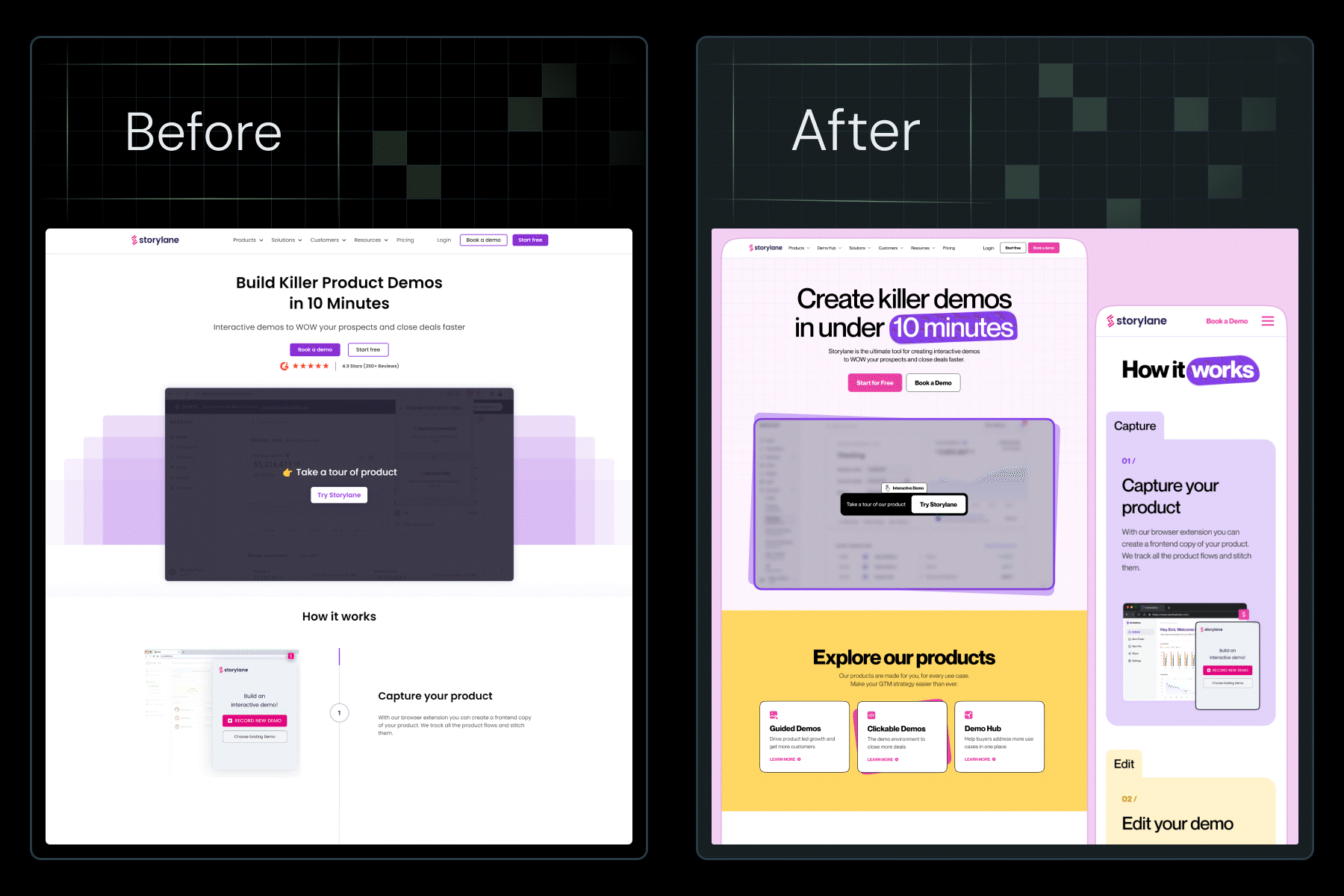
{{specficService}}
The impact: average engagement time rose 500% and form submissions increased by ~60%, giving ConsultAdd a significantly stronger inbound pipeline.
“The most important metric was the 60% increase in conversion. Once we realigned the site around the right ICP and streamlined the experience, analytics insights translated directly into business results.” - Kiran Kulkarni, Partner & Head of Growth at ThunderClap
Turn website analytics into a growth engine with ThunderClap
Using the top website analytics tools isn’t about number crunching and dashboards (it’s about making decisions). The right stack helps you spot where users hesitate, why conversions leak, and how to design pages that speak directly to your ICP.
That’s how we’ve helped brands like Amazon, Razorpay, and Storylane through 129+ B2B website revamps: turning raw data into consistent lifts in engagement and conversions.
Here’s a quick-start checklist for SaaS teams
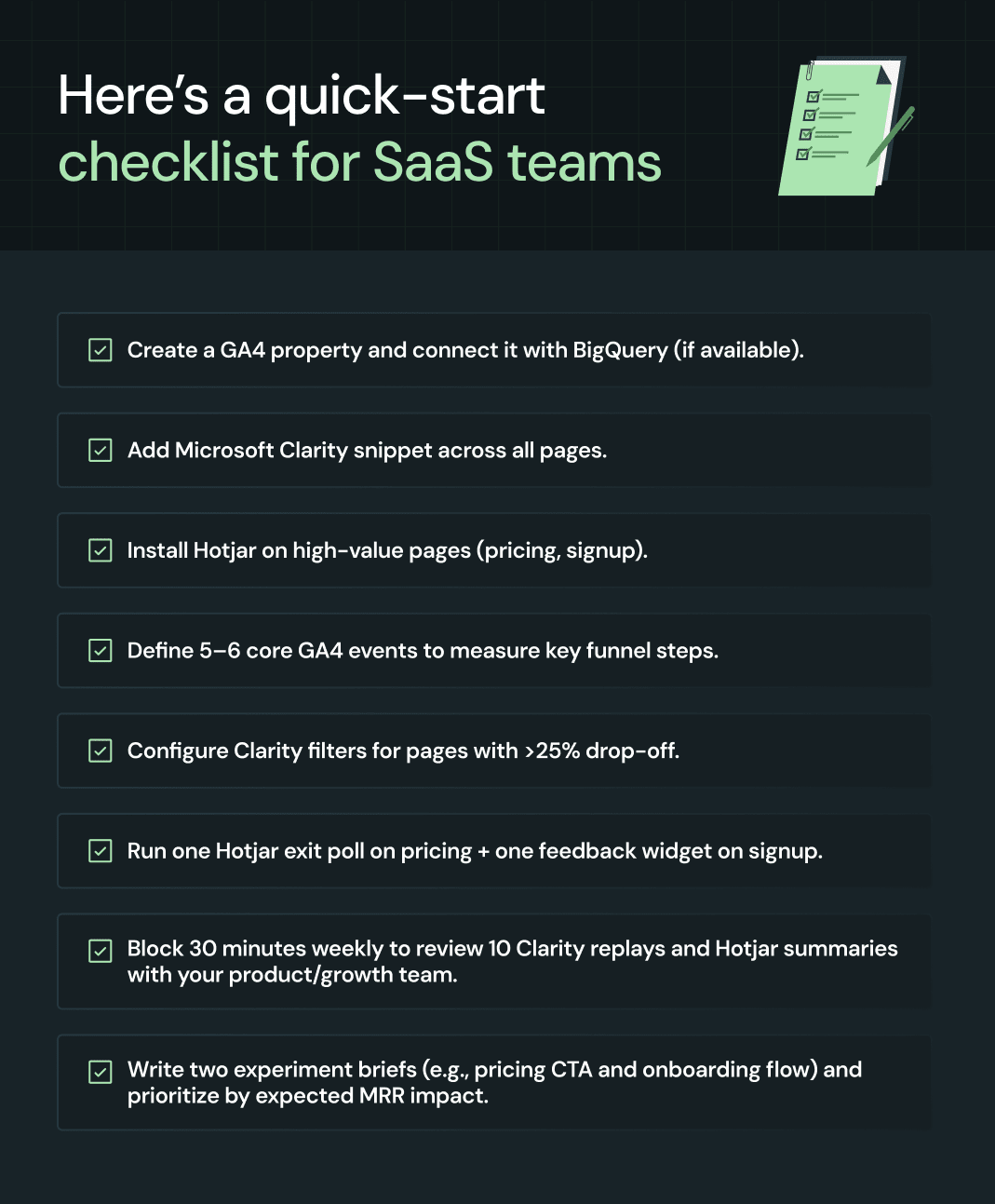
Even this lean stack will uncover friction points, surface ICP-specific insights, and kickstart meaningful experiments. But scaling analytics into a growth engine takes more than DIY. That’s where ThunderClap comes in. We bring the frameworks, CRO playbooks, and design + dev execution to translate analytics into measurable revenue outcomes.
Book a 30-minute consultation with us. We’ll map your current setup, pinpoint funnel leaks, and design a 90-day roadmap that shows exactly how to fix them.
FAQs
1. What are website analytics tools?
Website analytics tools are platforms that track and analyze how users interact with your site — from traffic sources and page views to funnels, heatmaps, and conversions. The top website analytics tools go beyond vanity metrics, giving SaaS teams insights into user behavior, ICP journeys, and where conversion leaks happen.
2. How do website analytics tools help improve conversion rates?
The best website analytics tools show you exactly where users drop off and why. For example, heatmap tools reveal where visitors get stuck, while product analytics platforms highlight which actions lead to upgrades. By combining quantitative tracking (GA4, Mixpanel) with qualitative insights (Hotjar, Clarity), SaaS teams can run targeted experiments, remove friction, and improve trial-to-paid funnels.
3. What features should you look for in a website analytics tool?
When choosing the top website analytics tools, look for three layers of functionality:
- Quantitative tracking → funnels, retention, event-based data (GA4, Mixpanel).
- Behavioral insights → replays, heatmaps, surveys (Hotjar, Microsoft Clarity).
- Experimentation features → A/B testing, personalization, ROI tracking (VWO, Optimizely).
- Other must-haves include integrations with your stack (CRMs, data warehouses, ad platforms), and privacy compliance.
4. What types of SaaS website analytics tools are available?
There are multiple types of SaaS website analytics tools, including:
- Product analytics (e.g., Mixpanel, Heap) to track feature usage and retention.
- User behavior analytics (e.g., Hotjar, Microsoft Clarity) for heatmaps and session replays.
- Web analytics (e.g., Google Analytics 4) for traffic and acquisition insights.
- Financial and revenue analytics (e.g., ProfitWell) for subscription metrics.
- Customer journey and engagement tools that combine data from multiple sources.
5. When should I upgrade from free to paid website analytics tools?
Typically, SaaS companies move from free to paid analytics plans when their data volume exceeds session/event limits of free tiers (often 50K-100K monthly events), or when they require advanced features like cohort analysis, retention tracking, real-time insights, deeply integrated marketing analytics, and regulatory compliance support.
6. How to ensure privacy compliance with website analytics tools?
SaaS companies adopt privacy-first analytics tools, implementing features like cookie consent banners, anonymized IP tracking, minimal PII collection, and GDPR/CCPA-compliant consent modes. Vendor management includes reviewing Data Processing Agreements (DPAs) and data residency options to meet evolving global privacy laws.
7. What are the best practices for integrating SaaS analytics tools?
Best practices include using data pipelines for raw data export (like GA4 to BigQuery), integrating customer data platforms (CDPs) such as Segment with product analytics tools (Mixpanel), combining behavioral tools (Clarity + Hotjar) for UX insights, and maintaining data governance with version control, incremental updates, and automated error monitoring to ensure data quality and timeliness.
8. What is the best free website analytics tool in 2025?
If you’re just starting out, Google Analytics 4 (GA4) and Microsoft Clarity together cover most needs. GA4 gives you quantitative funnels, while Clarity shows you unlimited session replays. For SEO insights, add Google Search Console (GSC). That free trio is enough to run a serious SaaS revamp under $1M ARR.

The B2B Web Design and Development Blueprint: Tips to Win More Clients
Most B2B websites are Frankensteins. Marketing wants a new campaign page, Product launches a new feature, and IT adds a “security” tab in the footer. After a year, you’ve got a bloated sitemap, conflicting styles, and a homepage where the headline tries to please everyone but ends up meaning nothing.
No wonder they don’t perform. The average visitor-to-lead conversion rate for B2B SaaS is ~1.4%. That means out of 1,000 visitors, just 14 engage. Compare that to 9.5% conversion on high-performing SaaS landing pages, and the growth gap becomes clear.
At ThunderClap, we’ve applied our B2B web design and development blueprint system with 129+ B2B brands, from hypergrowth startups like Storylane and Zluri to enterprises like Amazon and Razorpay. The results are consistent: scalable websites that convert curiosity into pipeline.
This guide lays out our six-step web design blueprint principles to transform your website into a scalable, high-performing growth engine.
TL;DR
Most B2B websites are designed as one-off projects, not scalable systems (leading to poor conversions and outdated messaging). This B2B website web design and development blueprint shows you how to flip that with a system-first approach:
- Build for real buyer anxieties (ROI, security, agility) instead of generic personas.
- Structure your site like a sales conversation—educate, demonstrate, reassure, invite.
- Design as a trust signal with whitespace, social proof, and compliance proof upfront.
- Code for iteration with modular CMS blocks so Marketing can launch in hours, not weeks.
- Remove friction with smarter CTAs, live chat, trials, and instant calendar booking.
- Treat your website like a product—test, measure, and iterate continuously.
Do this, and your B2B website becomes your best SDR.
Blueprint principle 1 → Build for real buyer anxieties, not persona slides
A winning B2B web design and development blueprint starts with clarity: who you’re building for, what they need to see, and what will stop them from engaging.
Unfortunately, we see a lot of B2B sites that feel like they’re talking to made-up personas (remember ‘Marketing Mary’ or ‘IT Ian’?). Marketing personas look good in a deck, but real buyers don’t care about personas. They care about risks and outcomes and need visible reassurance.
When they land on your website,
- A CMO wants to know: “Will this move the pipeline faster?” → They scan pricing, ROI tools, and case studies.
- A Head of Marketing cares: “Can my team launch campaigns without dev bottlenecks?” → They look for clarity in product flows and proof of marketing agility.
- An IT owner asks: “Is this secure?” → They hunt for SOC 2 badges, GDPR compliance, and uptime pages.
When these signals are buried, deals stall.
Kiran Kulkarni, Partner & Head of Growth at ThunderClap, puts it simply:
“B2B buyers don’t care about personas. They care about risk. If your site doesn’t address that in the first 10 seconds, you’ve lost them.”
How to do it:
- Map the top 3 buyer roles and their anxieties.
- Design homepage blocks to answer them upfront. We call these trust signals, and here are five proven trust signals that do the job.
Top SaaS Trust Signals Buyers Look For
| Trust Signal | Why It Matters | Where to Place It |
|---|---|---|
| SOC 2 / GDPR / ISO badges | Reassures risk-averse IT buyers that compliance is met. | Security page, footer, pricing & demo pages. |
| Live Status Page | Shows reliability + transparency on uptime. | Top nav link (“Status”), support section. |
| Integration Guarantees | Reduces switching anxiety; proves ecosystem fit. | Dedicated “Integrations” page, product pages. |
| Case Studies | Provides proof of ROI & vertical fit. | Homepage, industry pages, next to CTAs. |
| Customer Logos | Social proof via association with respected brands. | Hero section, just above/below CTAs. |
| Video Testimonials | Humanizes proof; more engaging than text. | Case study library, feature pages. |
| G2 / Capterra Badges | Signals market validation + 3rd-party credibility. | Homepage hero, comparison pages, pricing. |
| Transparent Pricing | Eliminates early-stage friction, builds trust. | Pricing page, linked in top nav. |
| Security & Compliance Hub | Addresses IT/legal buyer needs directly. | Dedicated hub page, link in top nav. |
| Thought Leadership / Research | Establishes authority + expertise. | Resource hub, ungated reports. |
| Team & Leadership Transparency | Builds credibility and signals maturity. | About section, footer. |
- Build dev-ready templates so these blocks can be updated without redesign.
Don’t bury compliance, integrations, or proof in the footer. B2B buyers scan for these before they engage.
KPI to watch: % of sessions that reach trust-critical pages (security, compliance, integrations).
Also Read: Website Revamp: How to think about them?
Blueprint principle 2 → Structure like a sales conversation, not a sitemap
Legacy SaaS sites still use a brochure sitemap: Home → About → Features → Contact. But that doesn’t reflect how buyers evaluate software.
The high-performing pattern looks more like a sales call flow:
- Educate → resources, blogs, industry explainers
- Demonstrate → features, use cases, “vs.” competitor pages
- Reassure → testimonials, ROI calculators, compliance badges
- Invite → pricing, free trial, demo booking
This is why Slack’s site feels natural. They have resources for the curious, crisp product walkthroughs for evaluators, and social proof everywhere for skeptics.
Now compare that to older enterprise SaaS vendors, where you need six clicks to figure out what the product does.
Storylane’s redesign proved that sometimes the biggest trust signal is brand personality. Without changing a single word of copy, we used mood boards, a clean-but-playful visual system, and custom illustrations to create a bold personality. This led to 36% more impressions and 30% more demo requests.
Full breakdown below:
How to do it:
- Do a website audit and break your sitemap into stages: Awareness (resources) → Evaluation (features, use cases) → Decision (pricing, demo).
- Code navigation menus modularly, so adding/removing items doesn’t break layouts.
Keep BoFU pages (pricing, comparison, security) one click away (not buried).
Don’t prioritize vanity pages (About, Careers) in the navigation bar. Push them to the footer. Unless your buyers are journalists, nobody starts there.
KPI to watch: Share of traffic hitting BoFU pages (pricing, comparison, security).
Blueprint principle 3 → Design as a trust signal, not decoration
SaaS buyers are busy, skeptical, and risk-averse. A high-converting design isn’t about looking modern. It should guide buyer perception and trust (aka de-risk decisions for buyers). With Zenda, we overhauled their design system to prioritize clarity and proof. The team loved the design, which also got nominated for Awaaards.
Let’s break down how B2B website design best practices apply design psychology to win trust and clarity.
Whitespace signals confidence. That’s why Asana’s minimalist product pages feel calm, scannable, and focused. Compare that to cluttered competitors that overwhelm with jargon.
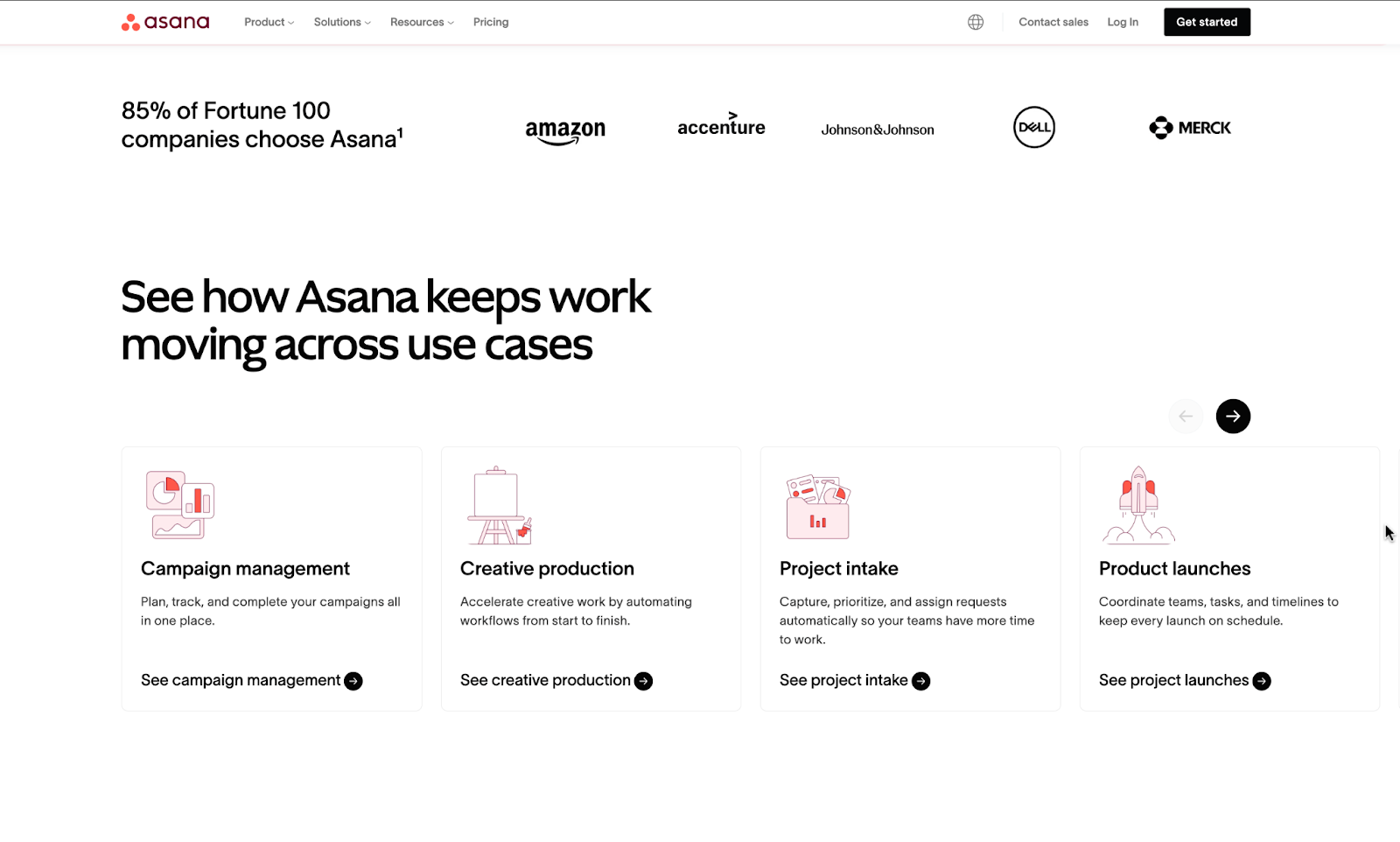
- Social proofs (logos and testimonials) are risk reducers. Lokalise doesn’t just say “trusted by companies worldwide”. They drop JP Morgan, Prime Video, and Schneider logos right under the headline and CTA buttons.
That’s shorthand for “others you respect already trust us.”
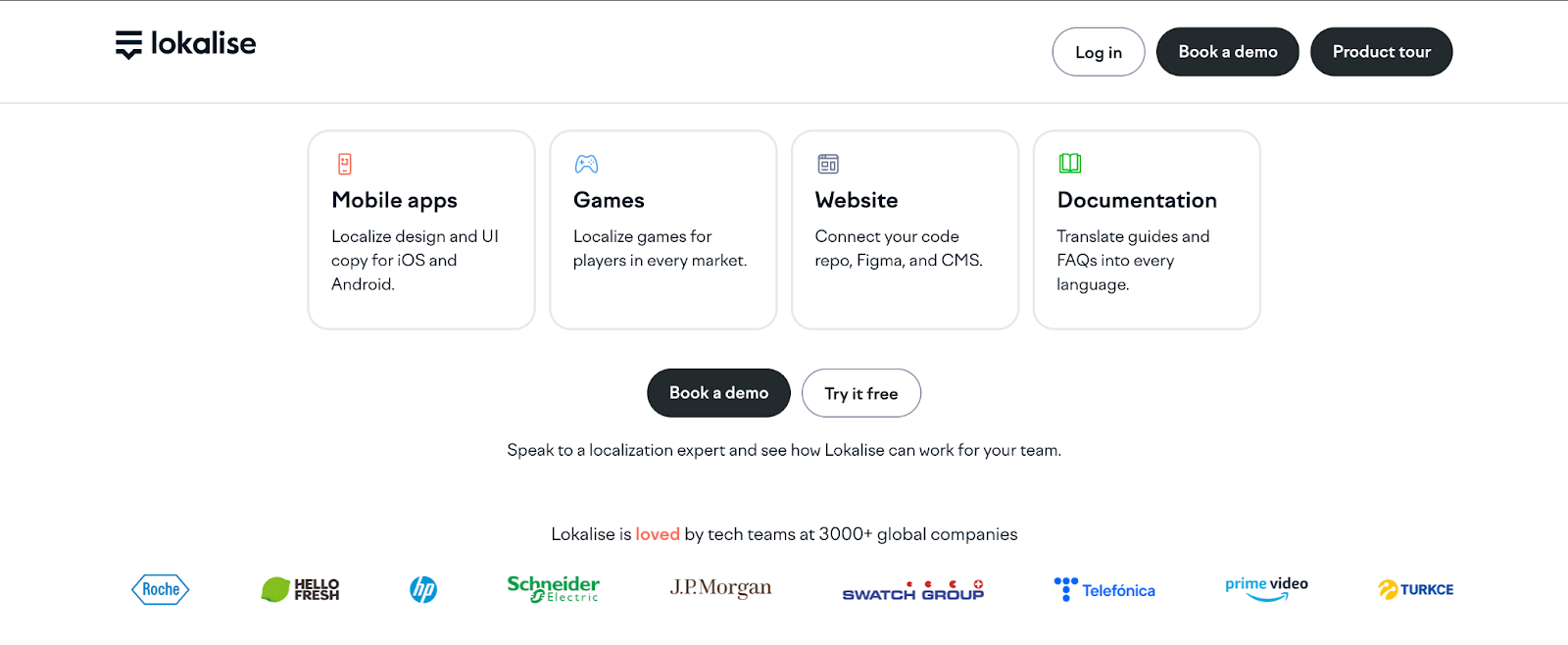
Don’t overload the hero with 3–4 competing CTAs. Pick one primary, one secondary.
- Color psychology guides perception. Datadog’s purple stands out in a crowded cloud space; Shopify’s green reinforces growth and commerce.
The job of website design elements here isn’t to delight. It’s to reduce the buyer’s anxiety and make the next step feel obvious. Here’s a simple B2B design signal framework you can follow to check if your website visual strategy communicates trust:
{{ctaBlock}}
Design Signal Framework for B2B Websites
| Signal | Buyer Question | How to Implement |
|---|---|---|
| Trust | Can I rely on you? | Client logos, compliance badges, testimonials next to CTAs (not buried) |
| Clarity | Do I get this fast? | Whitespace, clear hierarchy, consistent spacing + typography system |
| Differentiation | How are you unique? | Distinctive color palette/branding |
| Engagement | Do I see value here? | Interactive demo, tour video |
And yes, personalization matters! HubSpot found personalized CTAs convert 202% better than generic ones by using smart, dynamic messaging.
KPI to watch: Hero CTA click-through rates.
Also Read: A Complete Guide to B2B Web Design Best Practices
Blueprint principle 4 → Code your website for iteration, not just launch
Most SaaS teams build for “launch day.” Then marketing asks for a new industry landing page, and suddenly it’s a dev ticket that takes 3 weeks. That’s the cost of not thinking modularly.
At ThunderClap, we build modular CMS libraries: feature blocks, testimonial carousels, pricing tables (coded once, reused everywhere). Marketing launches in hours, not weeks. Dev focuses on performance and integrations, not content edits.
One of the common questions we get in B2B web design is choosing the right content management system for your business:
SaaS CMS Options Compared (B2B Focus)
| CMS | Pros | Cons | Best Fit |
|---|---|---|---|
| WordPress + Builder | Flexible, huge plugin ecosystem | Plugin bloat, security risks | Mid-sized B2B |
| Webflow | No-code, fast iterations | Limited backend depth | Marketing-led SaaS |
| Headless CMS | API-first, enterprise-scale | High dev overhead | Large SaaS with a complex stack |
Cloudflare shows that every 100-millisecond delay in website loading can cause a 1.11% drop in conversions. Web performance isn’t vanity; it’s revenue. If your site loads slower than your competitor’s, you’re signaling sloppiness before the first headline even registers.
How to do it:
- Code all blocks as modular components (hero, testimonial, pricing grid).
- Use Webflow for CMS + visual editing. Marketing can launch pages in hours, not weeks.
- Globalize design tokens (colors, typography, spacing) → updates sync sitewide.
KPI to watch: Time to launch a new campaign page. Elite SaaS: <1 day.
Blueprint principle 5 → Remove friction relentlessly (and then some more)
B2B SaaS conversion rates are significantly lower compared to B2C, as buying SaaS is riskier, more complex, and often involves multiple committees. That means every ounce of friction matters.
But having longer cycles doesn’t excuse poor conversion architecture. Conversions happen by climbing a ladder of offers (each reducing risk until the buyer commits). Your best bet is to offer multiple CTA paths: trial, demo, calculator.
Here are a few examples of what a bare bones offer ladder can look like.
Offer Ladder Framework
| Step | Offer | Friction | When to Use |
|---|---|---|---|
| 1 | Demo video | Low | Homepage |
| 2 | ROI tool/checklist | Low–Med | Resources, use cases |
| 3 | Instant calendar booking | Med | Pricing/comparison pages |
| 4 | Full demo/consult | High | High-intent buyers |
Once you have done an audit of your offer, here’s what else you should optimize for:
- Look at your forms: If visitors won’t even start the form, it’s not the fields (it’s the offer). We have seen that an ROI calculator with five fields often outperforms a vague “Request a Demo” with 3. Embed calendar booking right after the form submission to capture hot intent.
- Improve your free trials: Free trials without a card convert at ~18%, while those with a card convert at ~48%. Now, there are many variables you need to take into consideration based on whether you want volume or qualification.
Add live chat to your website: Intercom and Drift show why live chat works. Buyers evaluating SaaS have questions now, not in 48 hours when SDRs reply.
Don’t default to “Contact Us.” It’s vague, high-friction, and kills conversion.
KPI to watch: Meetings per 1,000 sessions.
{{specficBlog}}
Blueprint principle 6 → Treat your website like a product
The biggest lie in B2B web projects? “We’ll relaunch and then move on.”
But most SaaS websites don’t fail at launch. They fail six months later when content is outdated, modules break, or teams can’t scale new pages without dev help. If your site isn’t designed for iteration, it’s obsolete in 12 months.
The blueprint solution is simple. Treat your site like your product: modular, iterative, evolving.
As Ayush Barnwal, Founder at ThunderClap, reminds us:
“A website isn’t a project, it’s infrastructure. You wouldn’t turn off your CRM after launch, so why treat your website differently?”
At ThunderClap, here are six monthly website health checks we recommend all our clients:

KPI to watch: Meetings per 1,000 sessions, tracked monthly. If it dips, trigger a CRO sprint.
Make your website your best SDR with ThunderClap
Most mid-market and enterprise B2B product companies face the same website challenge: their website no longer reflects who they are becoming. They’re pivoting their positioning, preparing for expansion, launching new products, or under pressure to perform at an international standard.
But their website lags behind.
At ThunderClap, we help you transform your websites into conversion-driven growth engines—accurate representations of your product, scale, and vision that finally make them stand out in your category.
Here’s what changes when you work with us:
- Instantly communicate value and positioning without confusion
- Project a premium, credible brand perception that matches your ambitions
- Scale and iterate fast with modular systems that keep your site current
- Launch a site that doesn’t just match category rivals (it beats them on clarity, UX, and design)
- Hit concrete KPIs: double demo signups, increase MQLs, lower bounce, and win awards
And we’ve seen this transformation play out across 129+ projects, including clients like Storylane, ClearlyRated, RazorPay, and Amazon. If you’re ready to make your website your best SDR, let’s talk execution.
Book a free consultation today!
{{specficService}}
FAQs
Do B2B websites need ongoing updates and maintenance?
Yes. A B2B website is a living system, not a one-off project. Without regular updates, content goes stale, compliance proof becomes outdated, and performance suffers. The best teams run weekly content or CTA tests, monthly KPI and speed audits, and quarterly UX refreshes to keep the site aligned with buyer needs.
What key features should a good B2B website have?
A strong B2B website blends trust, clarity, and conversion. That means visible compliance badges and case studies, a clear CTA ladder that guides visitors from trial to demo, and an integration hub that shows ecosystem fit. Under the hood, it needs fast load speeds and a modular CMS like Webflow so Marketing can iterate without waiting on Dev. These align with the core principles of B2B web design and development best practices.
How do I optimize my B2B website for SEO & leads?
Start with BoFU pages like pricing, competitor comparisons, integrations, and security hubs to capture in-market buyers. Optimize content for both search engines and LLMs with clear summaries, tables, and FAQs. Finally, place proof points next to CTAs and enforce a speed-to-lead SLA of under 5 minutes to prevent drop-offs. Think of this as part of your B2B web design and development blueprint for long-term growth.

Top Webflow Agencies in London for SaaS & Tech Brands
The London tech scene is booming, and with it comes the demand for exceptional digital experiences. But here’s the harsh reality: while London houses some of the world’s most innovative SaaS and fintech companies, many are held back by websites that don’t reflect their brilliance. Whether you’re a Series A startup scaling fast or an enterprise fintech looking to dominate your market, your website is either your weapon or your Achilles’ heel.
Now, let’s consider some of the specialized London Webflow agencies. These aren’t your average design shops throwing together templated solutions. The best Webflow design agencies in London understand the different challenges faced by tech brands: user journeys, B2B decision-making processes, compliance requirements, and the constant pressure to convert visitors while building trust at scale.
We’ve evaluated London’s top Webflow specialists to bring you the definitive list of agencies that get SaaS and tech. Leading our rankings is ThunderClap, which has emerged as the conversion-focused agency serving everyone from seed-stage AI startups to enterprises.
With their strategy-first approach and lightning-fast execution, they’re setting the standard for what’s possible for SaaS website design.
Ready to discover which London Webflow agency deserves your next project? Let’s dive in.
Why London’s SaaS & Tech Scene Demands Specialized Webflow Expertise
London isn’t just a financial hub; it’s Europe’s undisputed SaaS and fintech capital. From the regulatory problems of the City to the scaling demands of King’s Cross startups, tech companies here face challenges that generic web agencies simply can’t solve.
Your website is not a digital brochure. For SaaS companies, it is the first touchpoint in a B2B sales journey. For fintech, it’s where trust is built or destroyed in milliseconds. For AI companies, it’s where you translate cutting-edge technology into business value. This requires more than a pretty design. It demands strategic thinking, conversion optimization, and an intimate understanding of how tech buyers make decisions.
The best Webflow agencies in London don’t just build websites; they architect conversion engines. They understand that your homepage needs to speak to both technical decision-makers and C-suite executives, that your pricing page must handle enterprise while remaining accessible to startups, and that every element must be optimized for the metrics that matter to tech businesses.
How We Identified London’s Top Webflow Agencies for Tech Brands
We didn’t just Google "Webflow agency London" and call it a day. Our selection process was methodical, focusing on agencies that deliver measurable results for SaaS, fintech, and tech companies:
| Criteria | Why It Matters |
|---|---|
| SaaS/Tech Portfolio | Proven experience with complex B2B sales cycles and technical products. |
| Conversion Focus | Evidence of measurable results, not just aesthetic improvements. |
| London Presence | Local market understanding and time zone alignment for faster iterations. |
| Client Retention | Long-term partnerships that reflect consistent value delivery. |
| Technical Expertise | Advanced Webflow integrations and scalable architectures for growth. |
The Top Webflow Agencies in London for SaaS & Tech Brands
1. ThunderClap (The Strategy-First Conversion Agency)

When SaaS and tech companies need websites that don’t just look impressive but bring measurable growth, they turn to ThunderClap. This isn’t your typical design agency; we’re strategic partners who understand that in tech, every pixel, every word, and every user journey element must earn its place by focusing on conversions.
What sets ThunderClap apart in London’s crowded agency scene is our obsession with results. We focus on winning customers for the clients, while also winning design awards. Our average client sees a 50% increase in lead generation, and their websites outperform industry benchmarks for engagement rates.
Why ThunderClap Dominates the London Tech Scene
ThunderClap’s approach is refreshingly direct: we start with business objectives, not aesthetic preferences. Our strategy-first methodology means every design decision is backed by data, user research, and conversion optimization principles. For SaaS companies, this means websites that guide prospects from initial awareness to qualified sales conversations. We have an in-house product marketing team that provides expertise in B2B Messaging strategy, design, dev, and everything in between.
Our technical expertise runs deep. As a Webflow Enterprise Partner, we leverage advanced CMS structures, custom integrations, and performance optimization techniques that many agencies don’t match. But it’s our strategic thinking that truly sets us apart. We understand how SaaS buyers research, evaluate, and purchase, and we tend to design experiences that align with these natural behaviors. Learn more about this process.
Client Success Stories
ThunderClap’s portfolio reads like a who’s who of successful tech companies.
For Shopline, created a website that scales across multiple markets while maintaining conversion optimization.
Storylane’s new site, built by ThunderClap, saw immediate improvements in demo requests and sales-qualified leads.
“The ThunderClap team is responsive, meets deadlines, and goes beyond expectations — it’s a solid partner for any B2B company looking to scale their brand.”
— Anand Vatsya
Product Marketing, Outbound, Storylane
{{ctaBlock}}
2. ViDesigns
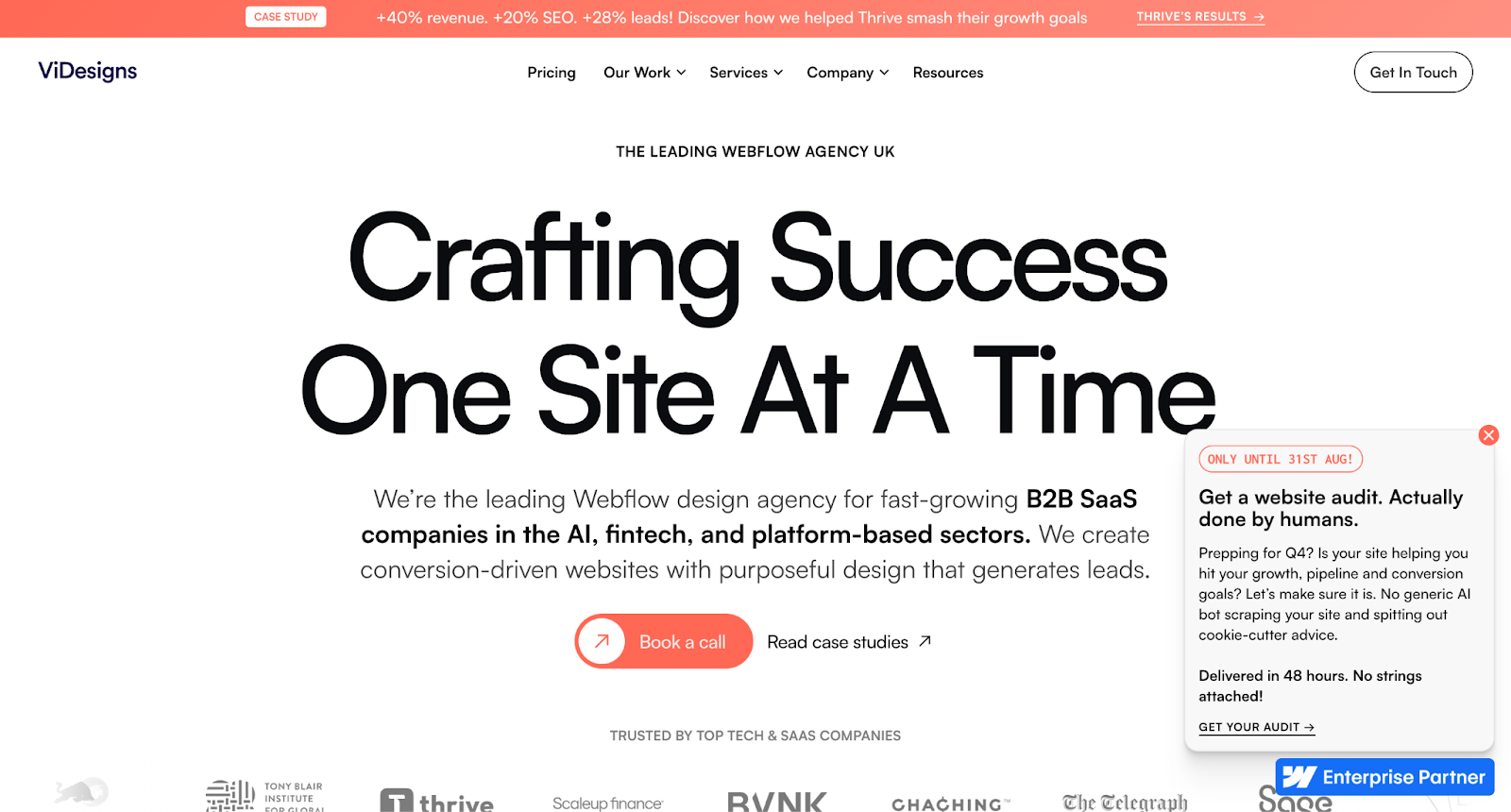
ViDesigns has built a reputation as London’s go-to Webflow design agency for B2B SaaS companies that need to move fast without compromising quality. They’ve launched Webflow projects for brands ranging from Red Bull to AI startups, but their sweet spot is clearly in the B2B tech space.
What makes ViDesigns particularly effective for London’s tech scene is their understanding of the B2B buyer journey. They create beautiful websites along with conversion paths that account for the multi-stakeholder decisions typical in SaaS and tech sales cycles.
Their project capacity is intentionally limited. They only take on 6 Webflow projects each quarter so that every client receives their full attention. This boutique approach has earned them verified client reviews.
3. RCCO

For London tech companies that need enterprise-level work with the agility of a specialized London Webflow agency, RCCO delivers at scale. Their projects typically range from Series B+ companies to enterprises that need websites worthy of their market position.
RCCO’s strength lies in their approach. They’re not just building websites; they’re creating digital ecosystems that integrate with existing tech stacks. Their recent work includes Simplestream (video streaming platform), Optable (data collaboration), and WILD (video brand platform).
What sets RCCO apart is their focus on self-management. They don’t just hand over a finished website; they ensure your team can confidently manage, update, and scale the platform without constant agency
4. Team 4

Team 4 positioned themselves as London’s specialist Webflow agency for B2B SaaS companies that understand growth comes from organic visibility, not just paid acquisition. Their tagline says it all: ‘High-POWER Webflow Websites for B2B SaaS SEO’.
Their approach combines Webflow development with SEO, creating what they call inbound engines for growth. For SaaS companies tired of relying solely on expensive paid channels, Team 4 offers an alternative: websites that rank, convert, and scale organically.
Their process begins with SEO discovery, ensuring that site architecture, content strategy, and user experience all align with search intent and buyer behavior. This isn’t just about technical SEO, it is about understanding how B2B SaaS buyers research solutions and creating content experiences that capture demand at every stage of the journey.
5. Lighthouse Digital
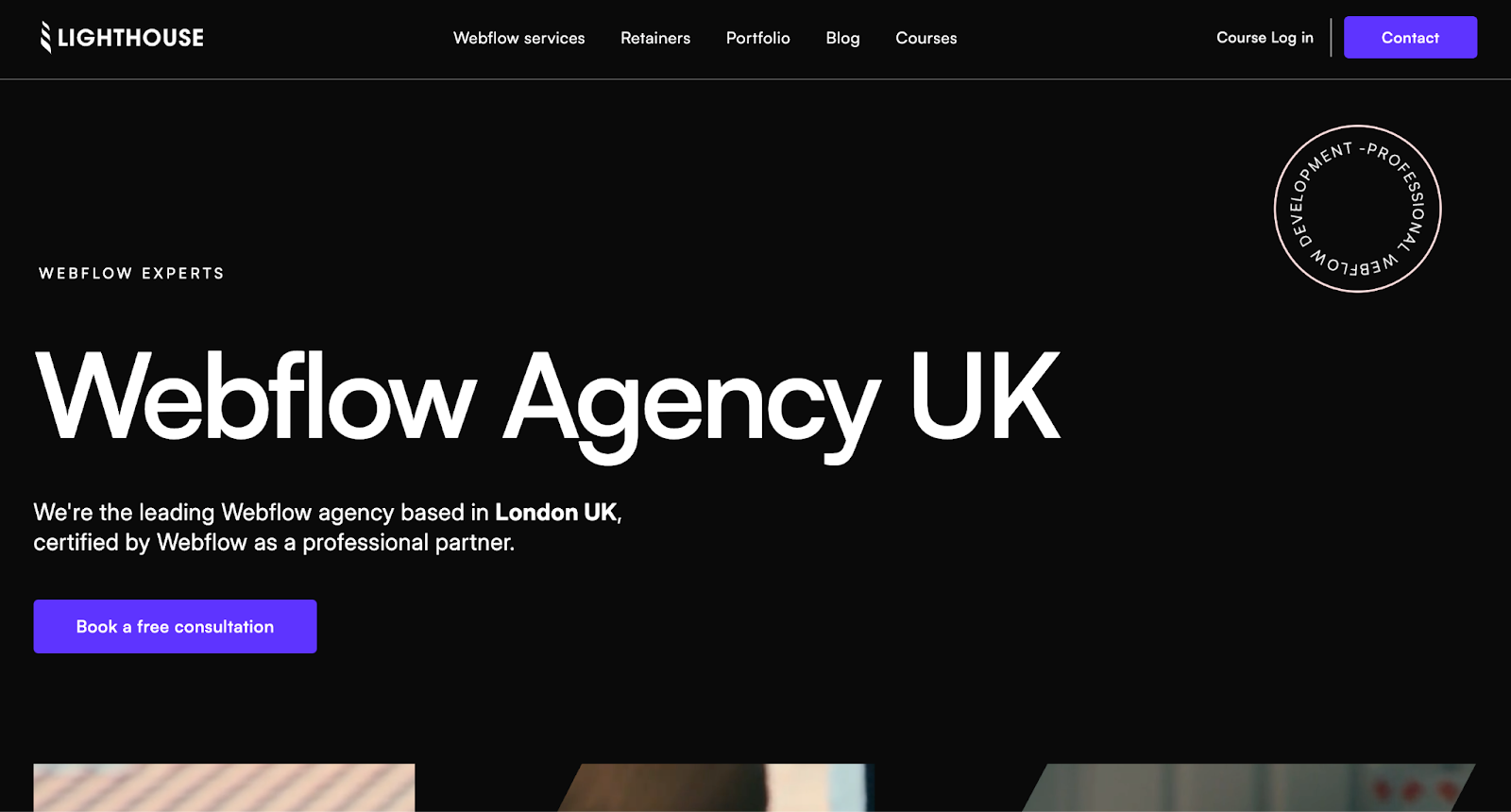
Lighthouse Digital established itself as one of London’s most experienced Webflow agencies, with a portfolio that includes major successes across the tech spectrum. They’ve developed Webflow websites for HelloSelf (£17 million in funding), Mission Zero (£21.8 million Series A), and major brands like Britvic and IGN.
Their strength lies in execution across diverse tech verticals. Whether you’re in fintech, healthtech, or enterprise software, Lighthouse Digital brings the experience of having solved similar challenges before. Their project portfolio shows success in helping tech companies achieve funding milestones and market expansion goals.
What makes Lighthouse Digital particularly considerable for London tech companies is their deep platform expertise along with business acumen. They understand that successful tech websites need to work for multiple audiences.
{{specficBlog}}
6. Paddle Creative
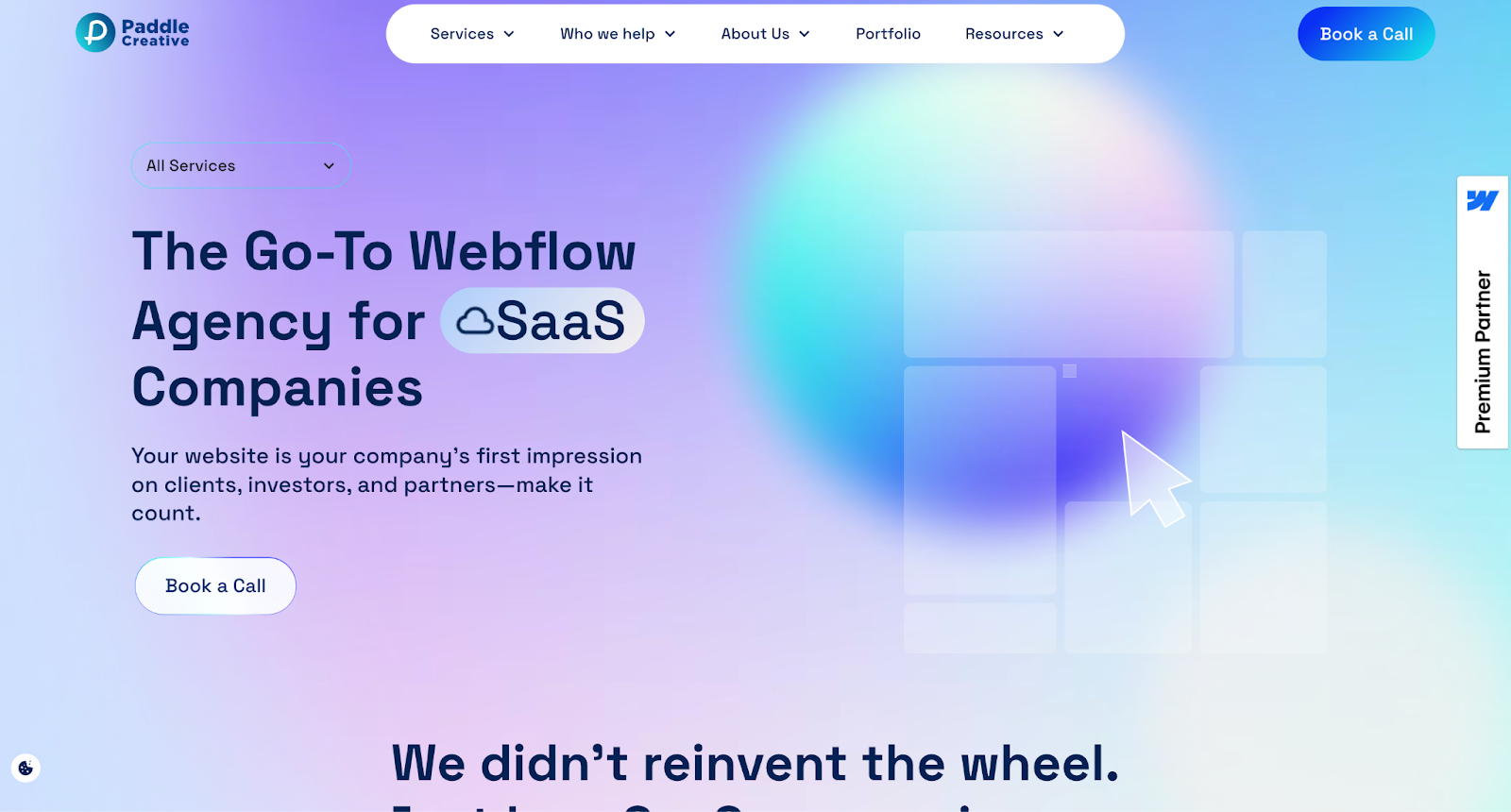
Paddle Creative specifically works around serving SaaS and fintech companies, making them a natural fit for London’s tech sectors. They have helped clients secure over £150 million in combined funding, including NatureMetrics (£25m Series B), Swap (£40m Series B), and Gaia Fertility (£23m).
Their specialization shows in their approach. Rather than generic web design principles, Paddle Creative applies frameworks specifically developed for SaaS and fintech user acquisition and conversion. They understand the regulations that fintech companies face, the compliance requirements, and the trust-building elements that are non-negotiable in financial services.
For SaaS companies, they bring deep understanding of freemium models, trial optimization, and the complex pricing presentations that B2B software companies require.
7. MakeBuild

MakeBuild brings a refreshing design through making philosophy. As a Webflow Enterprise Partner based in London, they have created a reputation for tackling integration challenges while maintaining creativity that tech brands need to stand out.
Their approach sits particularly well with tech companies that value innovation over convention. Rather than endless strategy sessions and presentations, MakeBuild does rapid prototyping and iterative development. For fast-moving tech companies that need to test, learn, and pivot quickly, this methodology offers significant advantages.
Their clients highlight their ability to handle requirements while maintaining project velocity. This combination of tech and efficiency makes them valuable for London tech companies operating in competitive markets.
8. The London Webflow Agency

With over 8 years of Webflow experience and deep London market knowledge, The London Webflow Agency has the local expertise that many tech companies value. Their founders have been working on digital projects since the late 1990s, bringing mature perspective to modern Webflow capabilities.
Their strength lies in service delivery: Webflow development with digital marketing services including SEO, PPC, and paid social. For tech companies that prefer working with a single agency across multiple disciplines, this integrated approach is definitely worth a shot.
Their client roster includes institutions like The City of London Corporation and Tate, showcasing organizational requirements and high-profile brands.
Agency Shortlist Overview
| Agency | Project Size (Starts From) | Locations | Primary Industry | Top Clients | Notable Testimonial or Outcome |
|---|---|---|---|---|---|
| ThunderClap | £5,000 – £40,000 | London, Remote | SaaS, Fintech, B2B | Razorpay, Shopline, Elevation Capital, Amazon | “Responsive, meets deadlines, goes beyond expectations.” |
| ViDesigns | £6,000 – £20,000 | London | SaaS, Tech, Product | RedBull, Tony Blair Institute | “Collaborative, creative, goes above and beyond.” |
| RCCO | £10,000+ | London, Manchester, Remote | Tech, B2B, Enterprise | Loyaltek Group, Simplestream, Optable | “Made our dreams come true…exactly what we needed.” |
| Team 4 | £5,000+ | London | B2B SaaS, Tech | 100+ SaaS/Tech brands | “Specialists for B2B SaaS SEO and inbound growth.” |
| Lighthouse Digital | £5,000+ | Shoreditch, London | B2B, SaaS, Fintech | HelloSelf, Mission Zero, Britvic | “Sleek sites that drive results and capture attention.” |
| Paddle Creative | £5,000+ | London | SaaS, Fintech, AI | NatureMetrics, Swap, Gaia Fertility | “Becomes part of your team, delivers every time.” |
| MakeBuild | £8,000+ | London | Tech, SaaS, Corporate | Typeform, London & County Mortgages | “Brain surgery feel like a flu shot, true experts.” |
| London Webflow Agency | £5,000+ | London | Broad B2B, Public | City of London Corporation, Tate | “Local expertise, wide service scope, reliable.” |
What Makes These London Webflow Agencies Perfect for Tech Brands?
The agencies on this list share several components that make them effective for SaaS, fintech, and tech companies:
Deep Technical Understanding: They understand products and turn technical features into clear benefits. These agencies communicate effectively with both technical teams and business leaders.
Conversion Optimization Expertise: They build every page element for specific results. From homepages that filter qualified leads to pricing pages that handle enterprise deals, these agencies know how B2B tech sales actually work.
Scalable Architecture: They create Webflow sites that grow with your company. When you launch new products, enter new markets, or connect new tools, these websites handle the expansion.
Speed and Agility: Tech companies move fast, and these agencies keep up. They know your launch dates tie to funding rounds, product releases, and market windows that can’t wait for endless revisions.
Choosing the Right London Webflow Agency for Your Tech Brand
The best London Webflow agency for your company depends on your specific stage, goals, and requirements:
For Early-Stage SaaS Companies: Consider agencies that understand the challenges of establishing market presence while optimizing for conversion from day one.
For Enterprise Tech Brands: Prioritise sophisticated project management needed for high-stakes implementations.
For Growth-Stage Companies: An SEO-first approach or funding track record might align perfectly with your scaling objectives.
For Innovation-Focused Brands: Experimental approach could be ideal for companies that want to push creative and technical boundaries.
The key is finding an agency that doesn’t just understand Webflow, but understands your business model, your customers, and your competition. The best partnerships happen when agencies become extensions of your team, not just external service providers.
{{specficService}}
What’s Next for Your Tech Brand?
London’s tech scene moves fast. If your website doesn’t perform, you fall behind. Top SaaS companies aren’t just looking for sites that look good; they want sites that convert, engage users, and bring measurable growth.
The tech brands that win partner with agencies that get it. Whether you’re launching a new platform or scaling an existing product, the right Webflow design agency can turn your website into a growth engine, not just a digital business card.
The agencies on this list are among London’s best. Each has its own strengths and methods. But here’s what we’ve learned working with ambitious tech teams: the best agency isn’t always the biggest or most famous. It’s the one that understands your market, talks your customer’s language, and delivers real results.
ThunderClap stands out because we bring together strategy, technical skill, and a conversion-first approach.
We build sites that help SaaS and tech brands dominate their markets.
Your website either drives growth or it doesn’t. Make it count.
Book a free demo with ThunderClap and see how we turn websites into your strongest growth asset.

From Traffic to Pipeline: B2B Website Growth Strategy for Scaling Teams
Your traffic charts are trending up. But your pipeline charts? Not so much.
This is the story we hear from scaling B2B teams all the time. They’ve invested in SEO, refreshed their design, pushed out content, and maybe even redesigned the entire website in the last 18 months.
On paper, everything looks good. In reality, SQLs and opportunities aren’t keeping pace.
The reason is simple: most B2B websites are built to collect traffic, not create a pipeline.
They fail to guide ICP buyers from session → meeting → SQL → revenue, and this disconnect is costing them deals every quarter.
In this playbook, we’ll share the B2B website growth strategy framework we built for scaling SaaS teams at ThunderClap. We’ll back it with competitor benchmarks, pipeline math, and research that proves what works (and what doesn’t).
By the end, you’ll have a roadmap to transform your website from a marketing channel into a pipeline engine that scales with your team.
TL;DR
Most B2B websites chase traffic, not pipeline, resulting in missed sales opportunities and lost revenue. This B2B website growth strategy playbook shows you how to flip that with a pipeline-first growth framework:
- Focus traffic on BoFU pages (pricing, comparisons, security).
- Build conversion architecture (clear offer ladder + proof + speed-to-meeting).
- Enable instant bookings and smart routing to boost qualified meetings.
- Align sales handoff with buyer context for higher SQL rates.
- Track pipeline KPIs (meetings per 1k sessions, BoFU traffic share, speed-to-lead).
- Layer on personalization, CRO, and LLM-friendly content for scale.
Do this, and your B2B website becomes a pipeline engine that drives measurable ROI
What is a B2B website growth strategy?
A B2B website growth strategy is a structured plan for attracting ICP traffic and turning it into revenue. That means your site isn’t just optimized for sessions, pageviews, or bounce rate; it’s optimized to move your ICP through your funnel:
Sessions → CTA clicks → Meetings → SQLs → Revenue
It’s a pipeline-first approach that defines:
- Who you’re for (ICP clarity),
- What you want them to do (offer ladder → meeting),
- How you’ll prove it’s worth their time (proof, performance, and speed‑to‑meeting),
- How you’ll measure it (pipeline KPIs tied to revenue).
Notice what it’s not: It’s not an SEO checklist, obsessing over page speed scores, or a debate over whether the hero should have a video background. Those are executional decisions, important, but they should flow from strategy (not drive it).
Why do B2B websites struggle to generate leads?
The stakes for your website have never been higher.
- 82% of B2B buyers are willing to purchase from vendors online without ever talking to sales.
- But 88% of users say they’ll abandon a site after a poor experience.
That’s both the opportunity and the risk.
Your website is no longer just a digital brochure; it’s the first sales conversation.
Done right, it can be a pipeline engine. Done wrong, it leaks deals.
As Kiran Kulkarni, Partner & Head of Growth at ThunderClap, puts it:
“We’ve audited 70+ SaaS websites so far, and one of the most common issues we see is that page layouts aren’t optimized for conversions. Some teams only place one CTA block on a page, others use 10 different names for the same CTA, or bury users under long forms and content-heavy pages that cause drop-offs instead of helping buyers scan seamlessly.”
Here are 6 reasons why most B2B websites struggle to generate leads:
- ICP fuzziness. Messaging tries to talk to everyone and resonates with no one. They attract traffic, but not the right traffic.
- Top‑funnel traffic bias. Teams overproduce top-of-funnel (TOFU) blogs, but underinvest in bottom-of-funnel (BoFU) pages like pricing, comparisons, and security.
- Generic CTAs. Contact Us is the default call-to-action. It’s vague, high-friction, and fails to meet buyers where they are in the journey.
- Proof starvation. Case studies, ROI data, security, and integration evidence are missing or buried in footers or resource centers (nowhere near conversion points).
- Slow handoff to sales. When inbound leads fill out a form, response often takes hours (or days). That delay kills the pipeline.
- Design‑over‑data. Visual vanity wins meetings internally, not in the market. A premium design still must be measurably effective.
From traffic to pipeline: The 4-stage B2B website growth framework
Here’s the 4-stage framework we use at ThunderClap with mid-market and enterprise B2B teams to move from traffic‑centric to pipeline‑centric with a result-oriented system:
| Stage | What it means | Owners | Primary levers | Success signal |
|---|---|---|---|---|
| Sessions → Intent | Right visitors, not just more | SEO, Demand Gen | BoFU pages, branded search, partner traffic, persona-focused copy | % of sessions landing on BoFU |
| Intent → Engagement | Prospect takes the next step | Product/Content | Clear value props, scannable pages, performance | CTA click-through rate |
| Engagement → Meeting | Prospect books or requests time | Growth, RevOps | Offer ladder, calendar embed, smart routing | Meetings per 1k sessions |
| Meeting → SQL/SQO | Sales accepts and advances | Sales, RevOps | Qualification, enrichment, speed-to-lead | SQL rate, time-to-first-touch |
| SQL → Revenue | Deals created and won | Sales | Proof alignment, case studies, ROI tools | Opportunity rate, win rate |
Did you notice how each stage has owners, levers, and an observable, time‑bound KPI?
That’s how we recommend it!
Now let’s break down the primary levers and execution tactics for each of these stages.
Stage 1 → Traffic that converts (BoFU focus)
Scaling teams don’t win by publishing more TOFU explainers. They win by capturing in‑market demand with bottom‑of‑funnel (BoFU) assets that shorten time‑to‑meeting. Time and again, we see them do this by targeting in-market buyers via intent-led ads and retargeting (so paid campaigns don’t just fuel top-funnel vanity visits).
High-performers do this with:
- Comparison pages: “You vs Competitor” with head‑to‑head matrices.
- Alternatives pages: “Best Competitor alternatives” to intercept switching intent.
- Pricing: Transparent tables, value justifications, and procurement FAQs.
- Integration hubs: Verified workflows with the systems your ICP already runs.
- Security & compliance: SOC 2/ISO details, data residency, and legal review shortcuts.
Implementation & ROI tools: Calculators, timelines, and success checklists.
What should you aim for?
High-growth teams aim for 30–40% of traffic landing on BoFU pages, not just blogs.

Stage 2 → Conversion architecture (offer ladder, proof, speed-to-meeting)
Once someone lands, your site needs to answer in <5 seconds: Is this for me? Can I trust them? What’s my next step?
That’s conversion architecture.
You achieve this by creating an offer ladder, a clear, progressive path that moves your visitor closer to a meeting or demo.
Here’s what an offer ladder looks like:
The goal of your B2B website strategy is to give prospects more value and less friction in each step, helping them get comfortable taking the next step on the path to conversion.
Here are a few more examples of what an offer ladder can look like.
| Offer | Effort for the visitor | Perceived value | When to use | Why it works |
|---|---|---|---|---|
| Ungated tour / 3-min demo video | Low | Medium | Early interest; home & product pages | De-risk the click. Show outcomes first |
| Template / Checklist / ROI calc | Low–Medium | Medium–High | Category researchers; mid-funnel | Show utility. Capture light data if needed |
| Industry mini-case | Medium | High | Vertical pages; ABM landers | Pair with relevant proof & logos |
| Live calendar (book a meeting) | Medium | High | BoFU pages; pricing, comparison | Eliminate back-and-forth. Route intelligently |
| Full demo / assessment | High | Very High | Ready buyers; high intent | Promise a clear give/get and timeline |
A few things to keep in mind while creating your offer ladder:
- It’s not always “fewer form fields = better.” Research shows relevance and perceived risk matter more. For high-value meetings, a couple of qualifying fields + visible proof can increase conversions.
- Social proof and trust signals (think logos, quantified ROI, compliance badges, G2 reviews) belong beside CTAs, not hidden in a resource hub.
What should you aim for?
High-performing SaaS websites convert 1.5–4% of sessions into CTA clicks.
One of the common questions we get from B2B brands is around CTAs. While there is no one-size-fits-all answer here, we did a mini-scan of five category leaders and found a clear pattern in their B2B SaaS website strategy: they blend PLG-style offers (trials, demo videos) with sales-assist CTAs (contact sales, book demo).
| Company | Primary hero CTAs | Secondary CTA | Offer mix visible | Path to meeting |
|---|---|---|---|---|

|
Get free CRM Get started free |
Get a demo See the HubSpot setup guide Learn about premium CRM |
Demo, chat, freemium, social proof below form | Form → Schedule call / Chat |

|
Try our CRM free Watch a demo |
Talk to an expert Know more Learn more |
Form, phone, product-specific sales forms | Form submit → rep outreach or Chat |

|
Get started (login with work ID) View demo (requires form fill) |
Talk with our sales team | Sales form + product tour, PLG trial | Form submit → rep outreach |

|
Free trial See the platform (no login) |
Let’s talk State of DevSecOps report |
Trial, live demo, events | Trial first, demo path via rep |

|
Start free trial | Contact sales Weekly live demo webinars |
Trial, recurring demo webinar | Trial signup or webinar reg |
Takeaway: The best B2B sites don’t force every visitor into ‘Contact Sales’. They give a choice: a low-friction path (trial/demo/industry reports) and a high-value path (meeting).
{{specficBlog}}
Stage 3 → Book qualified meetings
This is where most scaling teams bleed pipeline. Their prospects click CTAs, then hit forms, “thank you” walls, or slow SDR follow-ups. A famous MIT study found that responding to a lead within 5 minutes makes you 100× more likely to qualify them than waiting 30 minutes.
Speed‑to‑meeting is a growth lever.
- Embed calendar scheduling on thank‑you pages to convert intent while attention is hot.
- Use smart routing (territory, account owner, product interest).
- Enforce speed-to-lead SLAs. reps contact inbound leads within 5 minutes, not hours. Timely delivery is a huge conversion multiplier.
And don’t forget performance: improving core web vitals correlates directly with conversion lifts.
What should you aim for?
Elite teams achieve 30–60% conversion from form start → booked meeting when they add a form scheduler. Instant booking is the difference.
Stage 4 → Qualify into pipeline (SQLs & Opps)
A booked meeting ≠ pipeline until sales accepts it.
What to optimize here:
- Progressive profiling + enrichment: capture the essentials, enrich the rest via lead enrichment tools like Clearbit, 6sense, or Mutiny.
- Role-aware proof: give execs ROI calculators, give security teams compliance docs, give users workflow demos.
- Sales enablement alignment: SDRs/AEs who integrate enablement content into their process outperform targets 58% more often. They use the same assets the buyer saw on the site, so the conversation feels consistent.
What should you aim for?
Scaling SaaS teams convert 30–50% of meetings into SQLs and close 15–30% of opportunities. Enterprise averages 10–15%, offset by higher deal values.

The 4-stage framework we gave you is your core operating system. But in our experience working with 129 B2B clients, scaling teams that break out layer on three cross-cutting levers that accelerate results across the entire funnel.
1. Personalization & ABM
Personalization is no longer a nice-to-have. Buyers expect relevance (by industry, by role, by even their specific account context). Personalization turns a generic visit into an account-relevant conversation (long before a rep is involved).
Start with 2 or 3 industries or ICPs. Then add:
- Industry-specific hero experiences: Swap the hero, proof, integrations, and case studies to match the visitor’s vertical.
- Role‑aware messaging: Executives want outcomes and risk reduction; end‑users want workflows and time saved; security wants controls and compliance.
- Account‑aware proof: For ABM lists, highlight competitor alternatives or relevant case studies.
And it works!
Amplitude, the product analytics leader, increased leads by 54% by tailoring its website experience to the visitor industry (B2B, B2C, or financial services). The homepage logos, headlines, and even the logos shown on pricing and sign-up pages adapt to match the visitor’s vertical. A B2B company sees proof points from Box and Cisco, while a B2C company sees Postmates and Under Armour.
Also Read: How Slack's Evolving Messaging Strategy Matches User Awareness Stages: A Study
2. KPI tracking to measure pipeline outcomes
Scaling teams track the pipeline math: how sessions turn into revenue.
And it isn’t complicated either. You too can build a dashboard your execution team can skim in just 5 minutes.
We recently redesigned ConsultAdd’s website and lifted conversions by 60%. Here’s a video walkthrough of the before and after of their home page makeover:
| KPI | Definition | Target Direction | Why it matters |
|---|---|---|---|
| Meetings per 1,000 sessions | Booked meetings normalized to traffic | Up and to the right | Core efficiency signal |
| % traffic to BoFU pages | Share of sessions landing on pricing/compare/security | Increase | Intent mix improving |
| CTA click-through | Primary CTA clicks/sessions | Increase | Message–market fit on page |
| Form start rate | Begins form/CTA clicks | Increase | Friction & anxiety reduced |
| Form completion / instant book | Completions or scheduled/form starts | Increase | Offer clarity & routing quality |
| Speed-to-first-touch | Minutes from form to human contact | Decrease (aim: minutes) | Strong predictor of SQLs |
| SQL rate | Sales-accepted meetings/meetings | Increase | Qualification quality |
| Opportunity & Win rate | Opps/SQLs; Wins/Opps | Increase | Downstream revenue impact |
Conversion rate optimization (CRO) tools here acted as a useful metric to validate that the website revamp drove real results.
Here’s a KPI model we use with clients:
Food for thought:
The average sitewide conversion rate across industries is ~2.9%. Scaling SaaS should aim above that, using pipeline math (not vanity metrics) to set targets.
3. Search + LLM Visibility
Your future buyer might meet you in a traditional SERP or inside an answer engine (ChatGPT, Perplexity, Google SGE). You should design content so both can parse, cite, and trust it.
You can future-proof content with this simple checklist:
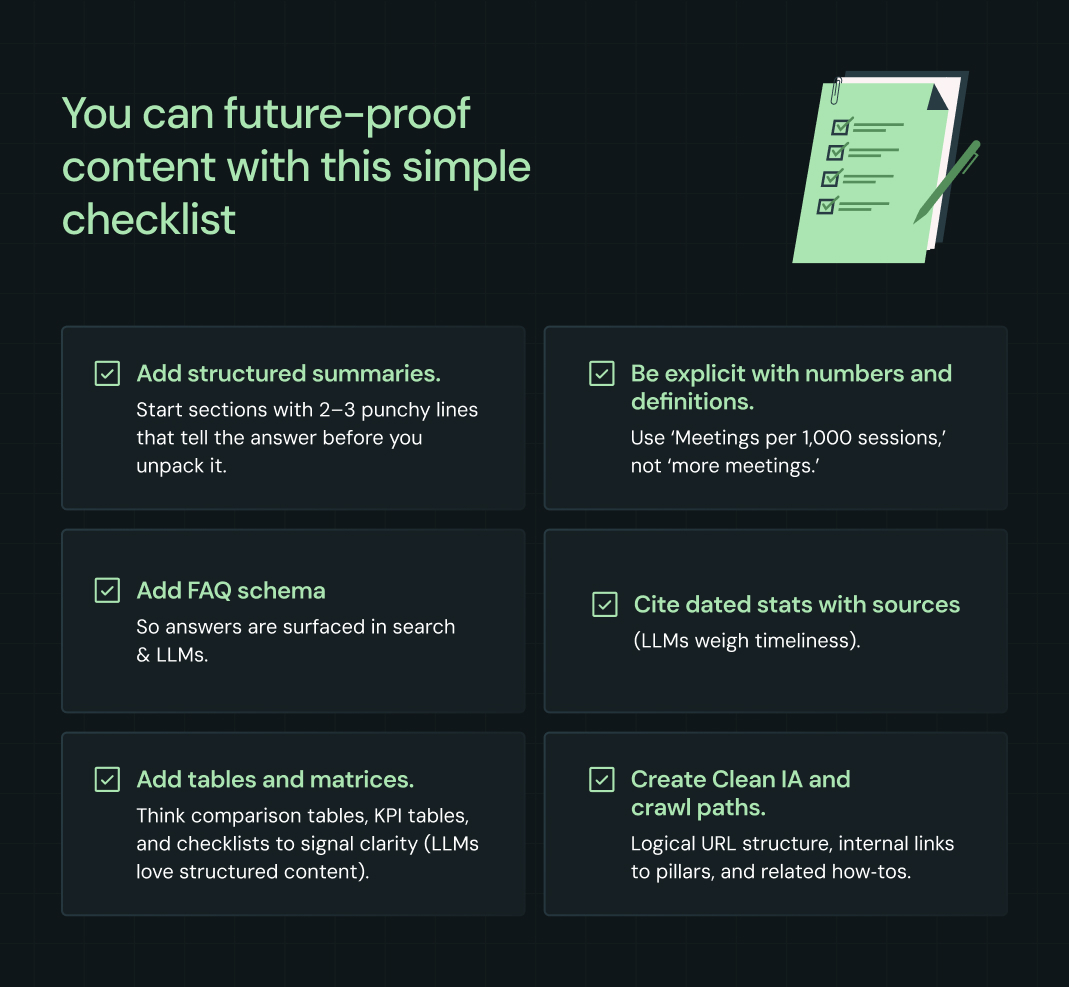
When your content is structured this way, you own the answers buyers see.
3 Common mistakes scaling teams make (and how to fix them)
Mistake 1: Copying competitors instead of creating your own website growth strategy
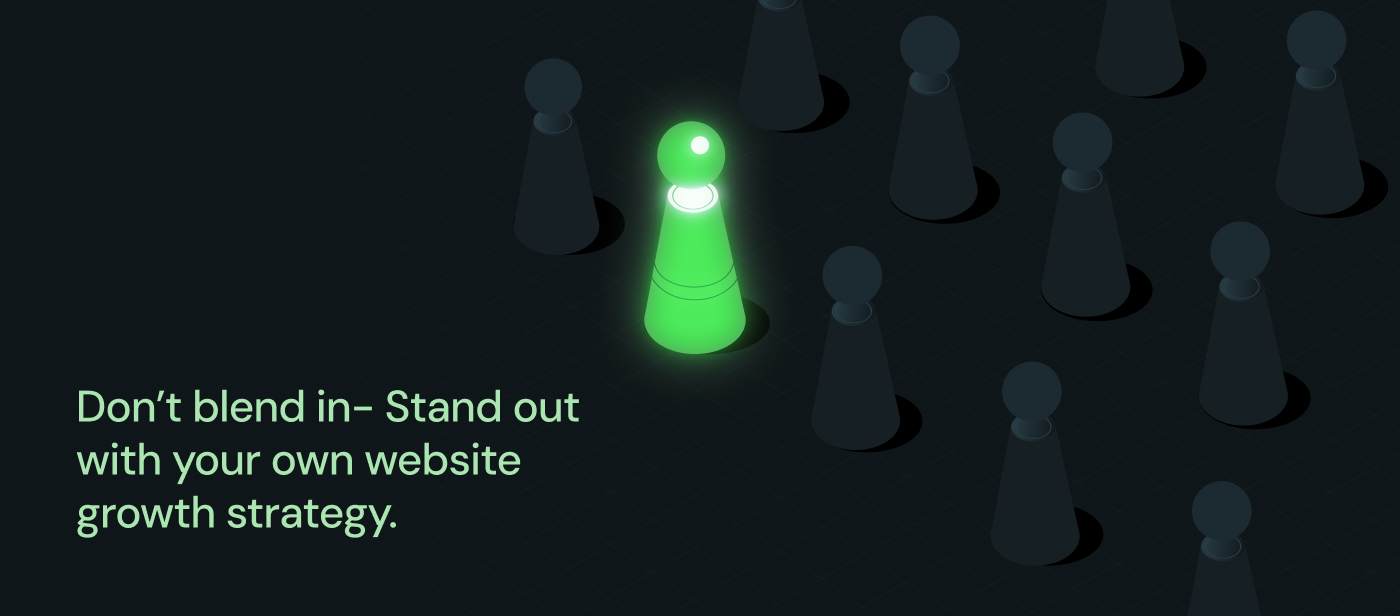
Many scaling teams assume that whatever their competitors are doing must be the best practice for B2B website growth. They mirror navigation, CTAs, and even messaging, hoping to shortcut their way to growth.
Now we understand why. Imitation feels safer than innovation. It’s easier to justify “they’re doing it, so we should too” than to invest in a differentiated approach.
The result?
You end up with a generic website that blends into the category. Buyers can’t see how you’re different, and your pipeline stagnates.
How to fix this?
Learn from competitor positioning, but don’t copy it wholesale. Instead, identify gaps: Are their CTAs all demo-heavy? Introduce a trial or ROI calculator. Do they bury proof? Make it prominent. Build your own strategic website growth playbook based on your ICP and differentiation.
Also read: A Complete Guide to B2B Web Design Best Practices
Mistake 2: Over-engineering forms while ignoring offer quality
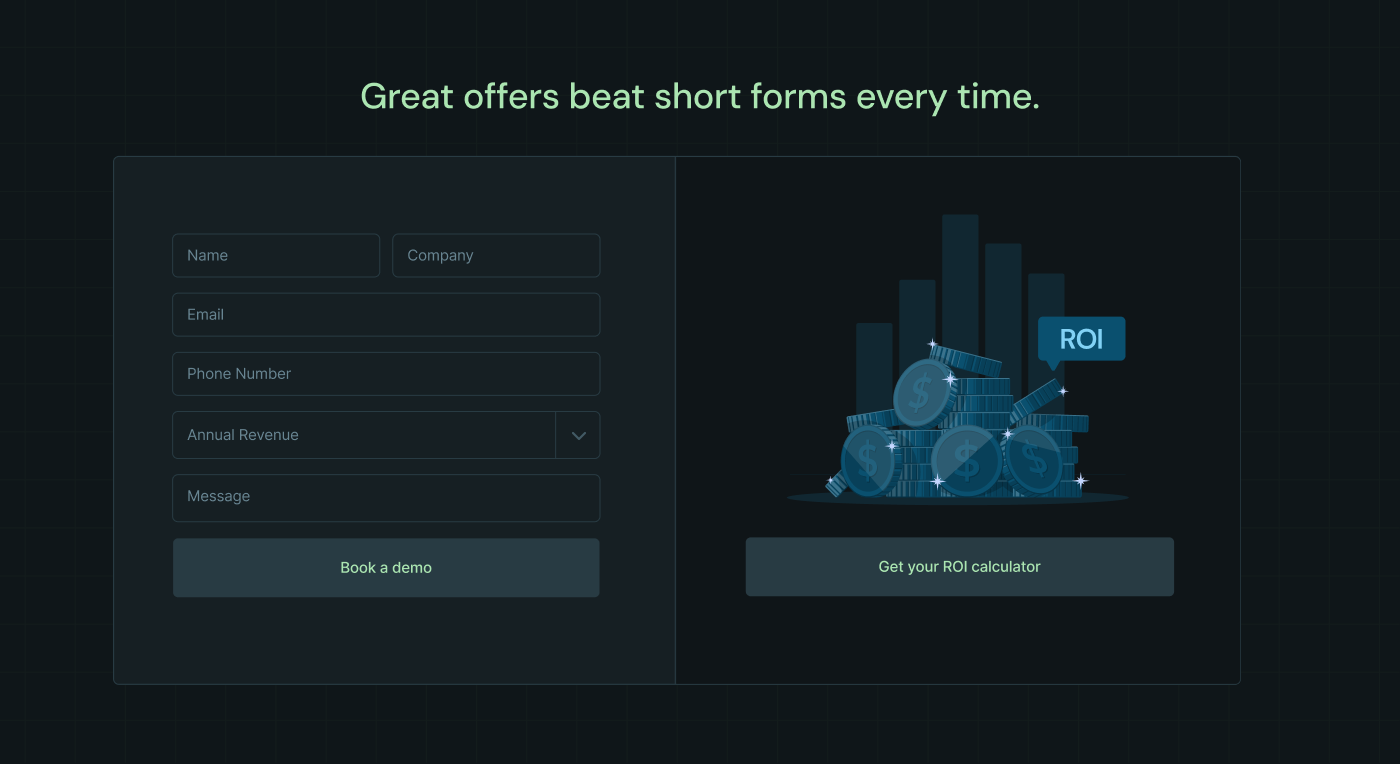
We have seen teams debate endlessly whether 3 or 6 fields convert better. Most often, the form isn’t the bottleneck; the offer leading to it is.
The reason is simple. Forms are visible and easy to tweak. Offers (ROI calculators, demos, trials) require deeper cross-team alignment and dev resources.
How to fix this?
- Test offers, not just forms. Example A/B: ROI Calculator (5 fields) vs. Generic Demo Request (3 fields).
- Apply friction-type testing: ask only high-signal fields (company size, role), enrich the rest via lead enrichment tools.
- Measure the form start rate separately from the completion rate. If people aren’t even starting, it’s an offer problem, not a form problem.
Mistake 3: Misaligning website journeys with sales follow-up
A prospect reads your competitor comparison page, fills out a form, then gets a generic SDR email: “Would you like to book a demo?”
Can you imagine their frustration? They feel like they’re restarting the conversation instead of continuing it. They drop off!
Only 3 in 10 salespeople say their sales and marketing teams work in sync. At ThunderClap, our clients often tell us that sales often don’t have visibility into which page triggered the lead.
How to fix this?
- Push page-level lead source data into CRM. SDR sees not just ‘inbound form fill’ but ‘from pricing page.’
- Train SDRs/AEs to open with context: “I noticed you were comparing us to Competitor X. Here’s how we stack up.”
- Create content-aligned cadences: if the lead came from a security page, follow-up includes SOC 2/ISO materials.
This single change (acknowledging context) turns cold inbound handoffs into warm, relevant conversations.
Mistake 4: Launching without a website growth operating cadence
Website revamps are exciting (because they are often long overdue). But we have seen teams often treat it like a marketing campaign: intense work pre-launch, celebration at launch, then back to business as usual!
Ownership of the website post-launch is fuzzy. Product marketing, demand gen, and web teams assume someone else is iterating.
Within 6–12 months, the site drifts out of sync with ICP and GTM motions. Meanwhile, your competitors update messaging quarterly.
How to fix this?
Establish a website growth operating cadence (even before you launch). This is what we recommend to our clients at ThunderClap:
- Weekly: micro A/B tests (CTA copy, button placement).
- Monthly: KPI review segmented by funnel stage.
- Quarterly: UX audit + competitor refresh.
- Annually: website strategy realignment (not just design overhaul).
{{specficService}}
Pro Tip:
One helpful metric that bypasses every internal objection to create a growth cadence is to track meetings per 1,000 sessions every month. If it dips below the target, trigger a CRO sprint.
Ready to execute this B2B website growth strategy? (with a DIY weekly plan)
By now, you’ve seen what it takes to turn a B2B website into a true pipeline engine. The real challenge is execution.
To make it easier, we’ve put together a free resource: Your 30-Day Website-to-Pipeline Plan, a step-by-step playbook to help you put this strategy into action right away.

At ThunderClap, we partner with mid-market and enterprise B2B brands to deliver more than just design. We transform websites end-to-end with:
- Premium service & high-quality design that brings clarity to your product.
- B2B expertise powered by a dedicated PMM team that understands complex buying journeys.
- Strategic processes & timely delivery that ensure every project runs with precision.
- A data-driven, result-oriented approach that goes beyond visual vanity.
- A proven portfolio with brands like Amazon, Razorpay, Storylane, Z47, and ClearlyRated.
- A partnership mindset acting as an extension of your team to align every page with your growth goals.
Or, if you’d prefer hands-on support, book a free consultation and see how we can help you increase leads by 50% and engagement by 60%.
{{ctaBlock}}
FAQs
What is a B2B website growth strategy?
A B2B website growth strategy is a plan to attract ICP traffic and convert it into a pipeline—defined by BoFU content, a clear offer ladder, proof where it matters, and a fast handoff to sales. It’s measured by meetings, SQLs, opportunities, and revenue.
Why do B2B websites struggle to generate leads?
B2B websites overinvest in TOFU content, rely on generic CTAs (“Contact Us”), hide proof, respond slowly to inbound leads, or design for aesthetics instead of pipeline. Add in ICP misalignment, and traffic never translates to SQLs.
What KPIs should I track to measure website growth?
To measure website growth, you should focus on the pipeline math:
- Sessions → CTA clicks (2–5%)
- CTA → Form start (40–70%)
- Form start → Meeting booked (30–60%)
- Meetings → SQL (30–0%)
- SQL → Closed/Won (15–30%)
Also track speed-to-first-touch (<5 min) and meetings per 1,000 sessions.
How can I increase traffic to my B2B website?
To increase traffic to your B2B website: Add BoFU pages first: pricing, competitor alternatives, comparisons, integrations, and security. Layer intent-driven campaigns on top. But traffic only matters if every path connects to instant scheduling and fast follow-up (speed-to-lead is 100× more likely to qualify).


Interested in seeing what we can do for your website?














